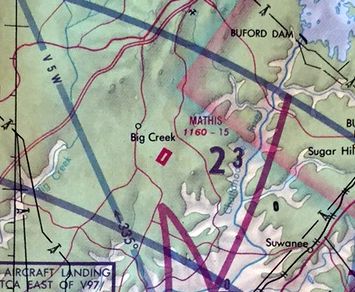
Abandoned & Little-Known Airfields:
Georgia: Atlanta area
© 2002, © 2016 by Paul Freeman. Revised 9/5/16.
This site covers airfields in all 50 states: Click here for the site's main menu.
____________________________________________________
Please consider a financial contribution to support the continued growth & operation of this site.
Bellah Field (revised 12/7/14) - Bishop Airfield (added 9/28/13) - Carrollton Municipal (revised 7/13/15) - Cline Ranch Strip (added 3/13/14)
Coles Airfield (revised 9/5/14) - Gunn Airfield (revised 7/13/16) - Mathis Airport / Mathis Field (revised 5/1/16) - Morris AAF (revised 9/5/16)
Parkaire Field (revised 9/8/15) - South Expressway Airport (revised 9/5/16) - Stone Mountain Britt Memorial (revised 11/13/14)
____________________________________________________
Mathis Airport / Mathis Field (GA27), Suwanee, GA
34.1, -84.162 (Northeast of Atlanta, GA)

Mathis Airport, as depicted on the 1978-79 GA Aeronautical Chart (courtesy of David Stevenson).
A 1955 aerial view did not yet depict any airfield at this location.
According to Wikipedia, “L.G. Mathis founded Mathis Airport in 1959 as a privately-owned / public-use airport.”
The earliest depiction which has been located of Mathis Airport was a 1963 aerial view,
which depicted it as having a single unpaved northeast/southwest runway, with 1 row of hangars & 1 light single-engine plane on the east side.
The earliest aeronautical chart depiction which has been located of Mathis Airport was on the 1978-79 GA Aeronautical Chart (courtesy of David Stevenson),
which depicted Mathis as a public-use airport having a single 1,500' paved northeast/southwest runway.
According to Wikipedia, “In 1979 L.G. Mathis & Patrick McLaughlin began Mathis Airpark as a fly-in residential community adjacent to the airport.”
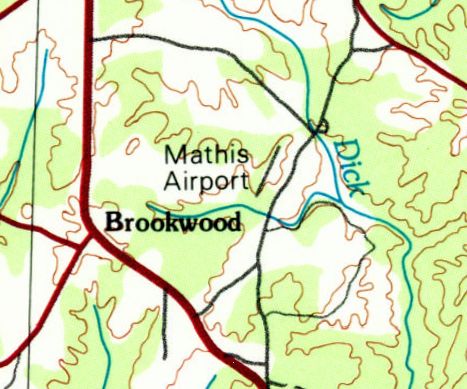
The earliest topo map depiction which has been located of Mathis Airport was on the 1981 USGS topo map,
which depicted it as having a single northeast/southwest runway.
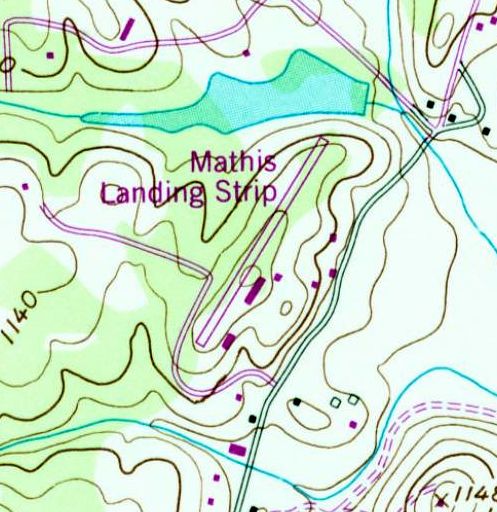
The 1985 USGS topo map depicted “Mathis Landing Strip” as having a single northeast/southwest runway,
with several small buildings on the east side,
According to Wikipedia, “In 1985 L.G. Mathis sold half of the airport to his brother, C.J.
In 1990 C.J. Mathis bought the remaining half of the airport.
In 1992 C.J. sold the airport to 7 Oaks, LLC.”
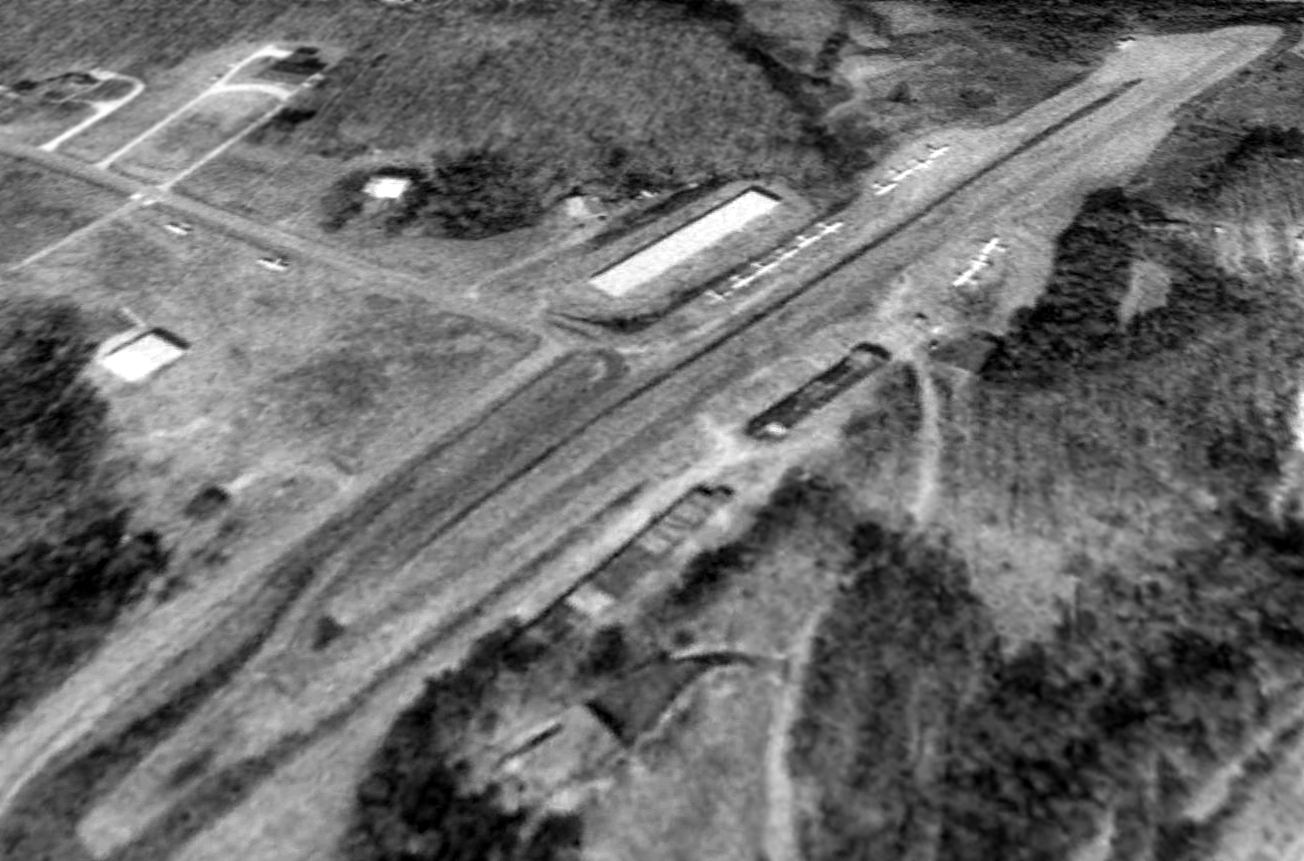
The earliest photo which is available of Mathis Airport was a 1993 USGS aerial view looking northwest.
It depicted a total of 15 light single-engine aircraft parked on the airport.
According to Wikipedia, “In 1995, 7 Oaks LLC sold the airport back to C.J. Mathis.”
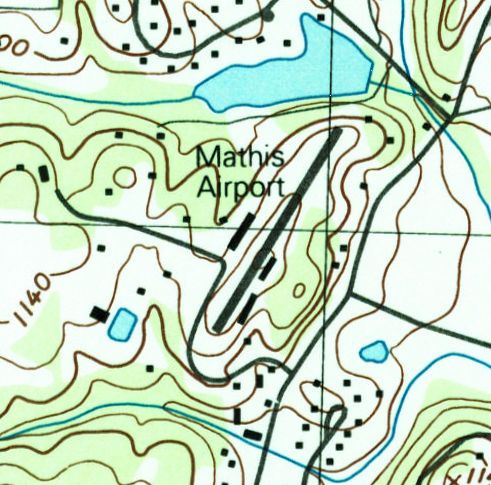
The 1999 USGS topo map depicted Mathis Airport as having a single northeast/southwest runway,
with several rows of hangars on either side of the runway.
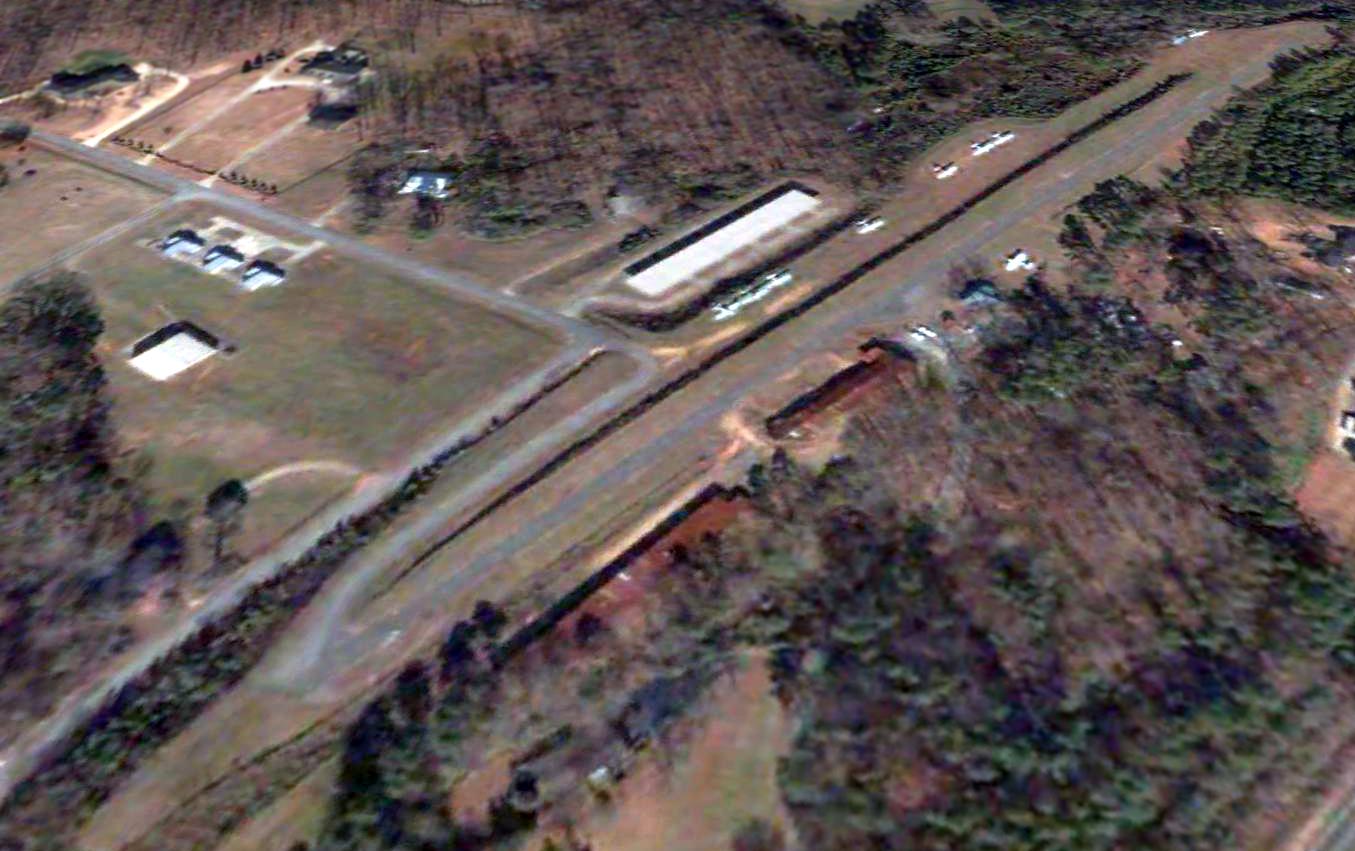
A 2004 aerial view looking northwest depicted a total of 10 light single-engine aircraft parked on either side of the Mathis Airport runway.
According to Wikipedia, “In June 2004 C.J. sold the airport (11 acres) and an adjacent subdivision lot (4 acres) in the airpark to Flyboy Aviation Properties LLC (Flyboy Aviation).
In 2004, Flyboy Aviation expanded the airport in many ways: tore down the original wooden hangars & cinder-block FBO,
added 17 new metal T-hangars, built a new club house, widened & lengthened the asphalt runway, asphalted taxiways & hangar aprons.
From 2004-2009, Mathis was home to Experimental Aircraft Association Chapter 1415,
but in 2009 this chapter moved to Air Acres airport in Woodstock, GA.”
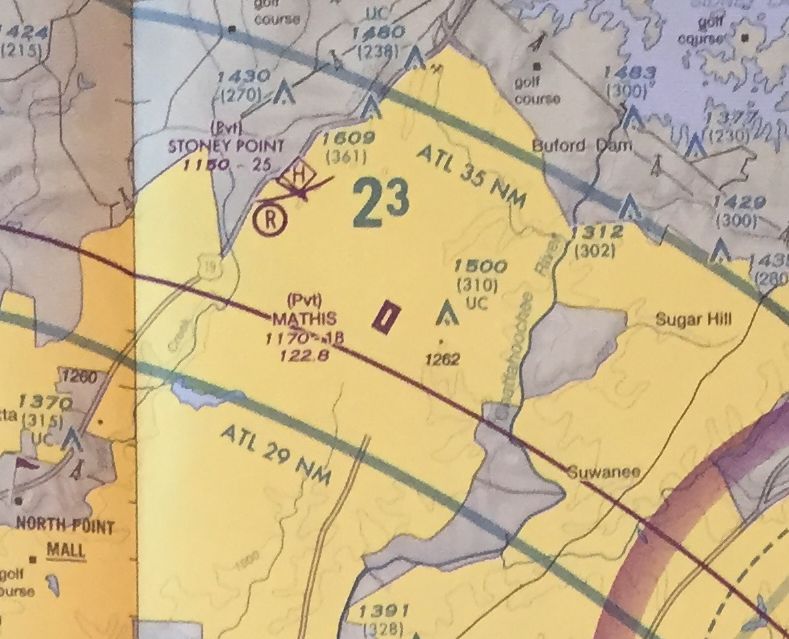
The last aeronautical chart depiction which has been located of Mathis Airport
was on the March 2009 Atlanta Terminal Aeronautical Chart.
It depicted Mathis as a private airfield having a single paved northeast/southwest runway.
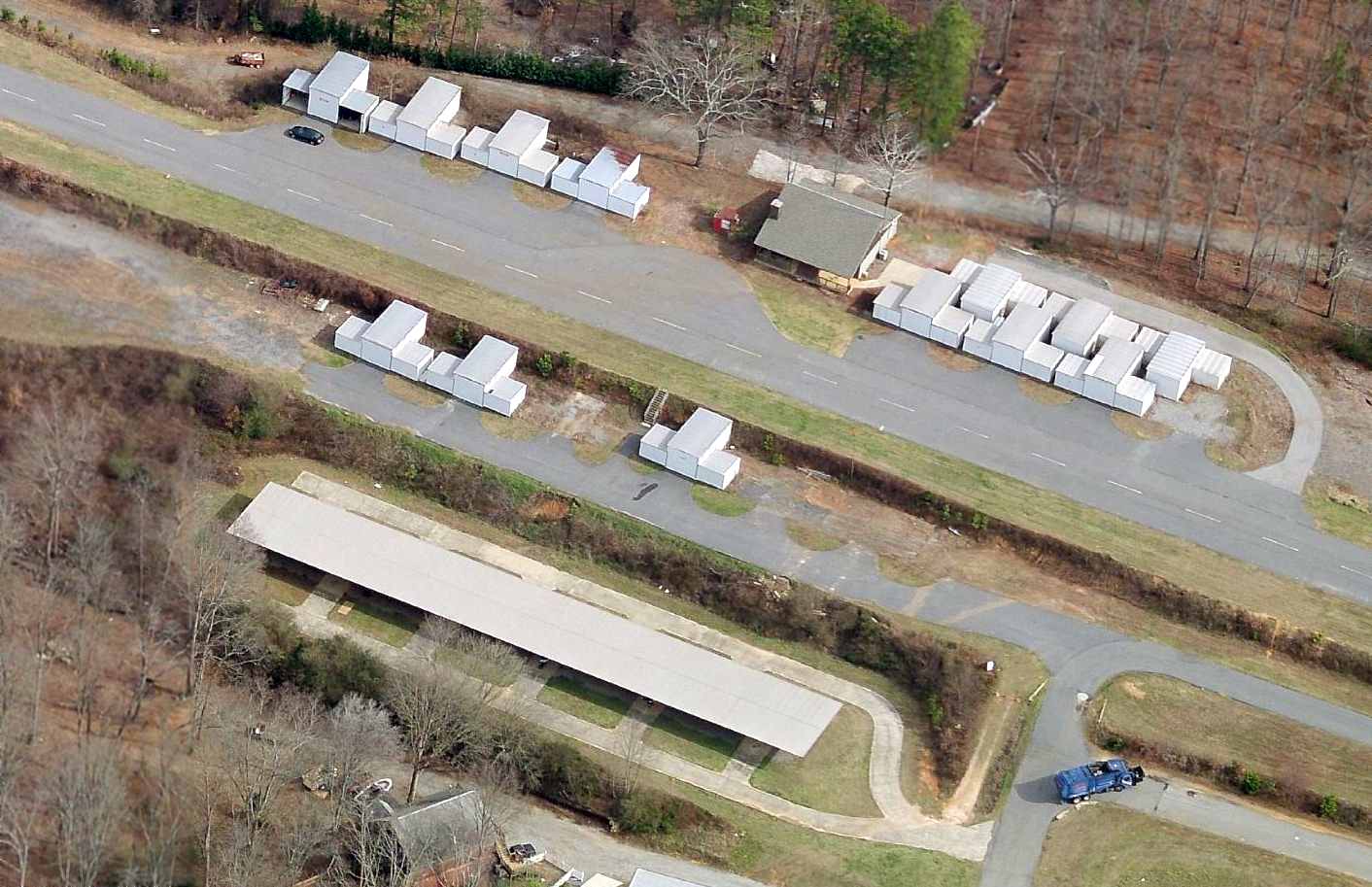
A circa 2010 aerial view looking east showed a considerable number of T-hangars at Mathis Airport, but no aircraft.
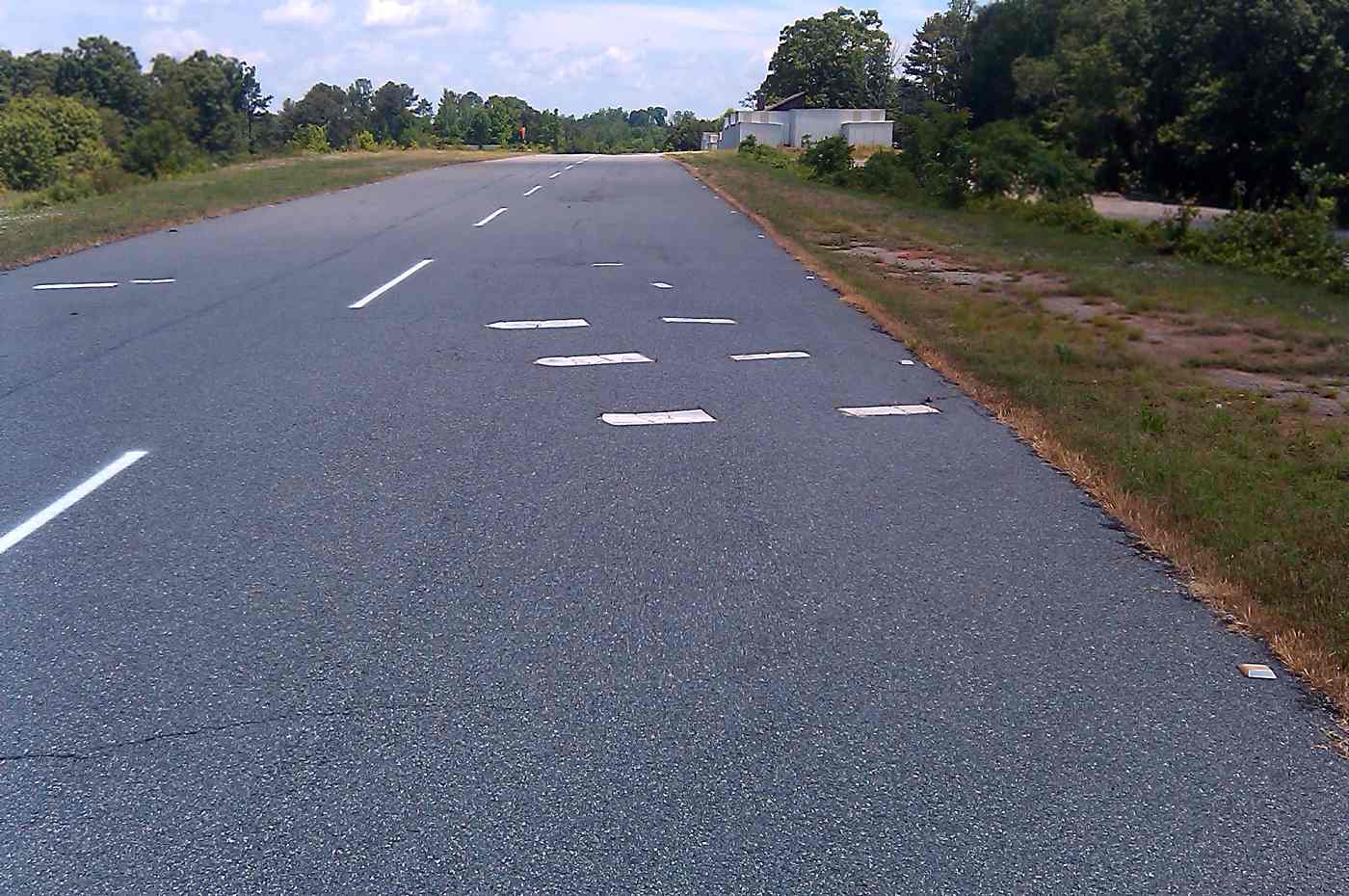
A 2013 photo looking along Mathis Airport's runway, showing perhaps a unique feature – headstones for graves which were flush with the runways surface.
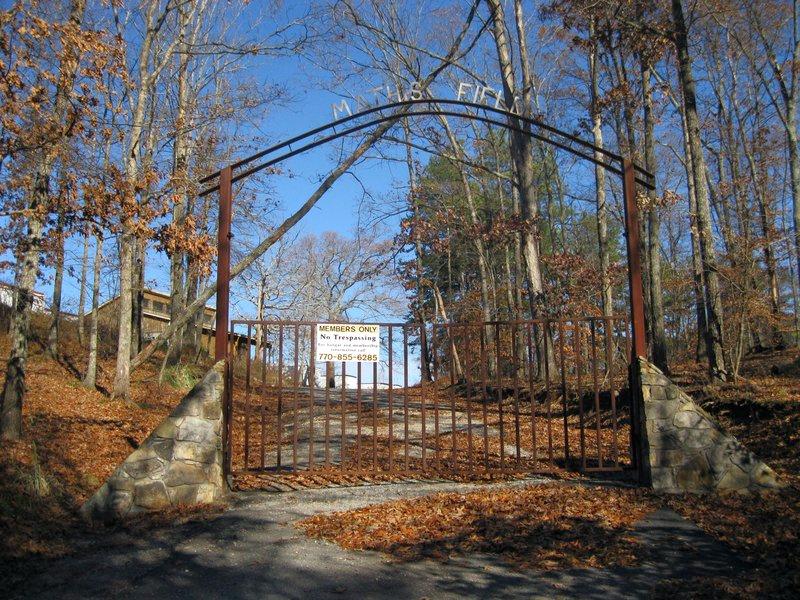
A circa 2014 photo of the entrance gate to Mathis Field.
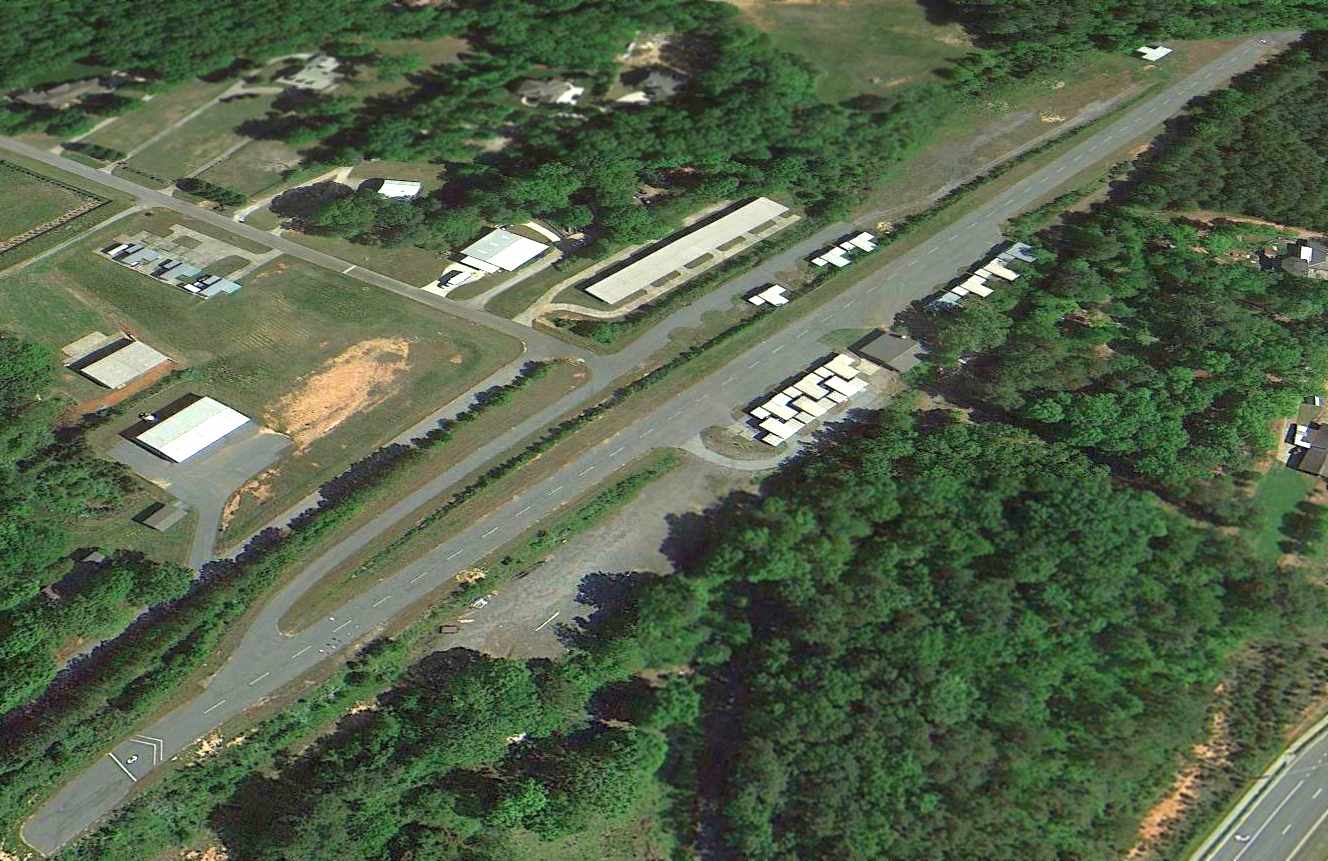
A 2014 aerial view looking northwest showed Mathis Airport remained intact, though devoid of aircraft.
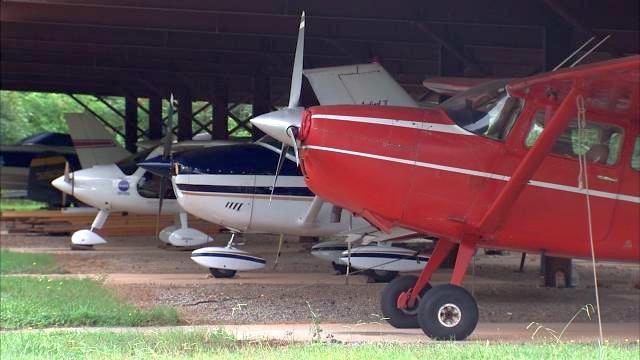
A circa 2014 photo of several planes under a shade hangar at Mathis Airport.
According to its FAA Airport/Facility Directory data, Mathis Airport had an 1,800' asphalt Runway 3/21, and consisted of 11 acres.
According to Wikipedia, “In October 2014 the airport was closed, all hangars [to be] removed & the land [to] be converted to built houses on the property.”
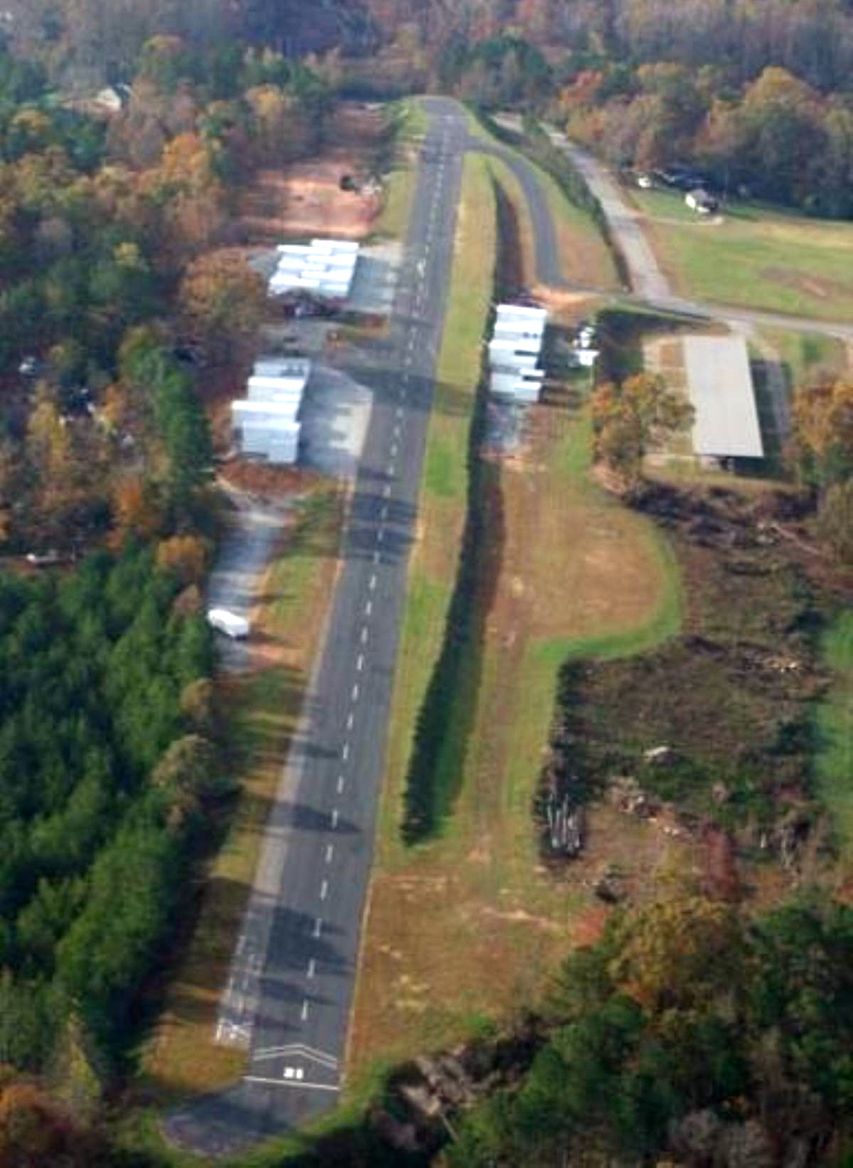
An undated (2015 or earlier) aerial view looking south along the Mathis Airport runway.
Marc Obensahin reported in 2015, “The property is terraced; Mr. Mathis had to do some work to get that runway in there. And it's not a lot.
A coworker said he went up there, years ago, so his son could see the planes & asked someone he met if they gave flight lessons.
The guy said this wasn't the kind of place [where] you wanted to learn to fly.”
Chet Myerson used a UAV on 5/25/15 to record the scene at Mathis Airpark, showing that most of the hangars have been removed,
and yellow closed-runway “X” symbols painted on the runway.
Chet reported, “For 40+ years & a ton of aviation heritage, Mathis Airport in Forsyth County is no more!
The land developers finally got it. In it's heyday (early 2000) it became a member club aerodrome & I flew in there often my the light sport aircraft we were representing.
Soon to be a subdivision, here is a last look at some real aviation history.”
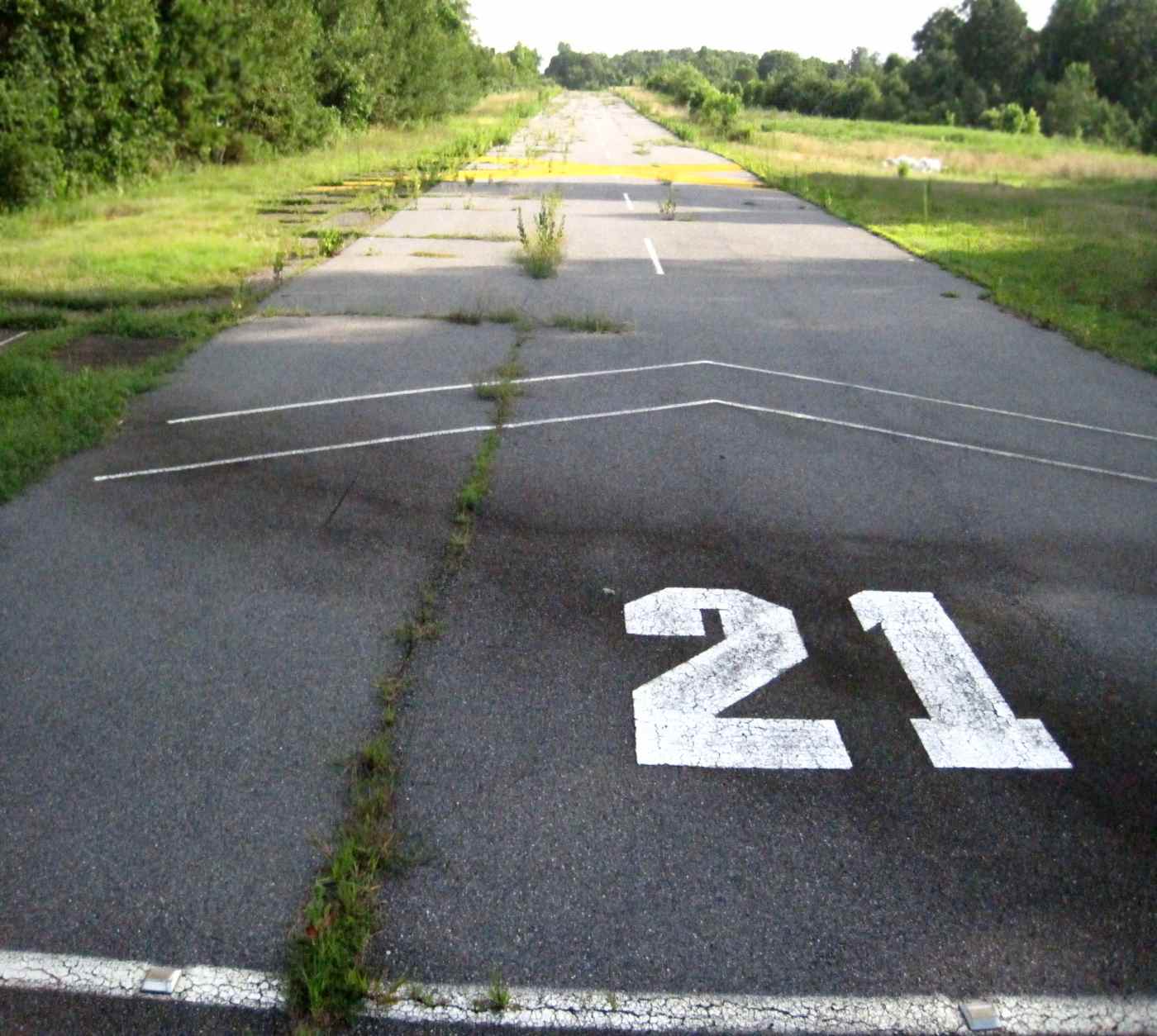
A 7/5/15 photo by Marc Obenshain looking south along Mathis Airport's Runway 21.
Marc observed, “This leaves Forsyth county with a couple of private grass strips, which I'm sure our hyper-development trend will eventually push out, as well.”
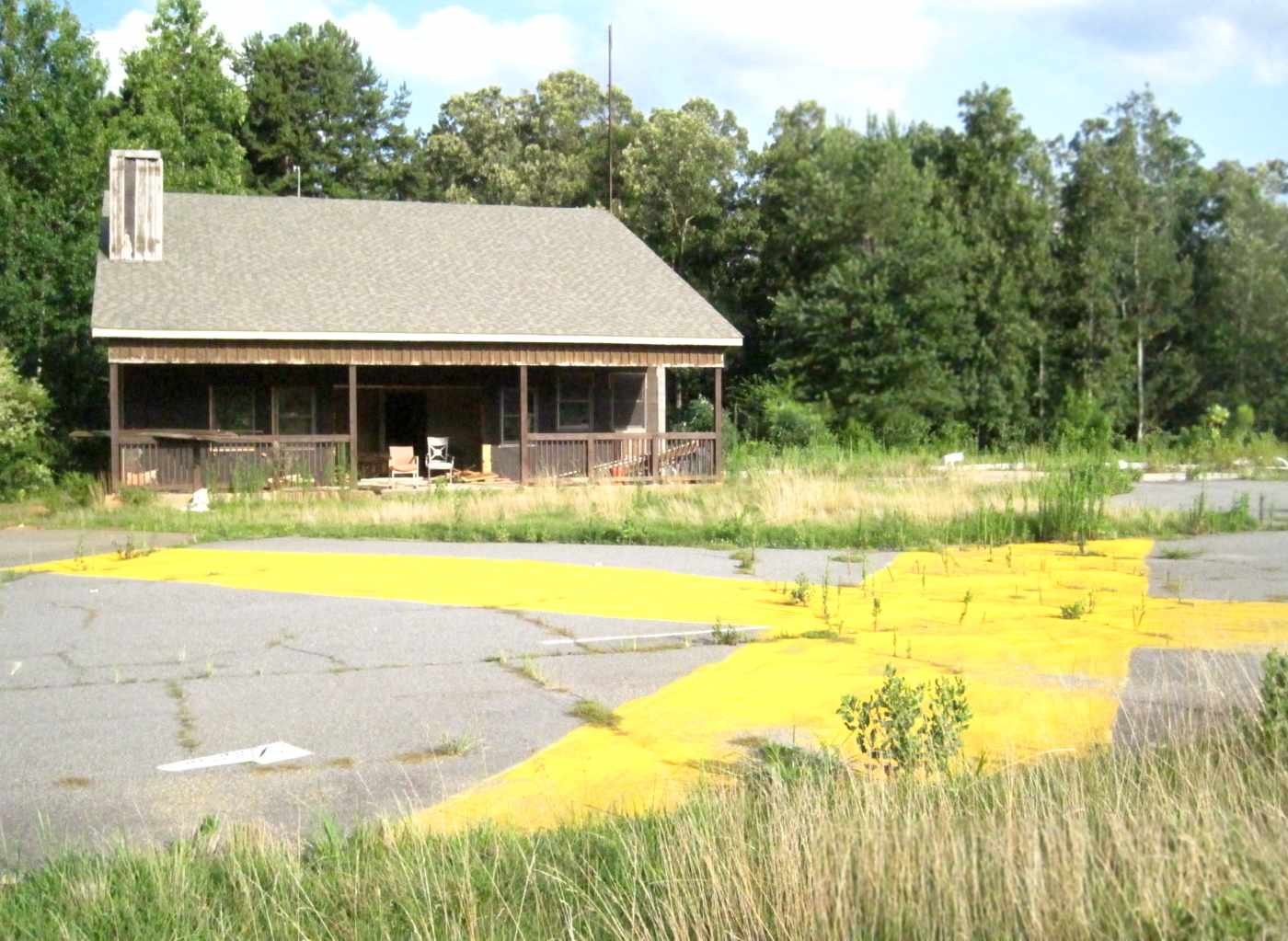
A 7/5/15 photo by Marc Obenshain of the former Mathis Airport clubhouse, with the closed-runway “X” symbol in the foreground.
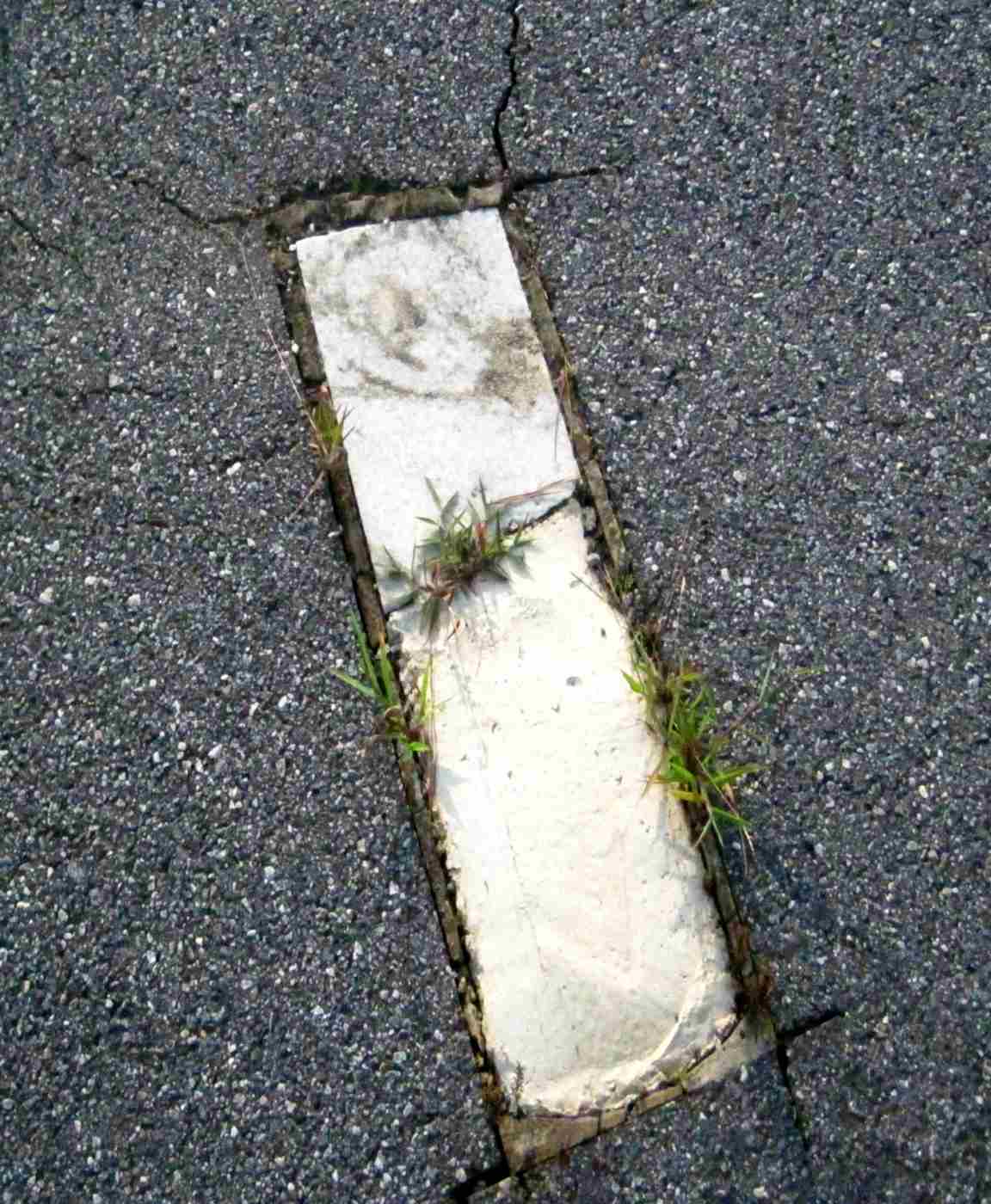
A 7/5/15 photo by Marc Obenshain of Mathis Airport's most unique feature – a grave marker embedded in the runway.
Marc observed this is the “most Northern grave marker - no markings, half missing, half filled with concrete.”
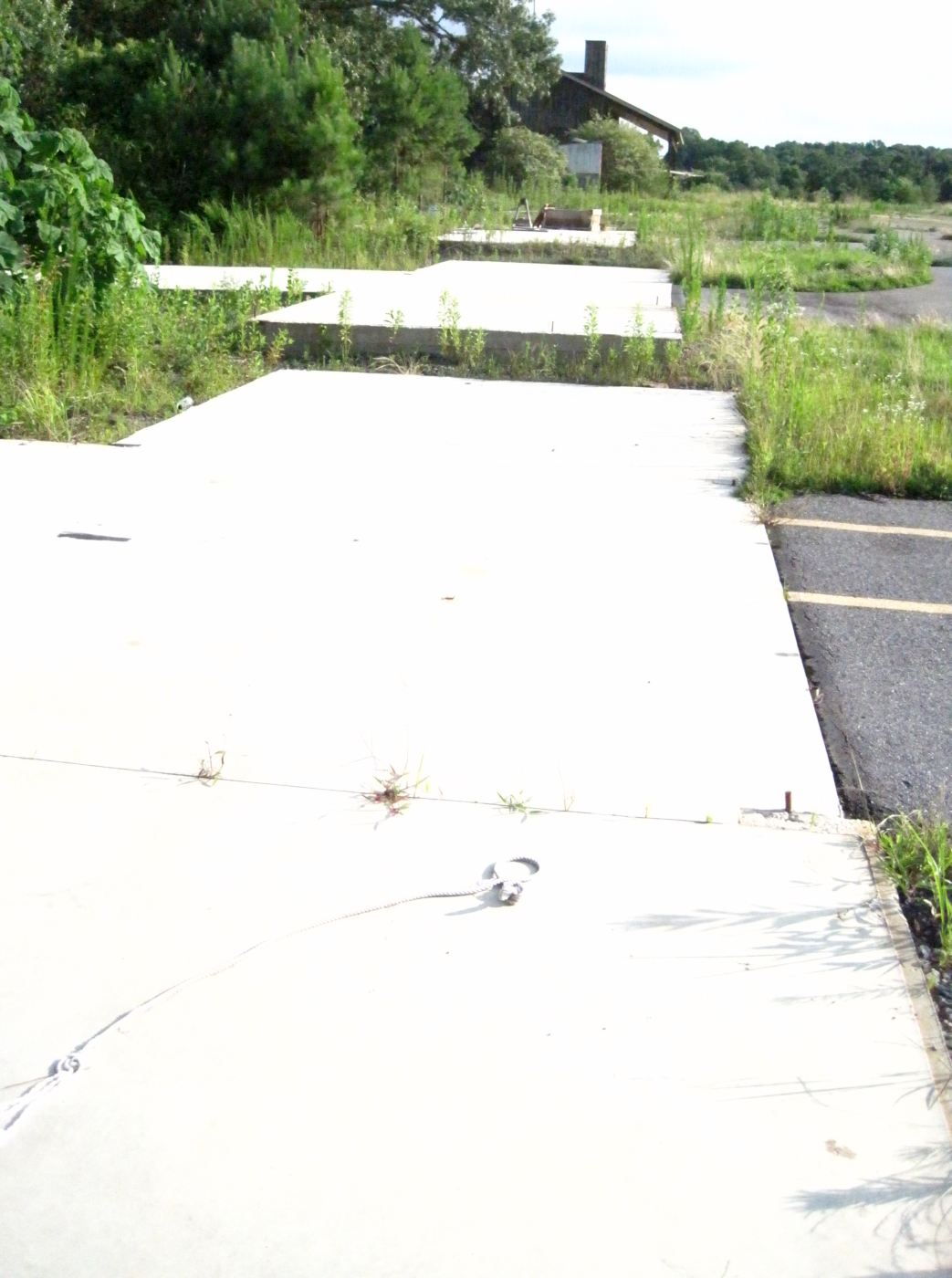
A 7/5/15 photo by Marc Obenshain of Mathis Airport, “Facing South over T-hangar foundations to the North side of the clubhouse.”
Mathis Airport is located at the northern terminus of Mathis Airport Drive.
Thanks to Marc Obenshain for pointing out this airfield.
____________________________________________________
Cline Ranch Strip (GA81), Social Circle, GA
33.618, -83.782 (East of Atlanta, GA)
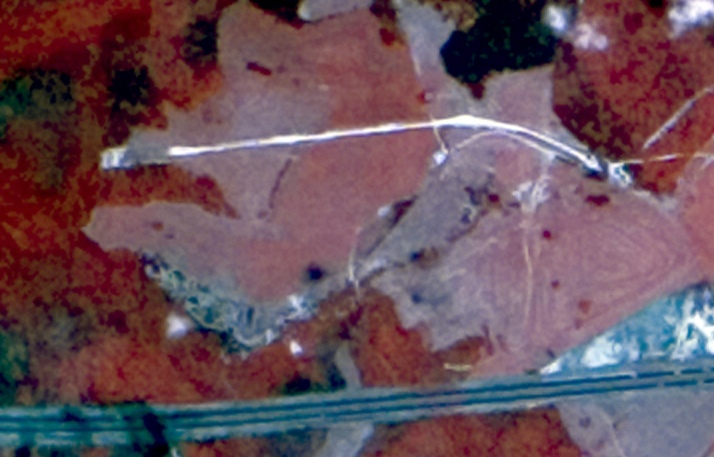
A 1974 infrared aerial photo of Cline Ranch Strip (courtesy of David Henderson).
David Henderson reported, “Cline Ranch Strip was a private grass airstrip located between Covington & Social Circle, about 35 miles east of Atlanta.
The single runway airfield was evidently constructed between 1966-74 as a 1966 topo map shows no sign of an airstrip
while a 1974 infrared aerial clearly shows the runway.
It appears as a white stripe north of Interstate I-20.”
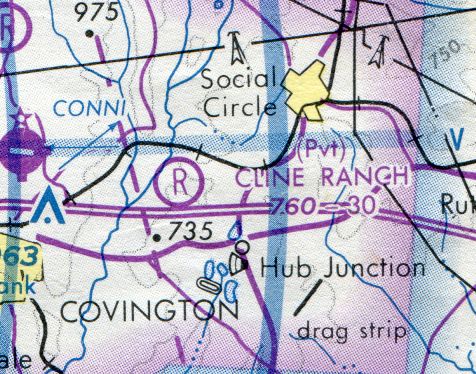
The earliest aeronautical chart depiction which has been located of Cline Ranch Strip was on the 1978 Atlanta Sectional Chart (courtesy of David Henderson).
It depicted Cline Ranch as a private airfield having a 3,000' unpaved runway.
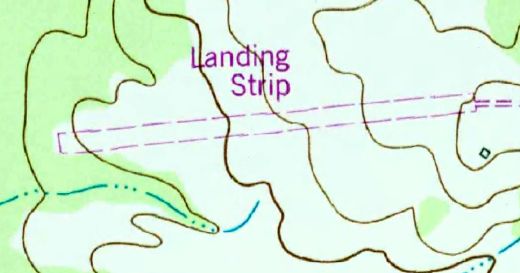
The 1986 USGS topo map depicted Cline Ranch Strip as a single unpaved east/west runway, labeled simply as “Landing Strip”.
David Henderson reported, “In a 2/12/88 aerial photo, the runway appears as an extension of the road leading to the airport.
A building that may have served as a hangar is just south of the field.”
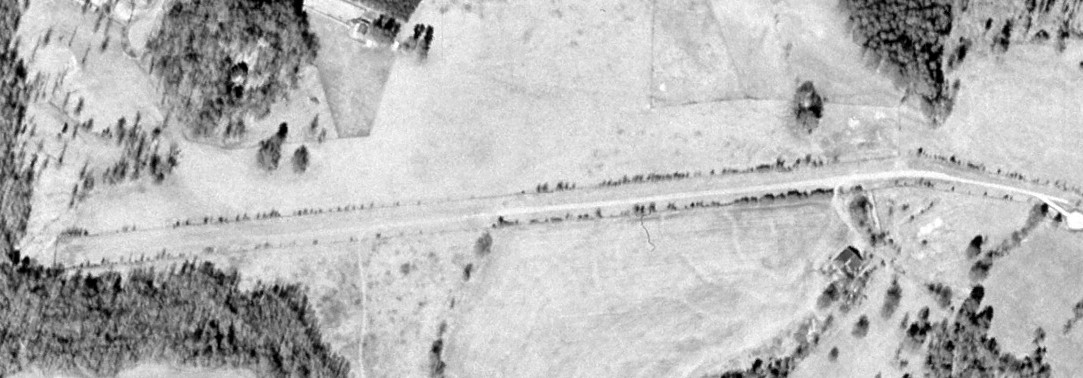
The last photo which has been located showing Cline Ranch Strip still relatively intact was a 2000 aerial view (courtesy of David Henderson).
David Henderson observed, “Trees were beginning to sprout along the runway edges. The runway still appeared to be in good condition.”
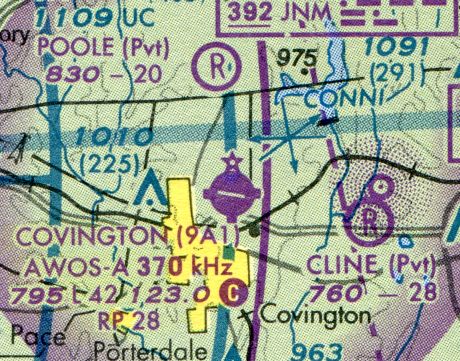
The last aeronautical chart depiction which has been located of Cline Ranch Strip was on the September 2003 Atlanta Sectional Chart (courtesy of David Henderson).
David Henderson observed, it depicted “the runway length as 2,800', down from 3,000' on the 1978 chart.”
David Henderson reported, “By 2005 [an aerial photo showed] the airport was being transformed into the River Cove subdivision with single family houses on multi-acre lots.”
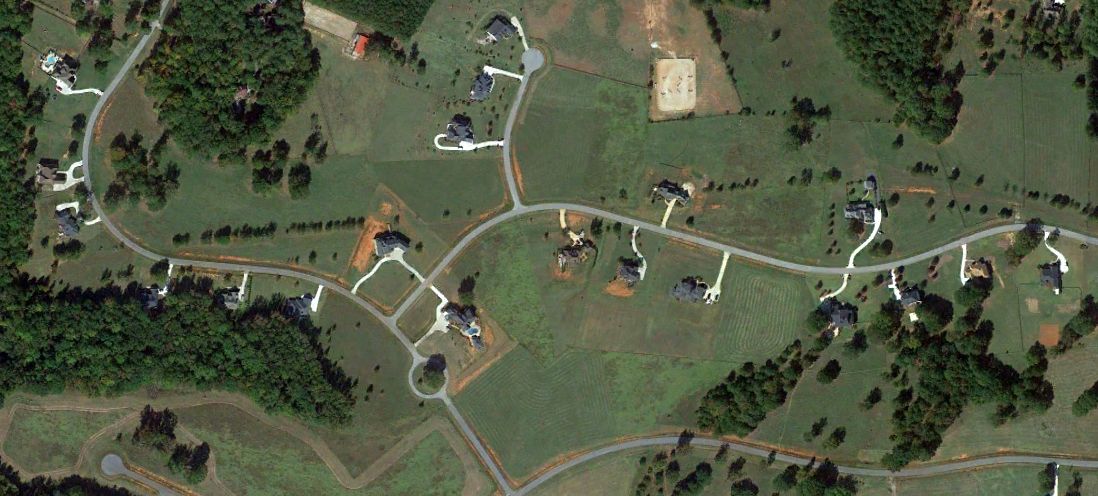
A 2011 aerial view (courtesy of David Henderson) showed that houses covered the site of Cline Ranch Strip,
but the alignment of the runway was still barely recognizable.
The site of Cline Ranch Strip is located at the intersection of River Cove Road & River Cove Meadows.
____________________________________________________
Bishop Airfield, Fayetteville, GA
33.446, -84.406 (South of Atlanta, GA)

A 1968 aerial photo (courtesy of David Henderson) depicted Bishop Airfield.
This small private airfield was evidently built at some point between 1965-68,
as it was not yet depicted on a 1965 aerial photo (according to David Henderson).
Bishop Airfield was not yet depicted on the October 1968 Birmingham Sectional Chart.
The earliest photo which has been located of Bishop Airfield was a 1968 aerial view (courtesy of David Henderson).
David Henderson remarked, “The 1968 photo shows a single unpaved east/west runway with 3 light aircraft at the northeast corner of the field.
One of the planes appears to be missing a wing.”
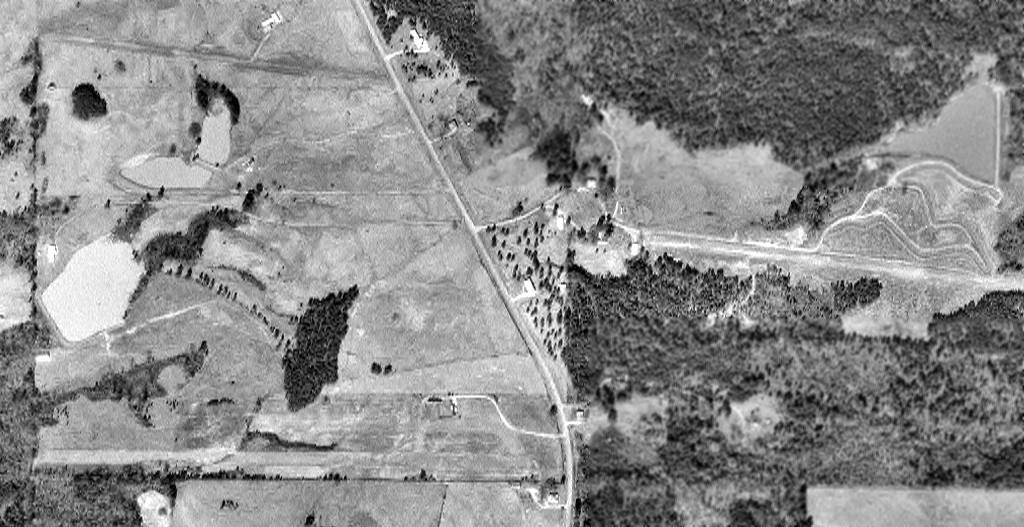
A 1971 aerial photo (courtesy of David Henderson) depicted Bishop Airfield.
David Henderson remarked, “It was obviously a popular neighborhood with pilots:
three private airstrips are seen within a half-mile of each other. Bishop is at bottom left.”
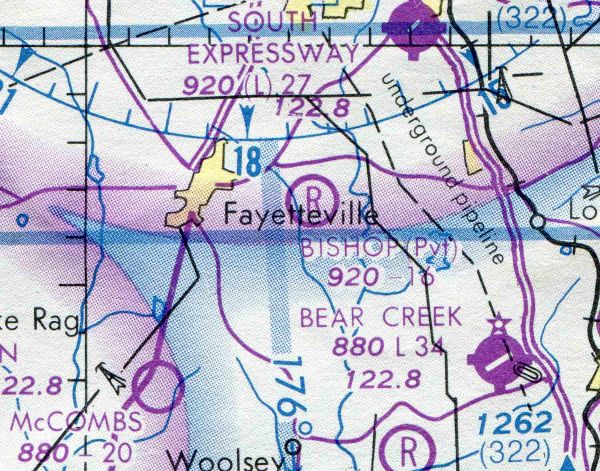
The only aeronautical chart depiction which has been located of Bishop Airfield was on the 1978 Atlanta Sectional Chart (courtesy of David Henderson).
It depicted Bishop as a private airfield with a 1,600' unpaved runway.
Three light aircraft could be seen at Bishop Airfield on an 1978 aerial photo (courtesy of David Henderson).
Bishop Airfield was not depicted on the 1979 USGS topo map.

The last photo which has been located depicting an aircraft at Bishop Airfield was a 1/26/93 aerial photo (courtesy of David Henderson),
which depicted one single-engine aircraft.
A 1999 aerial photo showed the airfield remained intact, but no aircraft were visible on the field.
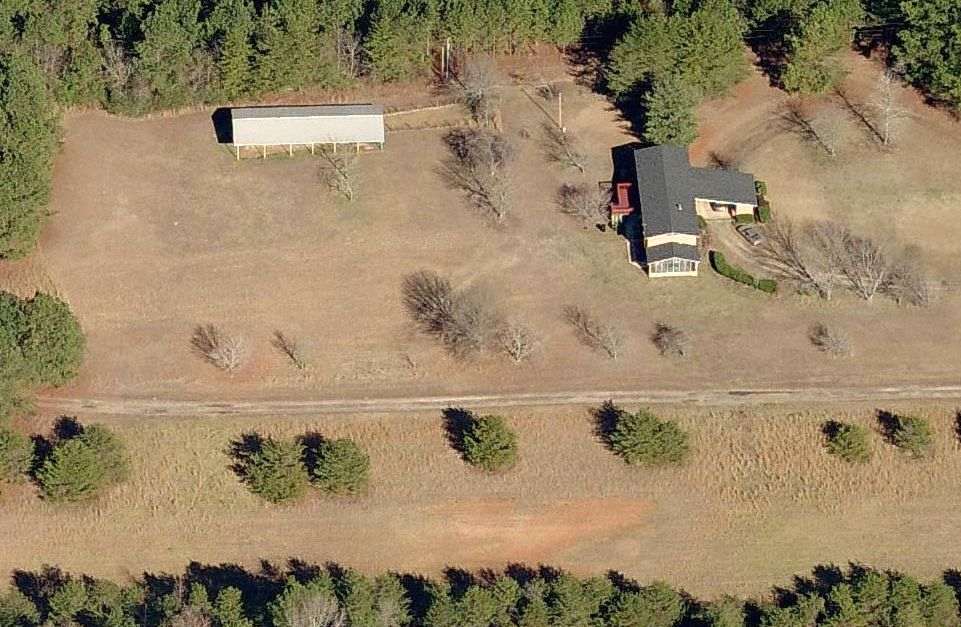
A circa 2005 aerial view looking north (courtesy of David Henderson).
David remarked, the photo “shows the runway still in good condition although there was no evidence that it was still being used as an airfield.”
A 2006 aerial photo showed the airfield remained intact.
David Henderson reported, “Construction of a new subdivision on the site of Bishop airfield began in 2007 with a road built parallel to the former runway.
I presume the development fell victim to the real estate crash because work on the site stopped after the road was built.”
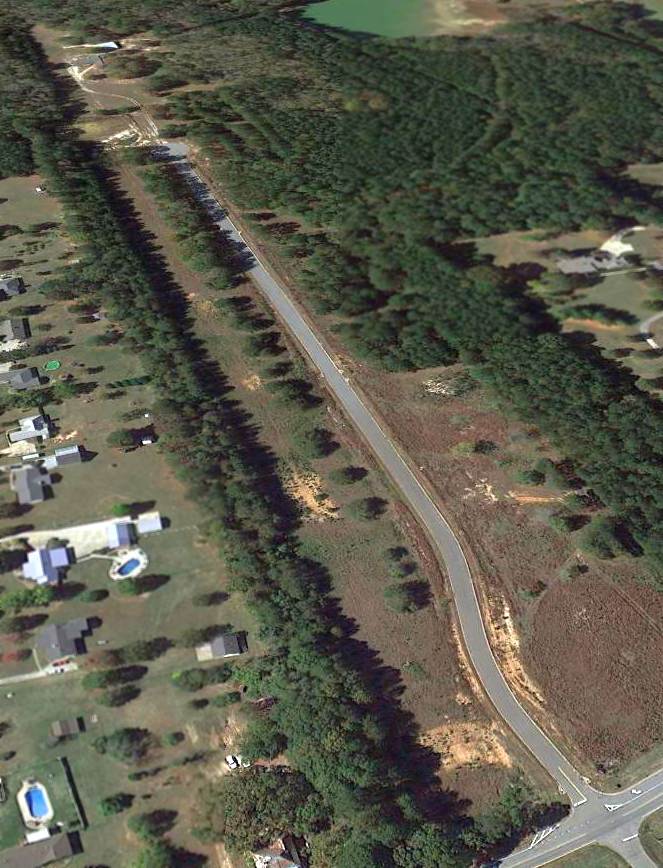
A 10/31/12 aerial view looking northwest at the site of Bishop Airfield.
What a shame – a nice little airfield is abandoned for housing construction that doesn't happen.
David Henderson reported in 2013, “Today the runway is still clearly visible.”
The site of Bishop Airfield is located west of the intersection of County Line Road & County Line Court.
____________________________________________________
Cole Field / Coles Airfield, Stockbridge, GA
33.623, -84.26 (Southeast of Atlanta, GA)
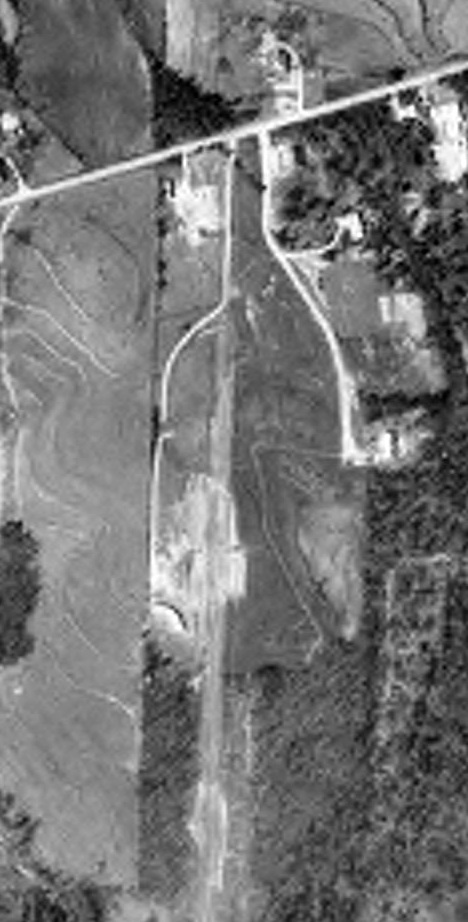
A 3/9/66 USDA aerial photo (courtesy of David Henderson) depicted Coles Airfield
as having a single north/south unpaved runway with an unusual curved building along the west side.
David Henderson recalled, “Coles Airport was a private airfield located in Henry County, near Stockbridge.
A 1962 USGS aerial shows the area as farmland.”
Blake Blomquist recalled, “Ed Cole lived at & owned the tract where 'Cole Field' was located.
He told me that his father had an old D-9 bulldozer & he held a compass in his hand
as he drove the old Cat from north to south to scratch out the beginnings of the strip known as 'Cole Field'.”
According to David Henderson, “The strip is clearly visible in a 3/9/66 USDA aerial photo.
The airport had a single 2,100' north/south grass runway
and was located about 9 miles directly east of Atlanta Hartsfield-Jackson Airport & 3.5 miles east of the old Ft. Gillem Airport.
One of the distinguishing features in the airport photos is the semi-circular building (house?) with a zig-zag roofline adjacent to the runway.”
Coles Airport was not yet depicted on the October 1968 Birmingham Sectional Chart.
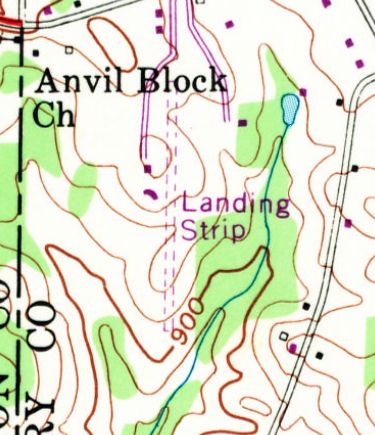
The 1968 USGS topo map depicted a single unpaved north/south runway, labeled simply as “Landing strip”,
with 2 small buildings along the west side.
David Henderson recalled, “The airport is shown as 'Private landing strip' on a 1978 Atlanta street atlas.”
A 1978 aerial photo showed the airfield configuration remained unchanged.
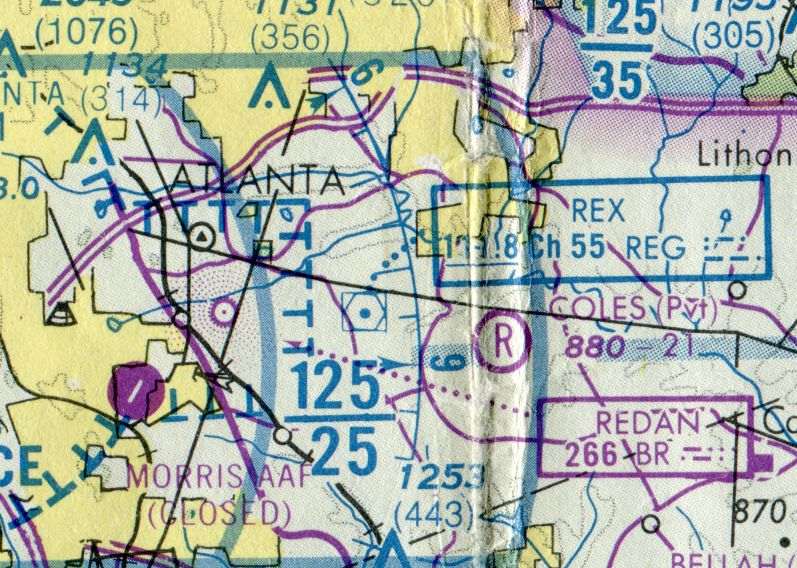
The only aeronautical chart depiction which has been located of Coles Airfield was on the 1978 Atlanta Sectional Chart (courtesy of David Henderson).
It depicted Coles as a private airfield with a 2,100' unpaved runway.
A 1988 aerial photo showed that a hangar had been added at some point between 1978-88 nested adjacent to the semi-circular structure.
David Henderson recalled, “The airport was still clearly visible in a 1993 USGS aerial photo but the runway doesn't appear to have been mowed.
By 1999, the runway had largely disappeared beneath the trees.”
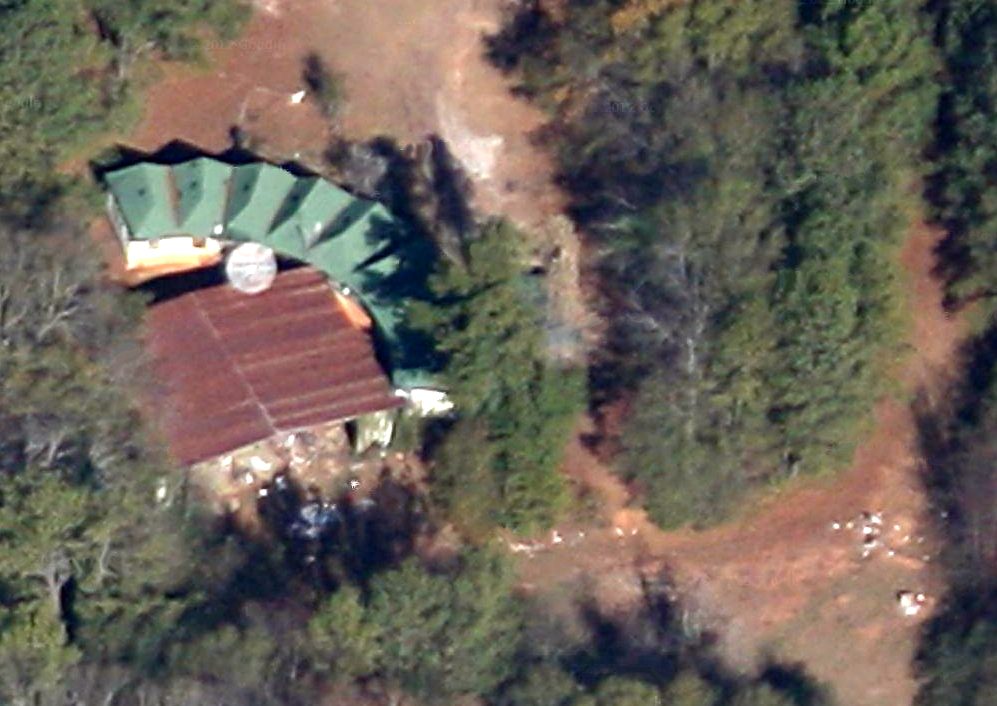
A circa 2012 aerial view looking west (courtesy of David Henderson).
David remarked, “The odd semi-circular building & hangar are still present.”
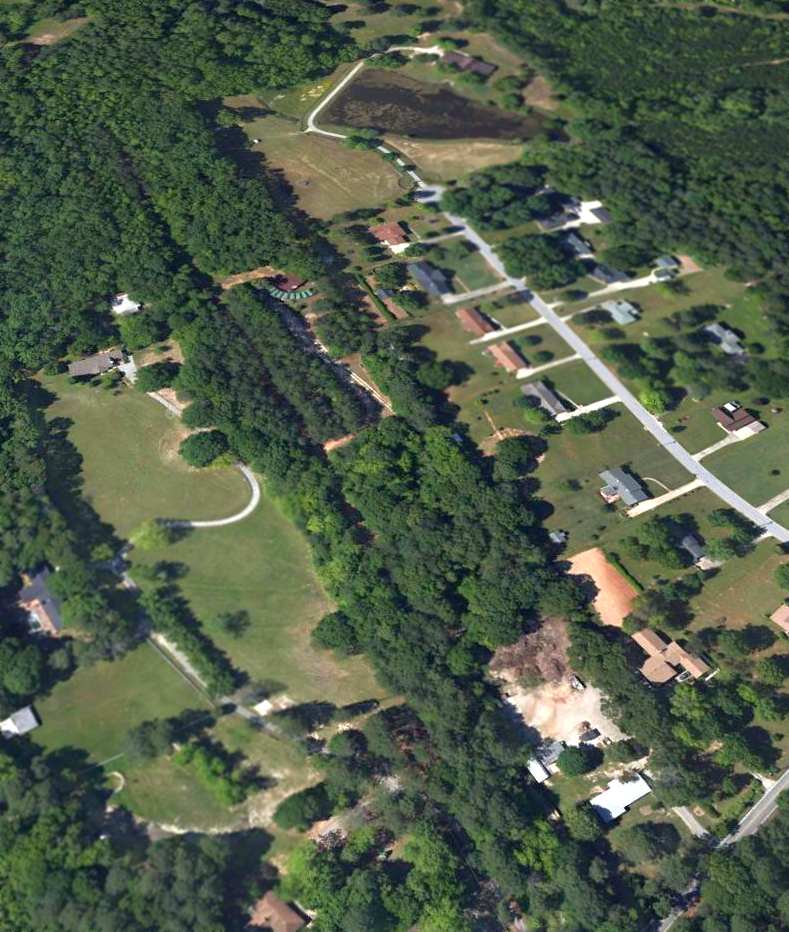
A 2/8/13 aerial view looking southwest at the site of Coles Airfield.
David Henderson observed, “It's easy to find the former runway in the recent aerial views...
It can be spotted by the straight line of pines in an otherwise mostly hardwood canopy.
It appears that the center of the runway is maintained as a private road.”
The site of Coles Airfield is located southwest of the intersection of Anvil Block Road & Fairview Road.
____________________________________________________
South Expressway Airport (9A7), Jonesboro, GA
33.505, -84.36 (South of Atlanta, GA)
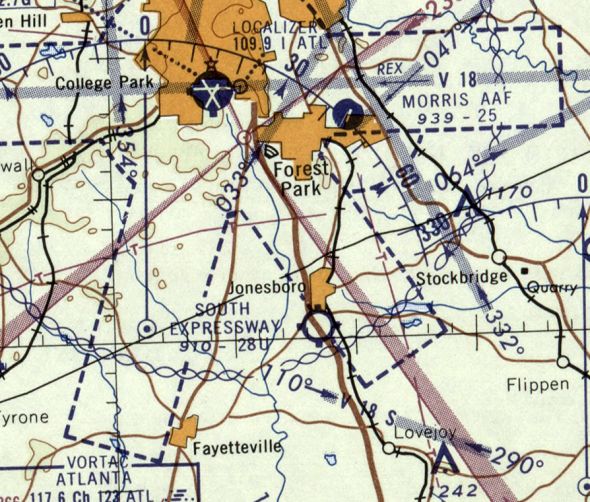
South Expressway Airport, as depicted on the February 1960 Birmingham Sectional Chart.
This general aviation airport was not yet depicted on the 1958 USGS topo map.
The origins of the field were described by Ed Bernd.
He recalled that airport owner-manager W.H. 'Bill' Galloway “has been flying forever.
He met up with a farmer who owned some land in Jonesboro,
and they went into a partnership on the airport.
Galloway & the farmer each owned 40% of the business, and their wives each owned 10%.
The idea was to have a grass strip, but they never could get grass to grow.
Before I showed up there, they had fertilized the runway to get grass to grow.
It rained & the wet fertilizer got throw all over the place very time a plane landed.
They had to wash every plan that landed during that time.
So they stuck with the dirt strip.”
According to the 1966 “Atlanta Metropolitan Region Comprehensive Plan” (courtesy of David Henderson),
“South Expressway Airport... was developed in the late 1950s.”
The earliest depiction which has been located of South Expressway Airport
was on the February 1960 Birmingham Sectional Chart.
It depicted South Expressway Airport as having a 2,800' unpaved runway.
Ed Bernd recalled of South Expressway Airport, “I first stopped at the field in October of 1960.
Just a single dirt strip about the length [2,600'], and talked with the owner-manager, W.H. 'Bill' Galloway.
I didn't take my first lesson that afternoon despite the great selling job that Bill Galloway did on me...
but I came back the next day.
He told me a 'secret' about the best time to learn to fly:
'Today, because that's the only time you can ever do it.'
I could hardly sleep that night.
The next day of course the weather was horrible.
The radio said wind gusts to 50 mph (perhaps they exaggerated somewhat).
It was very late afternoon by the time I got back over there.
By that time I was scared that he might not take me up because of the lateness & the weather.
But he was too good a salesman for that.
We climbed into his personal plane, a Cessna 140 complete with wheelpants, and I got my first lesson.”
Ed continued, “When I first went there, they owned 4 airplanes:
Galloway's personal Cessna 140; 2 Cessna 120's that were used to train students
(he never let me in his 140 again); and a Piper J3 Cub.
I don't know why they had the J3, but I finally talked them into checking me out in it & I loved it.”
Ed continued, “I got my private license on July 13, 1961.
Somewhere along the way I went to work at the airport, as a line boy.
Somehow it seemed better than being managing editor of our family newspaper.”
Ed continued, “When the Cessna 150 first came out, they bought one.
That might have been in late 1961, or it might have been 1962.
They sold one of the 120's, and then one of his flight instructors flipped the other 120 one day.
So all he had left was the 150 and the Cub, until he got the 120 fix.
Later they bought a Air Coupe - not the old Ercoupe with the controls tied together,
but a nice low wing airplane with a bubble canopy & a 90 hp engine... I loved to fly it.
He had about 3 flight instructors there as I recall.”
Ed Bernd recalled, “Finally they had a strip of asphalt laid over the dirt.
I'd guess that could have been 1962.
They had one hangar, on the south side of the airport, and one mechanic.
They tied down airplanes on both sides.
I remember at one time race driver Joe Weatherly hid his airplane way back at the back of the tiedown area for a couple of months
until he made enough money to get caught up on the payments.
It was an interesting layout: The airport was right up against the southern edge of the Atlanta control zone,
so we had to fly all our patterns on the south side of the airport.
At the east end of the runway was a 4-lane highway.
There were power lines, a fence, and the runway went downhill for the first few hundred feet.
It was a bit of a challenge to land that way.
After that first few hundred feet the runway leveled out.
At the west end, the ground dropped off again... and there was a big stand of tall Georgia pine trees.”
Ed continued, “Naturally we preferred to land uphill... heading east.
The wind would come down the runway, then across the area that had been cleared, and then hit those pines...
giving us a stiff updraft just before we got to the end of the runway.
We'd drop a ways (depending on how strong the wind was of course)
so we'd juice the throttle to keep from dropping to far, then settle down & land.”
Ed continued, “We had one really nice airplane based there, a Piper Cherokee.
It was the only plane they kept in the hangar.
One day the owner came in a little too low - landing downhill - and sat it down on the fence.
The fence posts punched holes in the wings, but didn't hurt them.
They hustled it into the hangar very quickly so nobody would know.
I was working there at the time & didn't even know about it for several days.”
Ed continued, “Like most businesses in the South back then,
they got the sign for the establishment from the Cocoa Cola company.
They would provide a big red sign with the big red Coca Cola log & big red letters that said 'Drink Coca Cola',
and leave you a little white space to put the name of your business.
I think all that he had there was the word 'Airport' in the biggest letters he could fit on there.
So we always loved to tease the Chief about his 'Cocoa Cola Airport'."
The earliest directory listing of South Expressway Airport which has been located was in the 1962 AOPA Airport Directory,
which described the field as having a single 2,600' paved Runway 6/24.
The operator was listed as South Expressway Airport Inc.
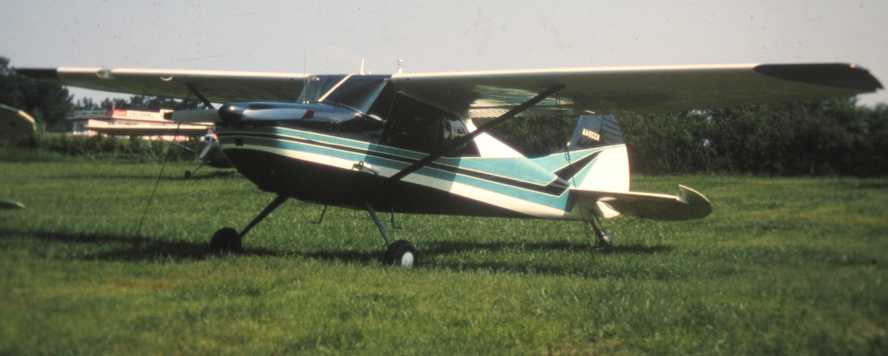
The earliest photo which has been located of South Expressway Airport
was a 1963 photo (courtesy of John Lipscomb) of John's father's Cessna 170.
The airport office is visible in the background.
David Bryan recalled, “My Dad learned to fly at South Expressway back in the late early 1960s
in an Aeronca Champ that belonged to the Hill Hoppers Flying Club, which had a lot of Delta Airlines people in it.
When he got his ticket he bought the Cessna 140 from Galloway & had the good fortune of having a good friend, Dick Borrelli who flew for Eastern.
Dick got hurt & was on leave, so they flew like maniacs off South Expressway for about 2 months obtaining Dad's licenses.
I fondly remember sitting on the hill (where they put the school in the late 1980s) watching him do touch & goes.
Dad was able to transition from maintenance to flying at Delta due to this.”
Dick Borrelli recalled, “I was just a friend of Gerald’s, doing him a favor. I didn’t charge him for the instruction.
The gentleman who owned the airport got really mad that Gerald wasn’t using one of his instructors
and put Gerald on a cash-only basis & refused to let him run a tab like everyone else. They were pretty nasty to him.
We went out every morning & flew from South Expressway – MCN – CSG - South Expressway
on a flight plan with multiple variations & then flew every approach to every airport we visited.
Every other day we reversed it. We always stopped in CSG to refuel & have lunch with his sister.
At the end of the summer he got his commercial & his instrument ratings & got hired a few months later by Delta. & retired as a Delta pilot.”
John Lipscomb recalled, “I grew up near the South Expressway Airport in the 1960s.
My father had a Cessna at the airport.
Later my dad bought a Piper Comanche from Mr. Galloway.
He missed the fun of the Cessna so much he sold the Piper & bought back the Cessna.
My Father was Bill Galloway’s doctor & Mr. Galloway lived across the street from us.
I remember going to the airport to fly with my father & I always remember Mr. Galloway fondly.
I remember Mr. Galloway used to take me to the airport with him in the summer time before I started elementary school.
I used to tell my mother I was going to work.
I’m sure she enjoyed someone taking a rambunctious little 6 year old off of her hands for a few hours.
The airport office was a small building with model airplanes hanging from the ceiling.
I provided the Sopwith Camel biplane model to the collection.
This was also the first place I learned to put peanuts in my bottle of Coke.
Mr. Galloway was teaching me the southern traditions every little boy needs to learn.
One of the ways Mr. Galloway made money was to take aerial photos.
I can still remember going up with him during those times.
I bet I logged just as many hours as he did during those summer days.”
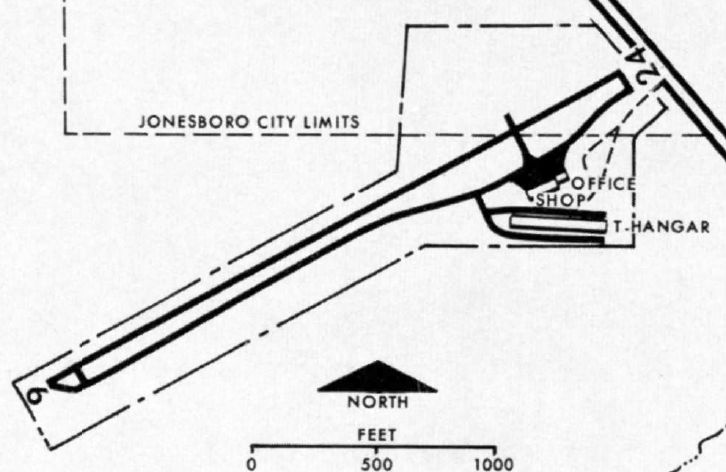
The 1966 “Atlanta Metropolitan Region Comprehensive Plan” (courtesy of David Henderson)
depicted South Expressway Airport as having a single Runway 6/24,
with an office, shop, and T-hangar on the southeast side.
The 1966 “Atlanta Metropolitan Region Comprehensive Plan” (courtesy of David Henderson)
described South Expressway Airport as the “Busiest privately-owned general aviation field in the metropolitan area.
The 50-acre airport site fronts on U.S. Highways 19 and 41, a major regional thoroughfare,
about 6 miles south of its interchange with Interstate 75.
The most heavily developed & rapidly growing part of Clayton County extends northward from Jonesboro,
and the area around the airport is still relatively open; however, almost all of the development in its immediate vicinity has occurred during the past 10 years.
Despite the relative absence of suburban encroachment, there appears to be little possibility for a large scale expansion of the airport.
A highway is immediately to the east, and westward extension of the runway would require substantial fill & a culvert or bridge to cross Swamp Creek
and the adjoining marshy areas (which are 1,000' or more in breadth & up to 40' lower than the end of the runway).
The runway already runs downhill in this direction, with approximately 35' difference in elevation between its highest & lowest points.
It is 2,700' long & 150' wide, turf, with pavement 30' wideband is equipped with medium intensity runway lights, operated from dusk to 9PM (later on request).
The field is attended from 8:30AM-9PM. There are underground tanks for storage of aviation gasoline, with a capacity of 3,980 gallons.”
The 1966 “Atlanta Metropolitan Region Comprehensive Plan” (courtesy of David Henderson) continued,
“These general aviation facilities & services are provided:
Major & minor repair to power plant, airframe, radio & accessories, Aircraft services: painting, stripping, washing, waxing,
Aircraft storage: hangar 6 spaces, T-hangars 10 spaces, ramp 46 spaces, tie-down 80 spaces,
Aircraft for lease - 2 planes, charter - 6 planes, rental - 9 planes, air taxi - 3 planes, sight-seeing - 2 planes,
Sales of new & used aircraft, accessories, radio, instruments.
Ground school & flight instruction for all ratings except glider & helicopter flying: Instructors – 6, Aircraft – 10,
Aerial photography (color, black & white).
In 1965, the following general aviation aircraft were reported based at the airport: single-engine 1-3 places (68);
single-engine, 4 or more places (34); multi-engine (6).”
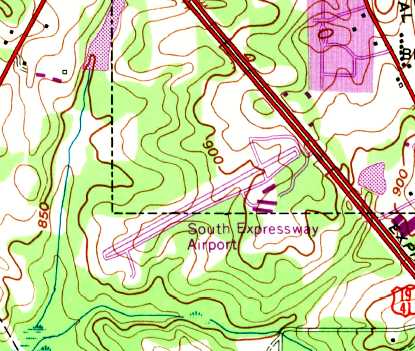
The earliest topo map depiction which has been located of South Expressway Airport was on the 1968 USGS topo map.
It depicted the field as having a paved northeast/southwest runway with a parallel taxiway,
and several buildings on the southeast side.
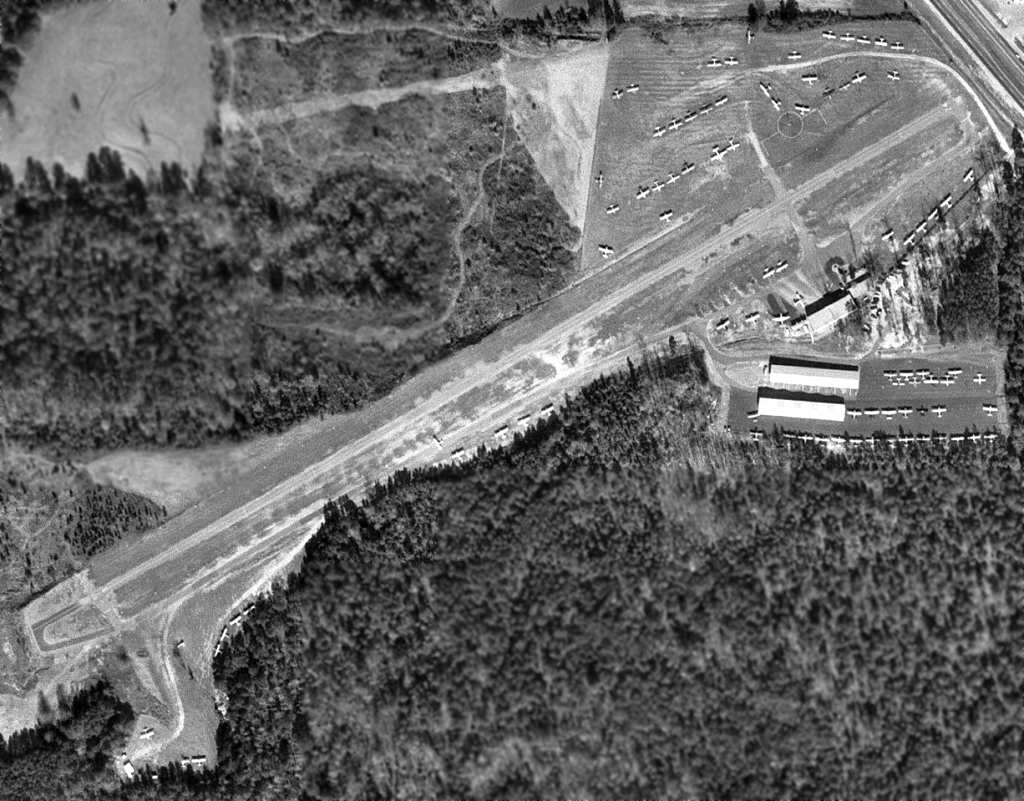
The earliest aerial photo which has been located of South Expressway Airport was a 1968 USGS aerial view (courtesy of David Henderson).
It depicted a very popular general aviation airport, with nearly 100 light aircraft parked all around the field.
The 1968 Flight Guide (courtesy of Robert Levittan) depicted the South Expressway Airport
as having a single 2,700' paved Runway 6/24.
A parallel taxiway on the south side of the runway led to 2 ramps,
along which were 3 buildings (hangars?).
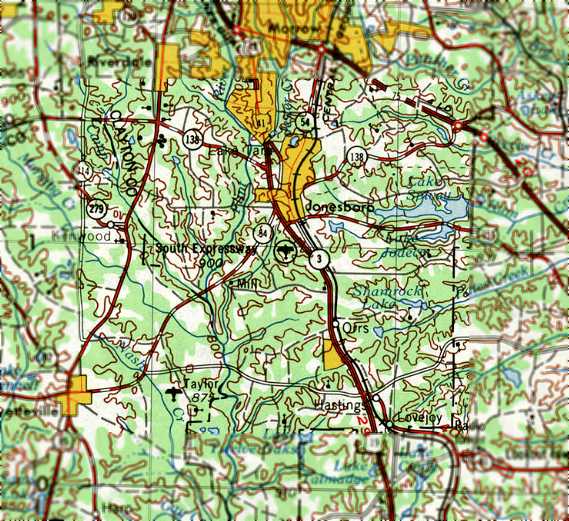
South Expressway Airport, as depicted on the 1970 USGS topo map.
John Lipscomb recalled, “Mr. Galloway died of a sudden heart attack in the mid-1970s at his home.
I used to cut the grass for Mrs. Galloway until I went off to college in 1979.”
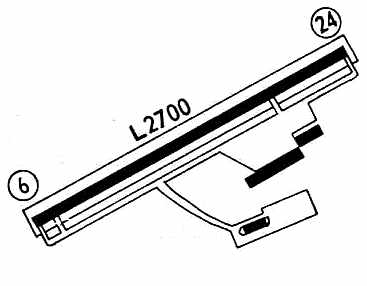
The 1972 Flight Guide (courtesy of Chris Kennedy) depicted the South Expressway Airport
as having a single 2,700' paved Runway 6/24.
A parallel taxiway on the south side of the runway led to 2 ramps, along which were 3 buildings (hangars?).
Trish Phillips recalled, “In the mid-1970s, I was a passenger in a friend's Luscombe & we landed at South Expressway Airport.
I remember how friendly the folks were & we were even loaned a station wagon so we could drive to lunch.”
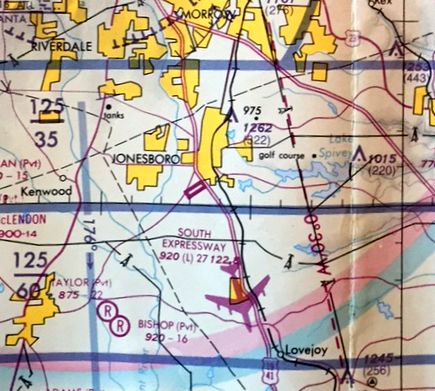
The last aeronautical chart depiction which has been located of South Expressway Airport was on the 1978-79 GA Aeronautical Chart (courtesy of David Stevenson).
It depicted South Expressway Airport as having a single 2,700' paved runway.
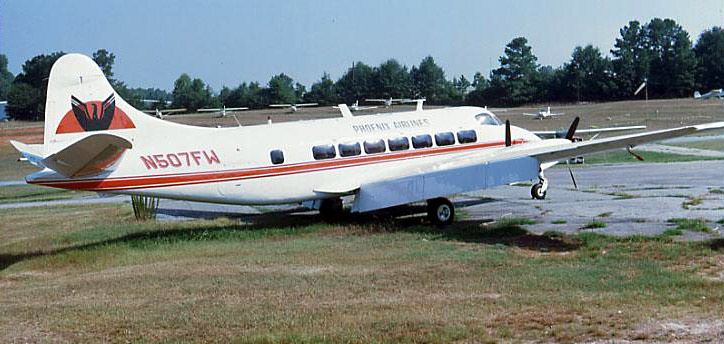
An October 1980 photo (courtesy of David Henderson) of a Pheonix Airlines De Havilland Heron N507FW.
David recalled, “Phoenix airlines parked their deHavilland Heron there for a few months after they went out business in 1980.”
David Bryan recalled, “In 1980, I learned to fly there also & we [he & his father] taught students together in the early 1980s.”
South Expressway Airport was still described in much the same manner
in the 1982 AOPA Airport Directory (courtesy of Ed Drury).
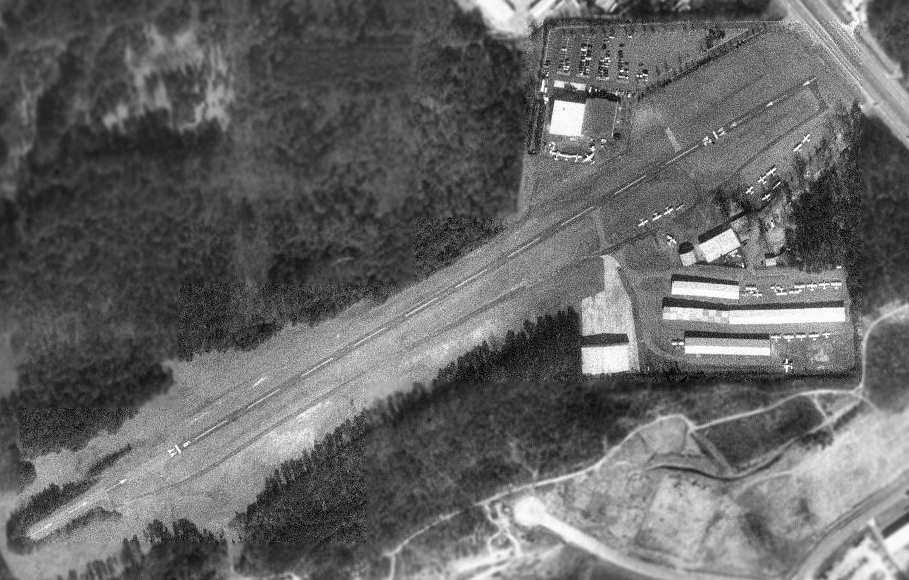
As of the 1993 USGS aerial photo, South Expressway Airport was apparently quite healthy,
as a total of 30 aircraft were visible parked outside, in addition to the 4 hangars which were at the airport.
South Expressway Airport was owned by Lucy Huie & her husband.
David Lopez reported that he flew into & out of South Expressway Airport in the early 1990s.
He recalled, “This airport was unlike many of our current airports in that it was 'Spectator Friendly'.
If you went out to this airport on a weekend, you would find open hangars
with lawn chairs strewed about facing the runway and bar-b-q grills scenting the air with the aroma of hotdogs & hamburgers.
Kids, parents, family and friends would gather to watch as the planes would take-off & land.”
David Bryan recalled, “Some lawyer owned it for awhile then it was acquired by Delta pilot Ron Smith.
Ron built a large hangar there where he ran a cargo op with D18s & turboprops.
Later, Ron moved his operation to Tara Field, and flying at South Expressway dried up.
When Ron died is when it was sold to the county.”
According to Glen Boyd (manager of LaGrange-Callaway Airport),
a fairly large tract of houses was located on the opposite (northeast) side of Route 19-41,
"from which the usual barrage of complaints often came.
Off-airport emergency landings didn't help much,
especially one that crashed on the roof of a house in the development
(yes, of course the airport was there LONG before the development)."
According to Ronald Willard, "South Expressway Airport closed in approximately 1994
as part of a transaction brokered between Henry & Clayton counties
over the use of then named Bear Creek Airport (now known as Tara Field),
located less than 10 miles south of South Expressway Airport just off Highway 19-41.
Most private pilots who once used South Expressway likely now use Tara.
Tara Field doesn’t have quite the character South Expressway had.
There was nothing like the sight of cruising up Highway 19-41
and suddenly having a small plane zip across just overhead on final approach."
The land of the former South Expressway Airport was purchased in 1998,
and construction began that same year to build the Clayton County Justice Center on the site.
Glen Boyd points out the irony in how the complaints of neighboring residents
contributed in replacing an airport with a prison:
"I often wonder about how happy having a penal institute in this location makes residents of that development."
In the words of Ronald Willard, "The community should have left well enough alone,
a small airfield is a much better neighbor than a jail."
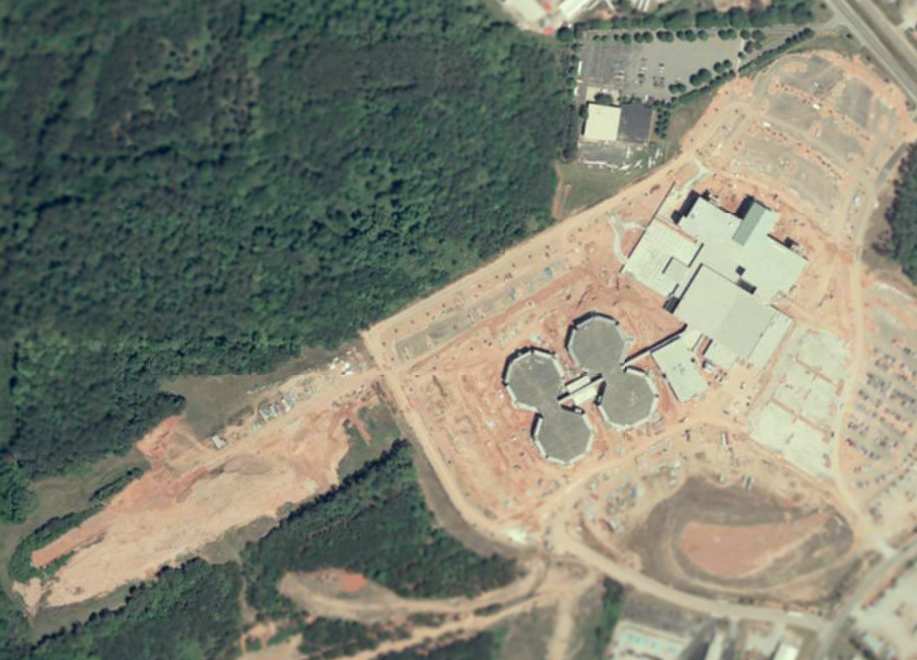
As can be seen in the 2002 USGS aerial photo,
the runway had been removed,
and the building of the Justice Center had been constructed over most of the former airport property.
However, note the 8 airplanes that were still parked around the former airport building northeast of the center of the photo.
According to Glen Boyd, the building was the Clayton College & State University A&P school.
These were apparently the aircraft which were used in maintenance instruction at the school.
Boyd notes that the A&P school itself has recently been threatened with closure,
so it may not still be operational.
Ronald Willard reported in 2004,"I was at the old site of South Expressway [Airport] earlier today
and found that a portion of the old runway is still in place.
It is cracked, of course, with a lot of grass growing through but an old bed is still there."
According to David Lopez, “I miss this kind of atmosphere & I'm pretty sure that we have seen the last of such public airports.
Apparently the local community preferred a prison instead of a small airstrip.”
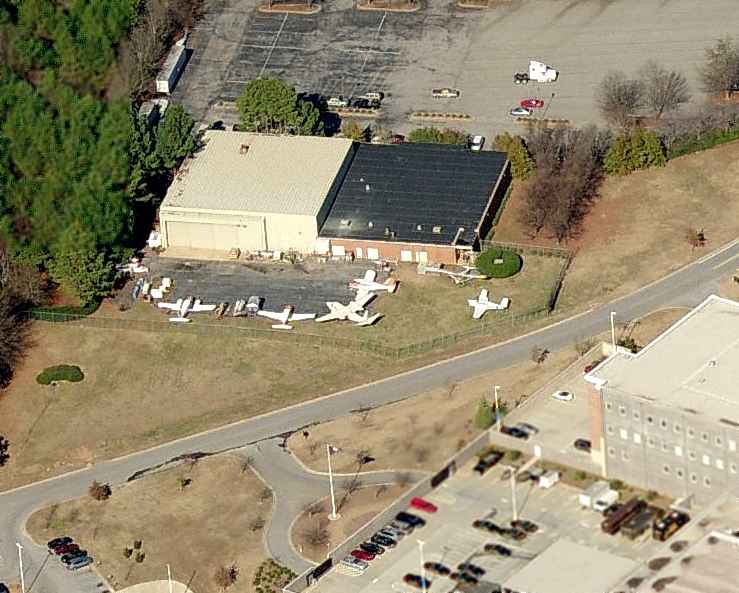
A circa 2008 aerial photo looking north at the 6 airplanes that were still parked around the Clayton College & State University A&P school.
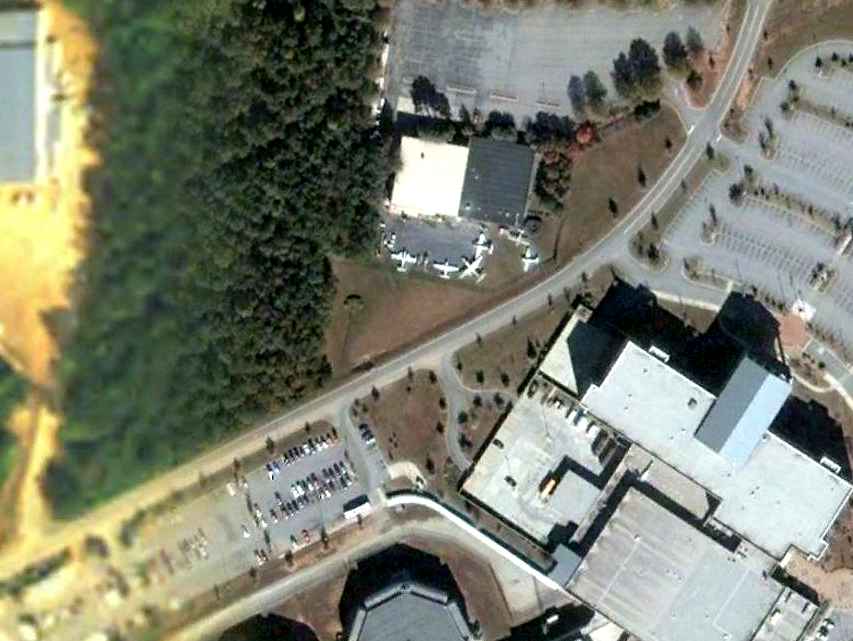
An 8/19/05 aerial photo showed 6 airplanes that were still parked around the former airport building
on the north side of the runway (even after the runway had been removed).
According to Glen Boyd, the building was the Clayton College & State University A&P school.
These were apparently the aircraft which were used in maintenance instruction at the school.
Boyd notes that the A&P school itself has recently been threatened with closure,
so it may not still be operational.
A 6/15/06 aerial photo still showed 6 airplanes parked around the A&P school building.
A 6/25/07 aerial photo showed that the planes had been removed from the A&P school building,
erasing this curious trace of the South Expressway Airport.
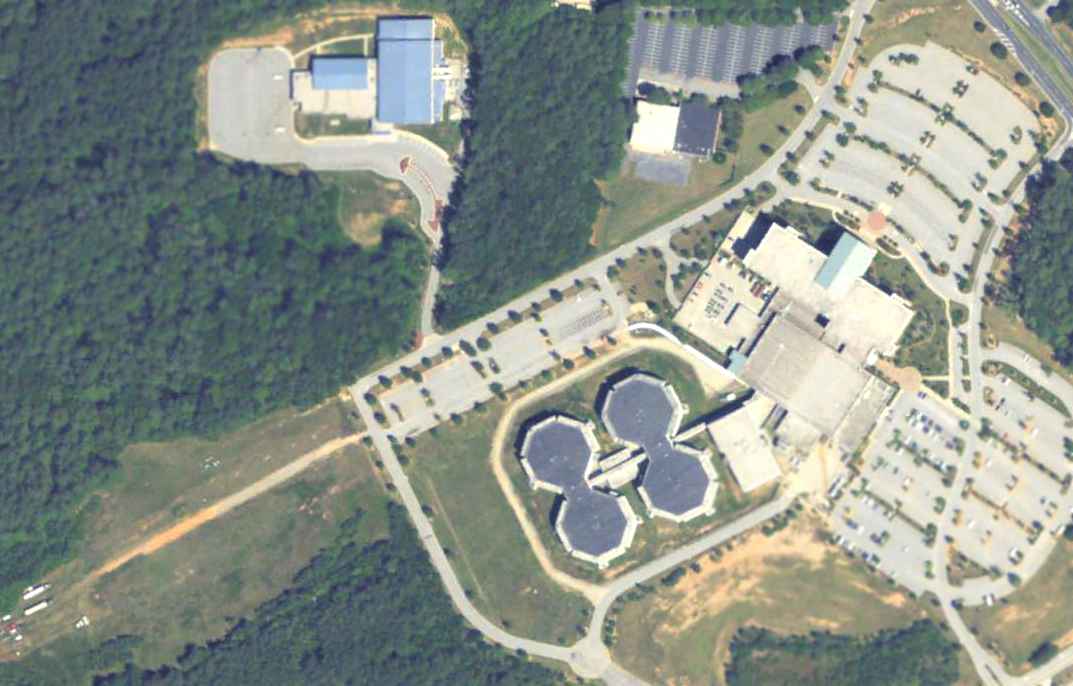
A 1/1/10 aerial view showed that the last remaining traces of the South Expressway Airport were the southwest end of the runway, and the former A&P school building on the north side.
The site of South Expressway Airport is located west of the intersection of Tara Boulevard & Poston Road.
Thanks to Larry Judy for pointing out this airfield.
____________________________________________________
33.55, -84.17 (Southeast of Atlanta, GA)
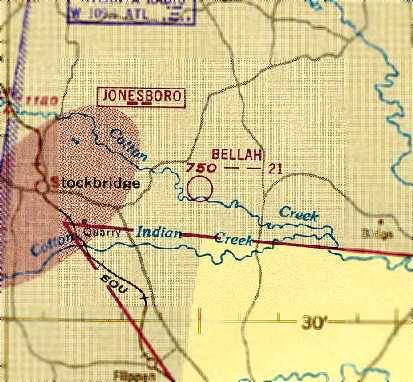
Bellah Field, as depicted on the August 1951 Atlanta Local Aeronautical Chart (courtesy of Chris Kennedy).
Bellah Field was dedicated on 7/10/32, according to an article in the 7/11/32 The Palm Beach Post (courtesy of David Henderson).
According to Gordon Bellah's obituary (courtesy of David Henderson),“Early in his career, he built Bellah Airport at his home on a 2,300' pasture.
It was traditional for pilots from far & near & from other countries to gather at his airport on Sunday afternoons for 'Hangar Flying,'
and to mingle with skydivers who used his airfield as a base.
As 'Dean' of aviation at the Bellah School of Aeronautics in Stockbridge,
Bellah was credited with turning out more fledglings than any other pilot in the southeast.
One of the first skydiving schools in the south was at Bellah Field.
It is believed that the modern parachute evolved based on what was leaned there.
The jumpers were protective of their silk parachutes.
They packed & sewed & made repairs themselves until finally the 'chutes' became more fragile & smaller.
They discovered that some maneuvering was possible & they could land where they wanted to land.
A traditional story is that at one point, Gordon’s group challenged the Army to a contest to see who could land more accurately.
The Army jumped first & they never hit their target, but everyone of Bellah’s boys landed on their target.”
Bellah Field may have gone through a period of closure during WW2 (like many other small civilian airfields near the coasts due to wartime restrictions),
as it was not depicted on the April 1945 Birmingham Sectional Chart (according to Chris Kennedy).
The earliest depiction of Bellah Field which has been located
was on the August 1951 Atlanta Local Aeronautical Chart (courtesy of Chris Kennedy).
It depicted Bellah as having a 2,100' unpaved runway.
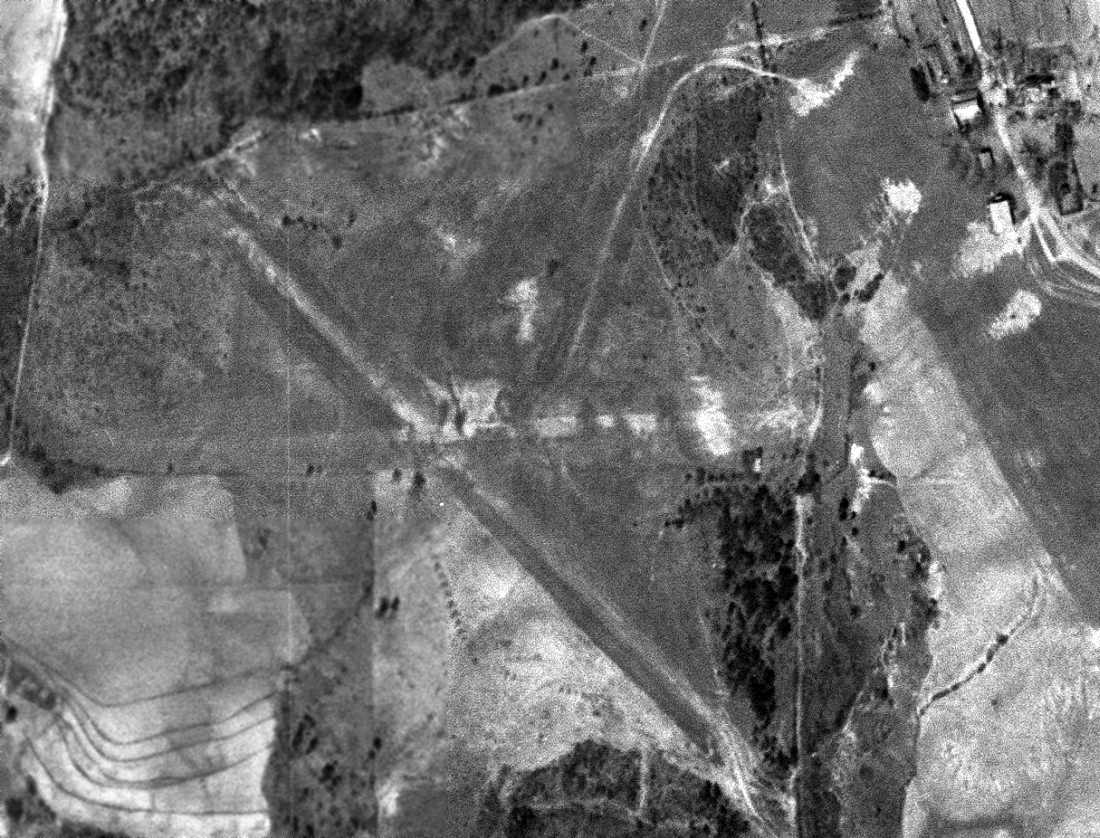
The earliest photo which has been located of Bellah Field was a 3/9/55 USGS aerial view (courtesy of David Henderson).
It depicted Bellah as having 3 unpaved runways, with a few small buildings (hangars?) along the northeast side.
No aircraft were visible on the field.
According to Jeremy Pirtle, the field was listed at one point as the "Gerald E. Bellah International Airport...
which was obviously a joke since the now-deceased owner operated a small light aircraft out of there.”
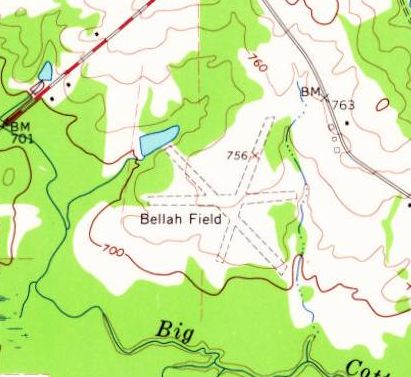
The 1964 USGS topo map depicted Bellah Field t depicted the field as having 3 unpaved runways,
and 3 small buildings along the east side.
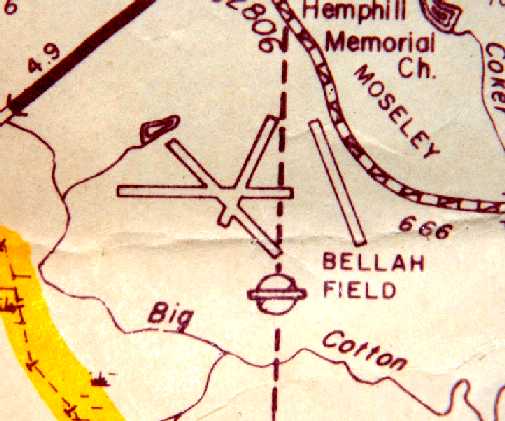
Bellah Field had gained a 4th runway along its east side at some point between 1964-80,
as that is how it was depicted on a 1980 highway map (courtesy of Jeremy Pirtle).
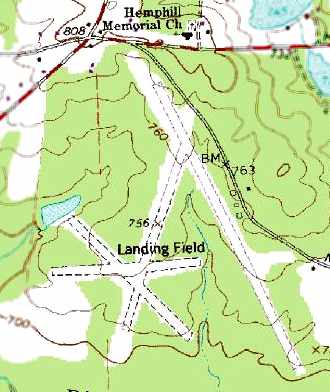
The 1982 USGS topo map labeled Bellah Field simply as “Landing Field”.
It depicted the field as having a total of 4 unpaved runways, with a few small buildings along the east side.
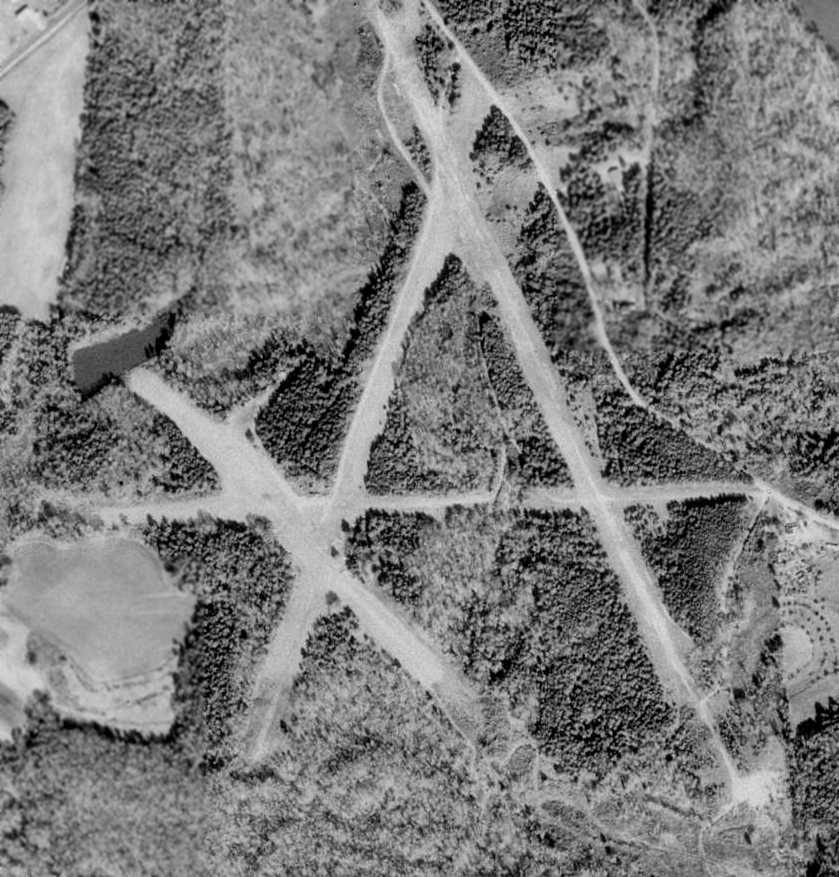
The 2/12/88 USGS aerial photo depicted the runways of Bellah Field,
but did not show any aircraft or other signs of recent aviation usage.
The buildings seen in earlier photos along the east side appeared to have been removed.
According to Gordon Bellah's obituary (courtesy of David Henderson), “Gordon Bellah continued to promote aviation until his death at age 90 in 1996.
Many aviation careers were launched under his tutelage.”
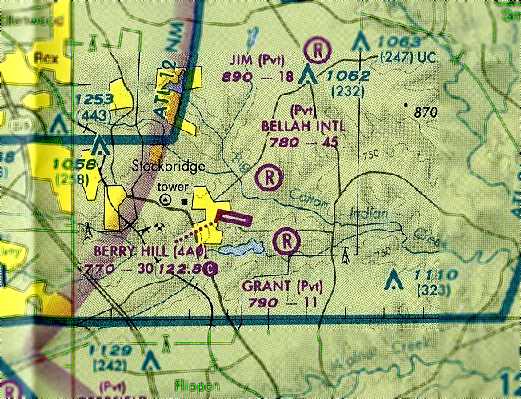
The last aeronautical chart depiction which has been located of Bellah Field
was on the September 2004 Atlanta Terminal Aeronautical Chart (courtesy of Chris Kennedy).
It depicted “Bellah International” as a private field having a 4,500' unpaved runway.
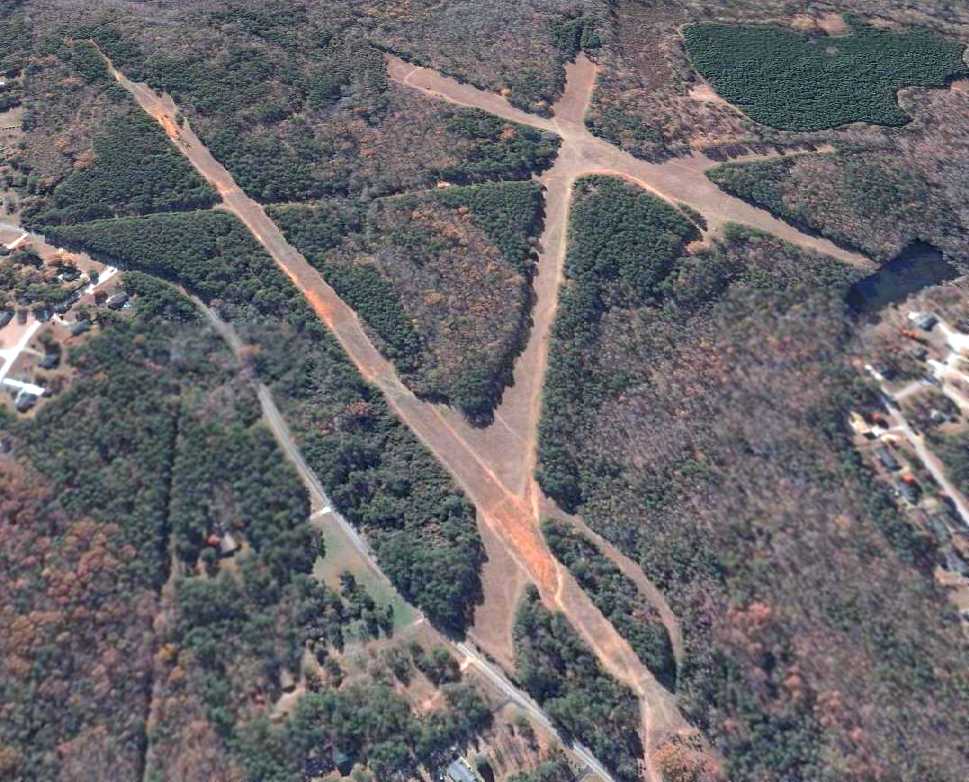
A November 30, 2005 aerial view looking south showed the Bellah Field runways continued to be kept clear.
Bellah Field was evidently closed at some point between 2004-2009,
as Jeremy Pirtle visited the site of Bellah Field in 2009, and reported,
“The airstrip has been mauled in preparation for yet another subdivision, but the general layout is still discernible.
There is nothing that looks like removed paving, other than a couple of piles that probably came from 2 smallish concrete slabs.
No evidence remains of any runways visible from ground level.
I was able to locate an elderly gentleman from another nearby strip who told me that the former owner was an old barnstormer
who just wanted a large airfield of his own & had the ability to build one himself.”
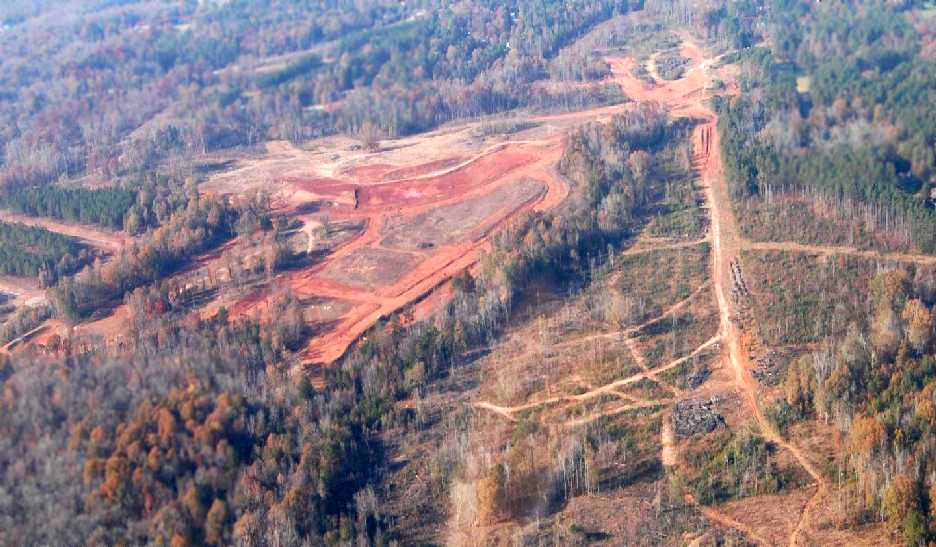
A 2009 aerial view by Jeremy Pirtle looking north at the site of Bellah Field shows that the property is being cleared for construction.
Jeremy noted, “The devastation is worse from the air than I thought, but you can still sort of see the layout.”
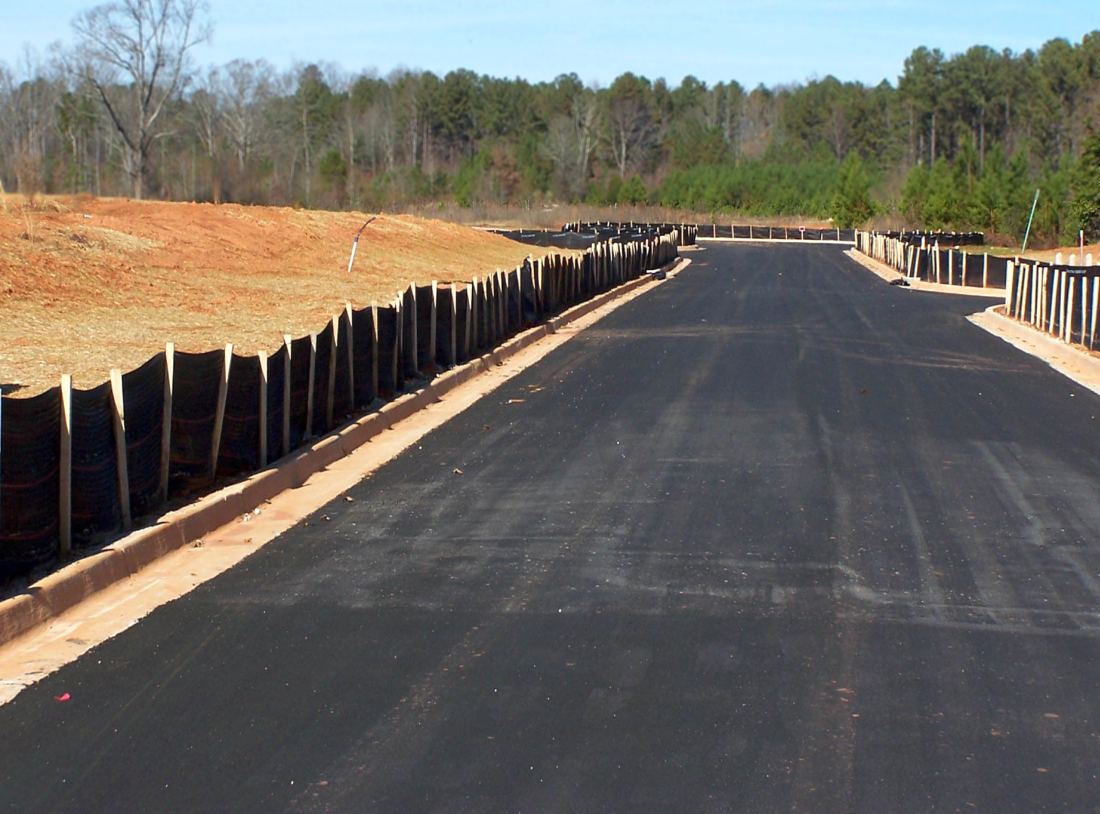
A 12/7/14 photo by David Henderson “looking northeast along a new road that parallels the old southwest/northeast runway” of the former Bellah Field.
David reported “The runway would have been immediately to the left of the road in this shot. The roads have aviation-themed names.
The subdivision construction [Bellah Landing] is in full swing. There is enough space for hundreds of homes.”
The site of Bellah Field is located south of the intersection of Hemphill Road & Moseley Road.
____________________________________________________
33.965, -84.41 (Northeast of Atlanta, GA)
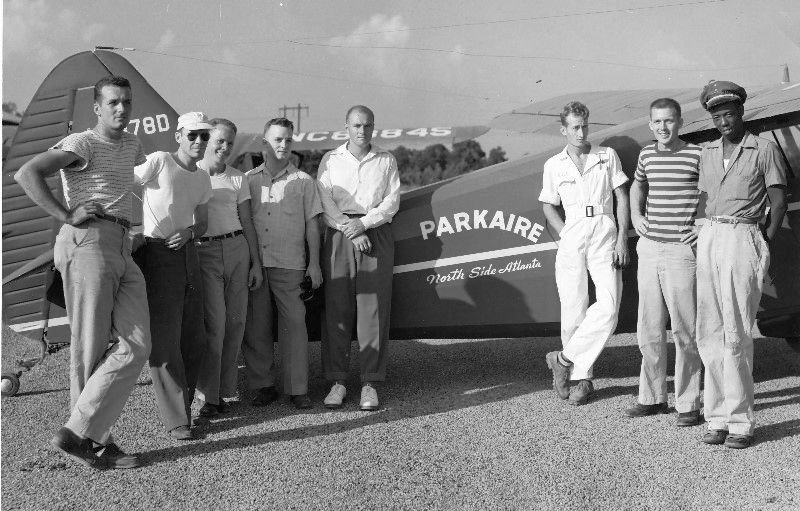
A 1946 photo of a group including Jack Dunn (2nd from right) at Parkaire Field in front of a Stinson Voyager 108-2 which had been newly-painted with the Parkaire logo.
According to the 1966 “Atlanta Metropolitan Region Comprehensive Plan” (courtesy of David Henderson),
Parkaire Field was built in 1945.
According to Phil Bonner Jr., "Walt Nix bought the property around 1946 after being a Captain in the Army Air Corps
in which he met a fellow whose dad owned a new company called Piper Aircraft.
Walt became the southeast distributor for Piper and made good money in the aviation boom of the era.”
The earliest photo which has been located of Parkaire Field was a 1946 photo of a group including Jack Dunn
in front of a Stinson Voyager 108-2 which had been newly-painted with the Parkaire logo.
Patricia Ovbey Thomas recalled, “I flew out of Parkaire many times as a child of about 7-8 years old in about 1946-50
when Jack Dunn (who became a test pilot for the C-5A) & Pete Davidson were managers.
Bobby Moor, one of 3-4 pilots out at Parkaire, flew out of there & flew my 2 siblings & I
as trade-off for my dad's repair services to maintenance equipment in the shop at the airport.
The shop was full of tools that used air compressors to operate them & Dad, Tim Ovbey, could fix about anything that was broken.
Dad had virtigo & couldn't fly so they took us kids up. My first trip up was in the Red Cherokee!
Bobby was one of the pilots for hire for the planes chartered around the area for trips to from Atlanta & pleasure & entertainment.
The Chattahoochee River would rise & flood over it's many bridges, no Bufford dam at that time,
and folks wanted to come out of Atlanta to their weekend homes
and Parkaire air service became very popular for the doctors & Atlanta store owners who had weekend homes on Bishop's Lake & Mountain Park.”
Patricia continued, “They'd leave Candler Field in Atlanta & fly out to Parkaire.
At that time in my life, I began a love affair for small planes, small airports and anything that flew!
Bobby Moor had a history. He loved to perform and did tail spins over our house for 3-4 years. He'd fly low enough for us to talk.
Jack Dunn went to Lockheed & not sure where Pete Davidson & family went.
The road near Parkaire, Davidson Road was named for Pete, as his house sat over to the side & the road started as his driveway!
Yes, I became an incurable airport & airplane junkie from a bunch of sweet guys
that put up with a little curious girl & her siblngs who were crammed in the back seat of those baby planes.”
Patricia continued, “My brother, Jim Ovbey, who was younger than me; he got to sit in front every now & then, next to Bobby.
We'd take the Piper Cubs out most of the time & one of them had a missing passenger door
and he sat & strapped Jim into that doorless plane & those blue eyes got really big & that head full of blond straight hair swished all around
as he looked & asked hundreds of questions!
Bobby told him 'We use this one to take pictures' Jim, you can see better, also.
Bobby laughed his boyish laugh & revved up that engine as he loved to so we would shutter just a little & he knew that.
He'd ask us if we liked to hear that & we told him it was scarey; that's all Bobby needed because he was nothing but a tease.
When we got airborne, he tipped that doorless plane on its side & told Jim to look out & asked Jim what do you see;
Jim told him he could see the river & some houses. We were at the Chattahoochee.”
Patricia continued, “We lived a mile down on the other side of Johnson's Ferry Road on Roswell Road
and Dad worked in Buckhead at that time & often stopped in at the airfield to see if anything was broken or out of operation before he came home.
Those guys were his buddies & between Dad & Bobby, who were the cutups, there were always tricks on the other guys going on.
Pete & Jack were more serious, more refined, officers & gentlemen of the military, thank you.
So you see why I liked to go up to Parkaire, I loved the laughter of guys,
those deep, loud laughs that tell kids things are all right even with a war going on or just coming to an end, somewhere in the world.”
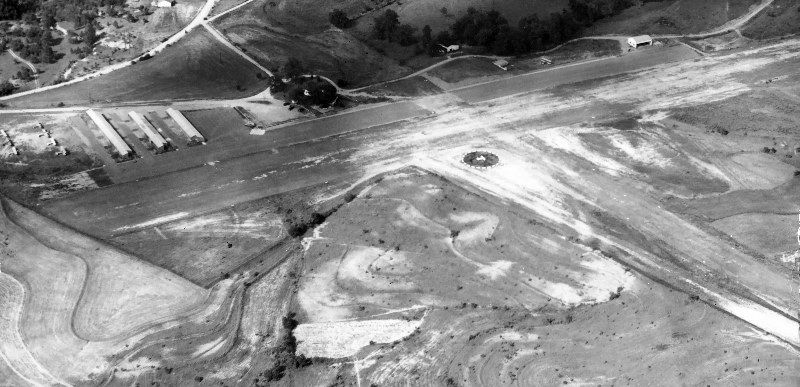
A 1947 aerial view by Jack Dunn depicted Parkaire Field as having 2 unpaved runways, with 3 rows of T-hangars on the northwest side of the field.
Joe Rao recalled, “When I was at GA Tech 1947-51, the Tech flying club flew out of Parkaire.
The aircraft I flew there there were: Ercoupe NC94761, Aeronca Champ NC1650E, Cub J-3 NC40605,
Cub Cruiser NC2824M, Cessna 120 NC2217N, Cessna 140 NC77011, Stearman PT-17 NC1208M (Donated by the Navy).
I know the PT-17 & Champ were owned by the club, the others by the FBO.”
Alan Dameron reported, “I have a letter & invoice dated 1949 from Parkaire Field listing the owners as Hal Davison & Peter Davison.
Dad kept his Stearman tied down at Parkaire.”
According to Phil Bonner Jr., "Walt Nix was like an uncle to me & taught my dad Phil Bonner to fly there around 1951 or so."
Ed Leonard recalled, “I took flying lessons as a 17-year-old at Parkaire in 1951.
The next year my father bought a Bellanca & kept it at Parkaire.
Walter & Kitty Nix owned & operated the field during the early 1950s.
Although Walt was a licensed instructor, I took my lessons from his 22-year-old employee, Johnny Orr.
The 2,200' main runway was dirt, but there was, of all things, a paved taxiway along its north side.
Once when I was there, a DC-3 (which did not try to make contact by Unicom) wanted to land.
It kept making approaches to the narrow, somewhat obstructed, paved taxiway.
We tried to wave it over to the dirt runway, and finally succeeded.
The 1,800' cross runway was dirt, and had a LARGE tree partly obstructing the south approach.”
Ed continued, “There were several incidents at Parkaire.
The biggest one was a tornado (!) which damaged the T-hangars & several of the planes.
Another was in fall of 1952 when my father was practicing precision landings,
landed short, turned the Bellanca up on its nose, and broke off one of its (wooden) wings. He was not injured.
Flying was exciting (and inexpensive) in the early 1950s!”
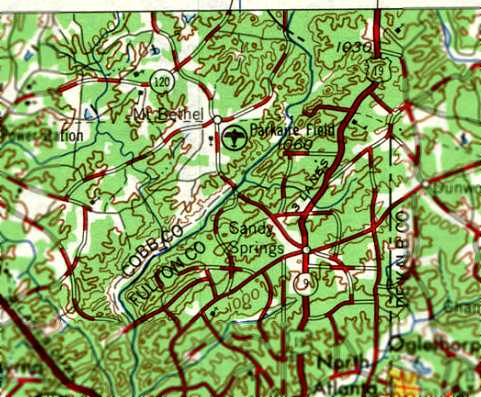
Parkaire Field, as depicted on the 1953 USGS topo map.
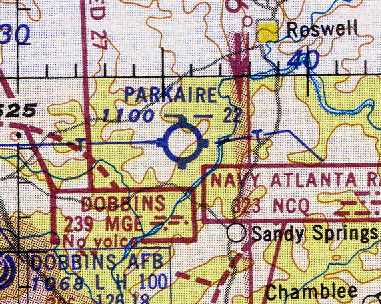
The earliest aeronautical chart depiction which has been located of Parkaire Field
was on the August 1954 Birmingham Sectional Chart (courtesy of Chris Kennedy).
It depicted Parkaire as having a 2,200' unpaved runway.
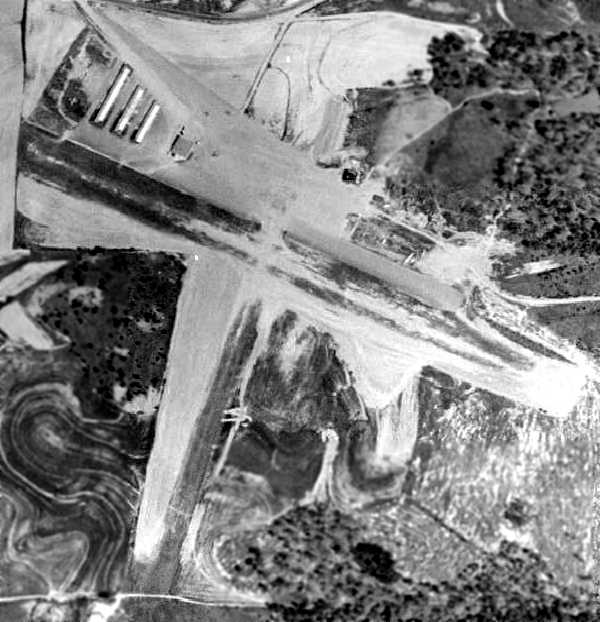
The earliest photo which has been located of Parkaire Field was a 1955 aerial view.
It depicted the field as having 2 unpaved runways,
with 3 rows of T-hangars on the northwest side of the field.
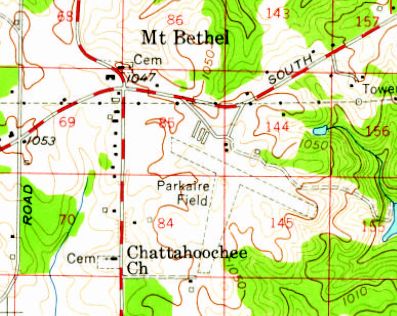
The 1955 USGS topo map depicted Parkaire Field as having 2 unpaved runways.
In 1959, a meeting was held at at Parkaire Field to reorganize the North Georgia Soaring Society (NoGass).
The Club purchased a Schweizer 2-22 for the sum of $2,000.
A flying fee of 3 cents/minute & a tow fee of $1.00 / thousand feet was established.
The operator of Parkaire, Walter Nix, agreed to let the club operate at Parkaire Field.
Parkaire had evidently gained a paved runway at some point between 1955-60,
as a 1960 aerial view depicted a paved northwest/southeast runway.
Several buildings & hangars had also been added along the north side of the field.
There were a total of a dozen light aircraft visible on the field.
In the Spring of 1962 the North Georgia Soaring Society's 2-22 was flipped & destroyed in a windstorm at Parkaire
and as a result, flying activity by the soaring club was severely curtailed.
In the late Spring of 1962 the NoGass Club & MGSA Club were merged
and continued to operate from Parkaire Field under the MGSA name.
Later members of the club constructed a new airfield at Monroe, GA airport,
and moved their operations there,
as suburban development was beginning to encroach on Parkaire Field.
Parkaire had evidently gained a paved runway at some point between 1954-62,
as the 1962 AOPA Airport Directory described Parkaire Field
as having a 2,200' asphalt Runway 12/30 & a 2,000' sod Runway 18/36.
The operator was listed as Walter Nix.
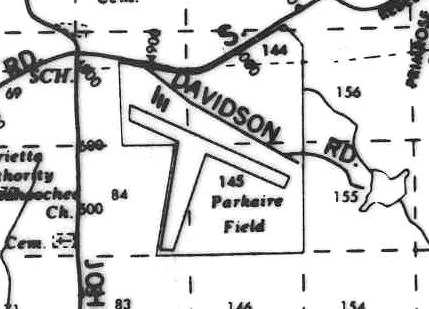
A 1964 street map (courtesy of Robert Brown) still depicted Parkaire as having two runways.
According to the 1966 “Atlanta Metropolitan Region Comprehensive Plan” (courtesy of David Henderson),
“In 1965, these aircraft were reported based at the airport: single-engine, 1-3 places (9);
single-engine, 4 or more places (19).”
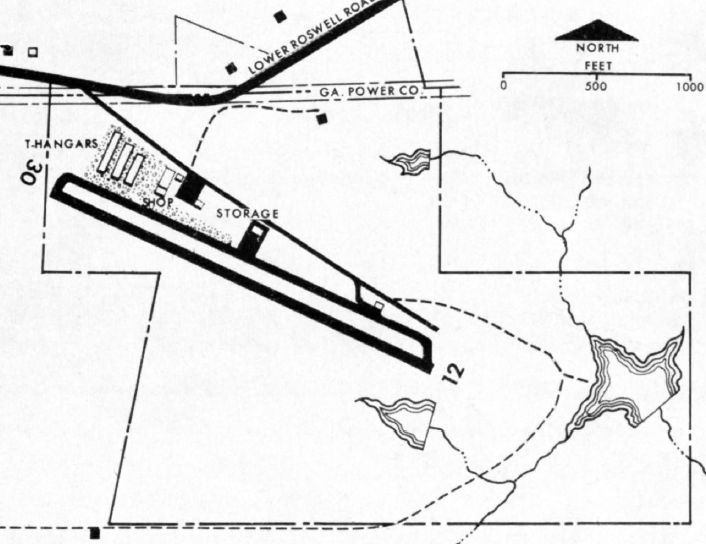
The 1966 “Atlanta Metropolitan Region Comprehensive Plan” (courtesy of David Henderson)
depicted Parkaire Field as having a single Runway 12/30, with T-hangars & a shop on the northwest side.
According to the 1966 “Atlanta Metropolitan Region Comprehensive Plan” (courtesy of David Henderson),
“Parkaire is the oldest of the privately-owned general aviation fields in the region.
In recent years residential subdivision development has begun in the general vicinity of the field.
The 74-acre site is not suitable for airport expansion.
Nearby development prevents runway extension to the west, while to the east the land falls off sharply toward the Chattahoochee River.
The single runway is 2,200' long, with pavement 40' wide;
it & the associated taxiway & apron are in good condition but are not lighted, and the field is attended only during daylight hours.
Although open to the public, Parkaire is maintained primarily as a necessary adjunct to an aircraft distributorship, principal business of the owner.
There is underground storage for 4,000 gallons of aviation gasoline.
The following facilities and services are also available: Major & minor repairs to power plant, airframe, instruments & accessories,
Aircraft services: washing & waxing, Aircraft storage: T-hangars 22 spaces, Tie-down 5 spaces,
Sales of new aircraft, engines, instruments, radios, Sales of used aircraft,
Flight instruction for all ratings available by special arrangement.”
Joe Price recalled, “In 1968 I experienced my first small plane flights from its runway
in the local Civil Air Patrol squadron’s Aeronca L-16
and in Noel DeChar’s clipped-wing Piper J-3.”
A 1968 aerial view depicted Parkaire at perhaps the zenith of its popularity,
with over 30 light aircraft visible on the field.
The 1968 Flight Guide (courtesy of Robert Levittan) depicted Parkaire Field as having a single paved 2,200' Runway 12/30,
as well as a parallel taxiway on the north side leading to a long ramp.
A total of 10 buildings were situated on the north side of the ramp.
Andrew Croft recalled, “Parkaire in Marietta.. my Dad used to work on a J3 there that he restored.
I flew in & out of there many times & it could get pretty scary.
here was high-tension power lines on one end & almost a cliff on the other, you would disappear over a hill on take off.
The power lines were lowered with orange balls on them & the last time I was there they still ran across the shopping center parking lot.”
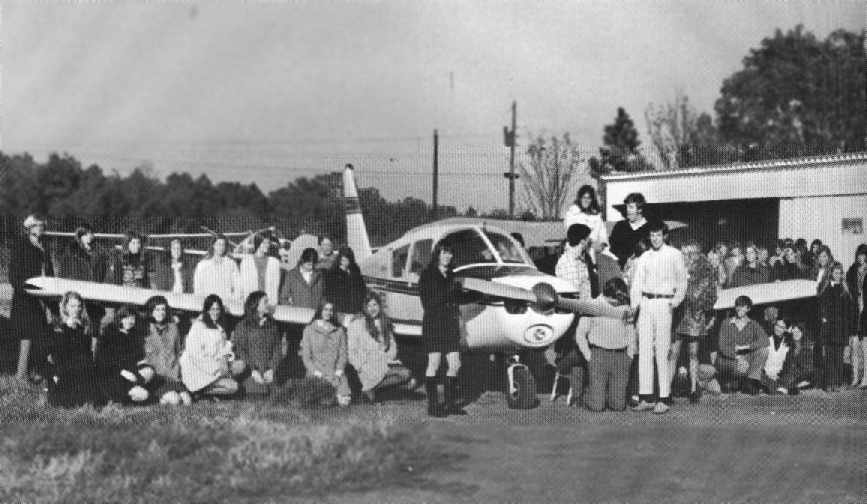
A circa 1970-71 photo (courtesy of Joe Price) of students around an unidentified aircraft at Parkaire Field
from North Springs High School’s 1971 yearbook.
According to Joe, “The American Field Service did its annual spread there in late 1970 or early 1971.”
Parkaire was still depicted as an active airfield on the 1971 Atlanta Sectional Chart (courtesy of Robert Brown),
which depicted the field as having a single 2,200' paved runway.
According to Phil Bonner Jr., "Walt Nix… sold the airstrip around 1972."
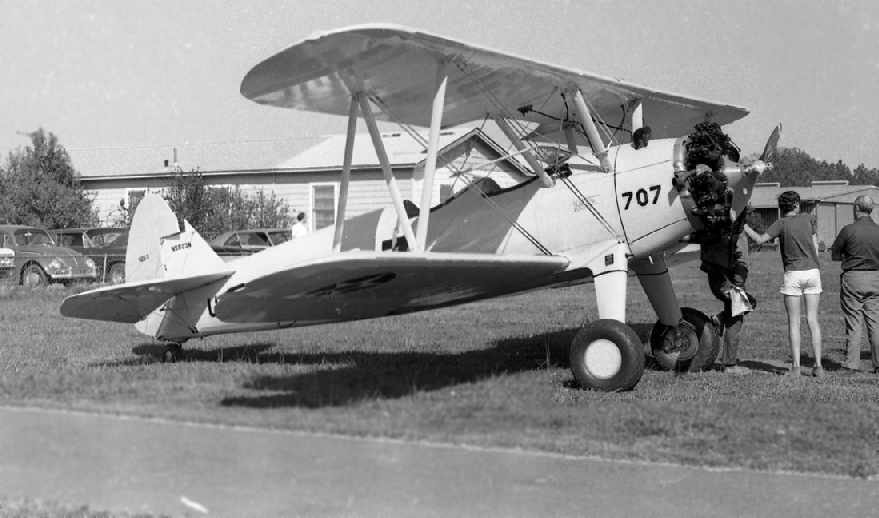
A Summer 1972 photo by Robert Brown of “Gordon Dunnagan's Stearman from PDK visiting Parkaire to shoot landings.
If you've ever been to PDK you'll understand why it wasn't practical to shoot landings in a Stearman there.”
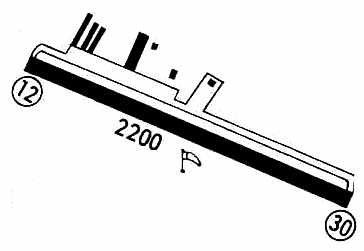
The 1972 Flight Guide (courtesy of Chris Kennedy)
depicted Parkaire Field as having a single 2,200' paved Runway 12/30,
as well as a parallel taxiway on the north side leading to a long ramp.
A total of 7 buildings were situated on the north side of the ramp.
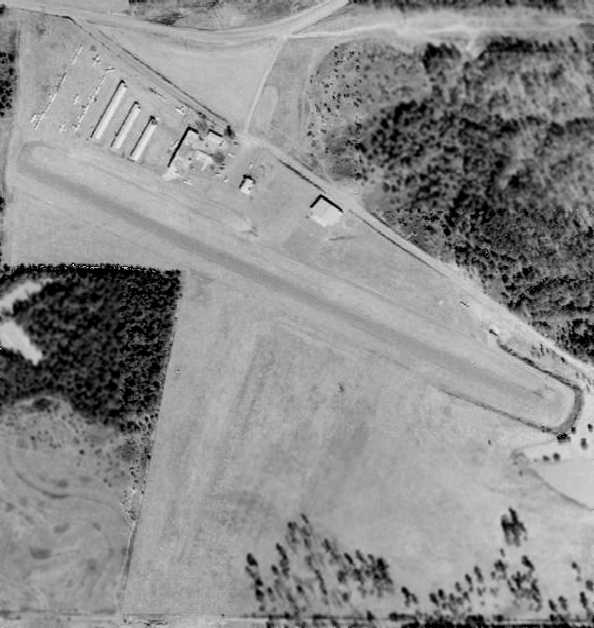
The last photo which has been located showing Parkaire Field in operation was a 1972 aerial view.
A total of 25 light aircraft were parked at the northwest corner of the field.
Parkaire Field was closed at some point during 1972.
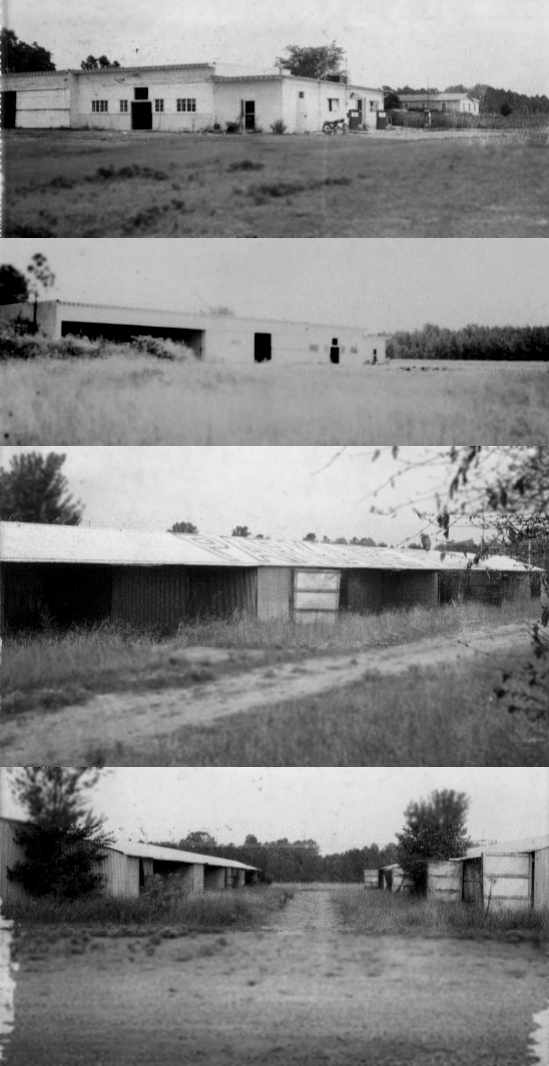
A series of August 1972 photos of the abandoned Parkaire Field by Joe Price.
Joe recalled, “I motorcycled to the site on August 27, 1972,
shot the black & whites, then had the presence of mind to map the shoot.
The photos show a distinct ghost town quality;
the overgrowth suggests it had been abandoned since spring of that year, possibly before.”
The top picture depicted the main operations building.
Joe observed, “The office was on the right next to the fuel pumps.
Building 'C' is in the background, but I don’t know what its use was.”
The second picture is of the main operations & maintenance building.
The third picture is of the southern end of Hangar 2 (note “Parkaire Field” painted on the roof.
The last picture is of Hangars 1 & 2.
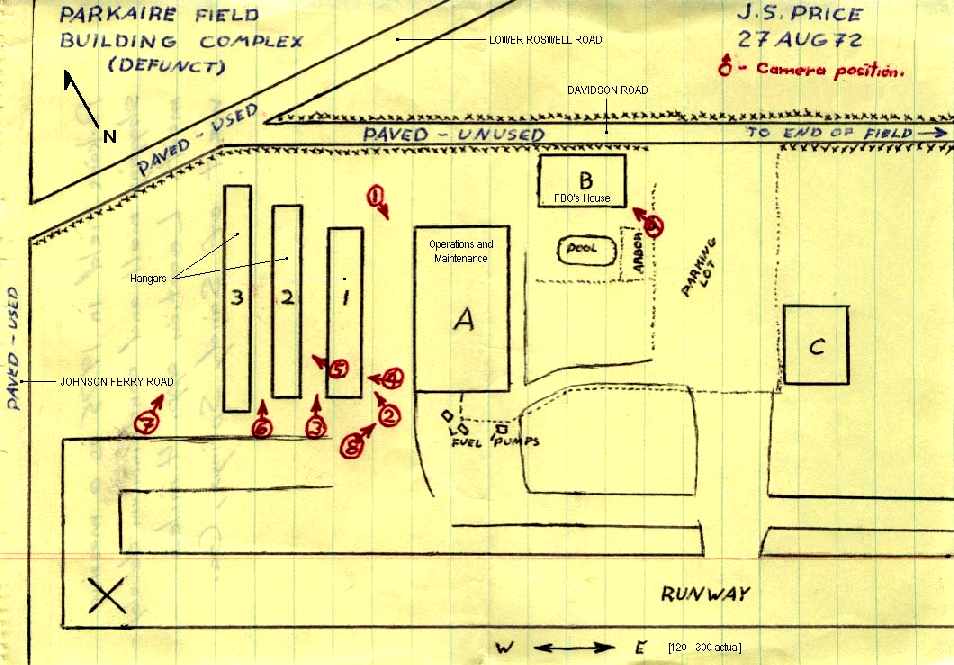
A layout by Joe Price of the arrangement of Parkaire Field as it existed in August 1972.
Patrick Burchins recalled, “Parkaire Field... In 1973, my family moved to Georgia from Florida
and my father was the General Superintendent for Holder Construction on the Parkaire Project.
Between Summer of 1973 & 1974 my dad was in charge of demolishing & new construction
of a mall with an ice skating rink in the middle of it & a Kroger grocery store attached.”
According to Robert Brown, "Parkaire was replaced by Parkaire Mall.
Davidson Rd was the access road to the airport & the runway ran parallel to it.
When the mall was first built,
there was a section of runway still visible but the original mall was torn down and replaced by a new one
and the whole area has been developed more."
Parkaire was no longer depicted at all on the April 1974 Atlanta Sectional Chart (according to Chris Kennedy).
A 1978 aerial photo appeared to show no trace remaining of the airport.
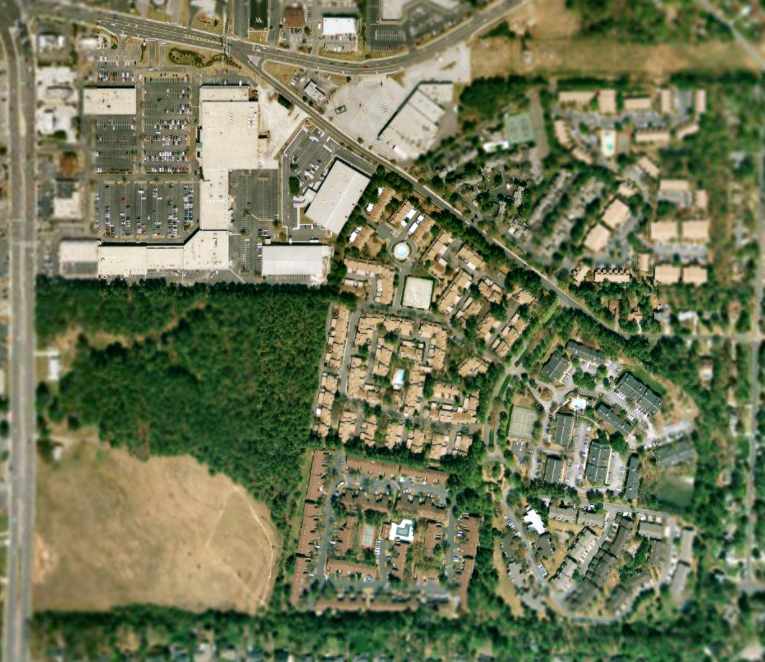
As seen in the 2005 USGS aerial photo, the outline of the southern portion of the former airport property is still recognizable,
but there are no other elements of the former Parkaire still remaining extant.
Patrick Burchins reported in 2009, “There is one thing left from the old Parkaire Field.
There are large red cones attached to the high-tension wires for the power company warning the aviators that were landing at the old airport.”
The site of Parkaire Field is located southeast of the intersection of Lower Roswell Road & Davidson Road.
____________________________________________________
33.728, -84.161 (East-southeast of Atlanta, GA)
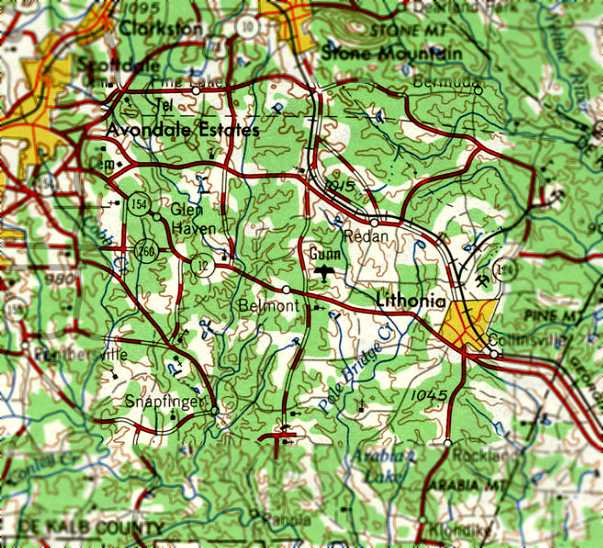
Gunn Airfield, as depicted on the 1953 USGS topo map.
Gunn Airfield was not yet depicted on the April 1945 Birmingham Sectional Chart (according to Chris Kennedy).
According to the 1966 “Atlanta Metropolitan Region Comprehensive Plan” (courtesy of David Henderson),
“Gunn was developed shortly after the Second World War.”
The earliest depiction of Gunn Airfield which has been located was on the 1953 USGS topo map.
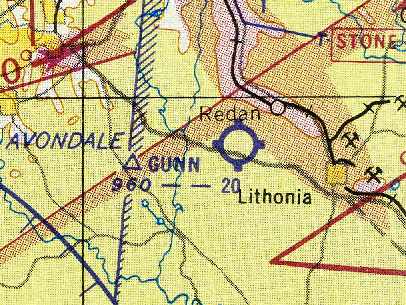
The earliest aeronautical chart depiction which has been located of Gunn Airfield
was on the August 1954 Birmingham Sectional Chart (courtesy of Chris Kennedy).
It depicted Gunn as having a 2,000' unpaved runway.
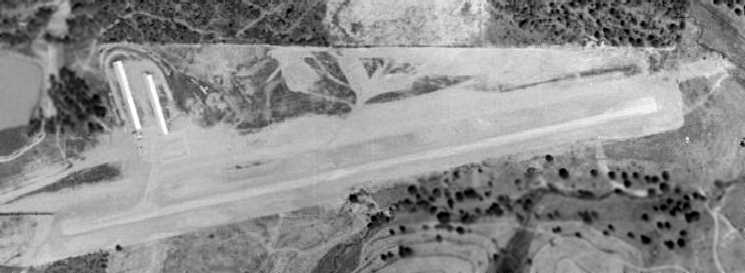
The earliest photo which has been located of Gunn Airfield was a 1955 aerial view.
It depicted the field as having a single unpaved northeast/southwest runway.
Two rows of T-hangars sat on the northwest side of the field, near which were 2 light aircraft.
John Wyrick recalled, “My Aunt, Uncle and 2 cousins learned to fly & all soloed at Gunn Field in the mid 1950s.
I flew with them a lot. It was quite an adventure.
One of the perils was that quite often there was a pretty good cross wind too!
If you learned to fly at Gunn you could fly anywhere!”
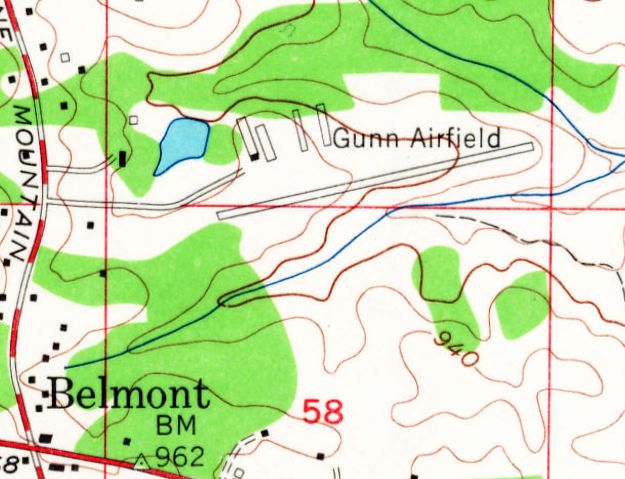
The 1956 USGS topo map depicted "Gunn Airfield" as having a northeast/southwest runway,
with 4 rows of hangars on the north side.
John Towler recalled, “I soloed a Piper Super Cub N2779A on 9/20/58 at Gunn Field.
My instructor was Red Goodman. The Super Cub & a Navion belonged to the Atlanta Army Depot Flying Club.”
Gunn apparently gained a paved runway at some point between 1954-60,
as the 1960 USDA aerial photo (courtesy of David Henderson) depicted the field as having a single paved runway,
with 4 rows of T-hangars on the northwest corner of the field.
The 1961 Great Smoky Mountains World Aeronautical Chart (courtesy of Chris Kennedy)
depicted Gunn as having a 2,000' hard-surface runway.
The 1962 AOPA Airport Directory described Gunn as having a single 2,100' asphalt Runway 8/26.
The operator was listed as George Gunn.
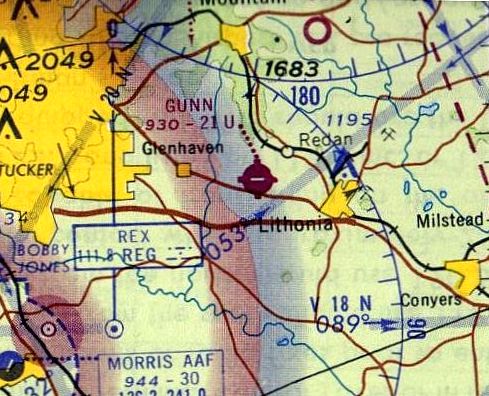
The 1963 Birmingham Sectional Chart depicted Gunn as having an east/west 2,100' paved runway.
Fred Bieser recalled, "I have memories of going to Gunn Airfield with my dad when I was young.
It looked to me to be the world's most dangerous airport.
It seemed to be short, bumpy & with trees way too close to the runway."
Dave Forrest recalled, “I flew several airplanes in & out of Gunn, including the P-51 shown in the Stone Mountain photo.
During the 1960s & 1970s I flew a Beech 18, T-6,and the P-51 at Gunn Field.
During that same time frame there was a Delta pilot Bob Jenkins that owned a Stearman, a PT-22, and a T-6, all were based at Gunn.”
Gunn was described on the 1964 Savannah Sectional Chart (courtesy of Chris Kennedy)
as having a single 2,100' hard-surfaced runway.
According to the 1966 “Atlanta Metropolitan Region Comprehensive Plan” (courtesy of David Henderson),
“The following aircraft were reported based at Gunn in 1965:
single-engine, 1-3 places (16); single-engine, 4 or more places (49).”
Thom Riddle recalled, “I got my private ticket in 1966 at Gunn Airfield in Lithonia.
I was a member of the Georgia Tech Flying Club which leased an old straight-tail Cessna 150 from George Gunn.
We paid $7/hour wet plus $4/hr for the instructor.”
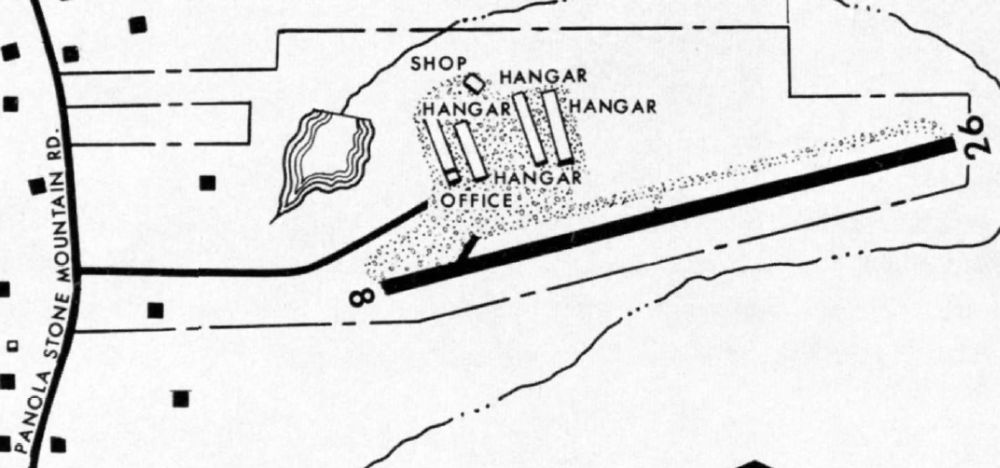
The 1966 “Atlanta Metropolitan Region Comprehensive Plan” (courtesy of David Henderson)
depicted Gunn Air Field as having a single Runway 8/26, with an office, shop, and hangars on the north side.
The 1966 “Atlanta Metropolitan Region Comprehensive Plan” (courtesy of David Henderson)
described Gunn as the “Second busiest of the privately-owned general aviation fields in the region.
The field is accessible via Panola-Stone Mountain Road, a regional thoroughfare, approximately 1.5 miles north of its interchange with Interstate highway 20.
DeKalb County's suburban growth has spread farther to the north & east,
and intensive subdivision development has not yet reached the vicinity of the field.
However, the 60-acre site is insufficient. The airport is handling as many aircraft as can be accommodated, and cannot be expanded.
The single paved runway is 2,130' long & 30' wide, and is equipped with low intensity lights.
Its grade is pronounced & runs downward to the east, with an overall difference in elevation of approximately 51'.
Because the approaches are extremely restricted by trees near the ends of the runway, lights are operated only on call for pilots who are familiar with the airport.
The field is normally attended during daylight hours.
There are underground storage tanks for 4,000 gallons of aviation gasoline.”
The 1966 “Atlanta Metropolitan Region Comprehensive Plan” (courtesy of David Henderson) continued,
“Other facilities & services for general aviation aircraft and pilots include:
Major & minor repair of power plant, airframe, Aircraft services: washing, waxing,
Aircraft storage: T-hangar - 37 spaces, Tie-down - 40 spaces,
Aircraft for rental & sight-seeing use, Sale of new & used aircraft & accessories,
Sale of used instruments & radios, Ground school & flight instruction for all ratings except glider & helicopter flying: Instructors 2, Aircraft 7.”
Tom Abarr recalled, “I began hanging out at Gunn Field around 1967.”
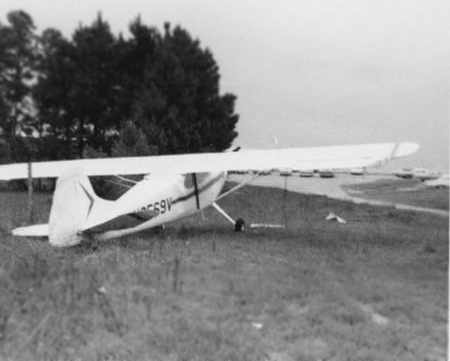
An August 1969 photo by Tom Abarr of a Cessna “170 that has been ripped from its tiedown,
blown across the driveway, and is resting against the fence abutting George Gunn's back pasture Gunn Field.”
This was from a tornado that hit Gunn Field.
Tom Abarr recalled, “About 1970, Mr. Gunn leased the airport to Johnny Allison (not the race car driver),
who subsequently sub-leased to Harold Dean.
Mr. Dean ran Dean Aviation, Inc., a flight school that was FAA & VA approved.
The school provided flight instruction from primary to advanced
using a fleet of C150's, C172's, a C182, Mooney Executive, and a Beech B95 Travelair.
I started working for Mr. Dean in 1970 as counter clerk, fuel jockey,
floor sweeper, etc., and soloed in 1971 at age 16.”
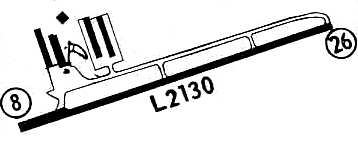
A 1971 airfield directory (courtesy of Chris Kennedy)
described Gunn as having a parallel taxiway on the north side of the runway,
leading to a ramp area with four rows of t-hangars.
The remarks said, "Due to obstructions in approach, landings are limited to pilots familiar with airport."
In the words of Chris Kennedy, "I got a kick out of the comment about limited landings.
I wonder how you get familiar with an airport without landing there?"
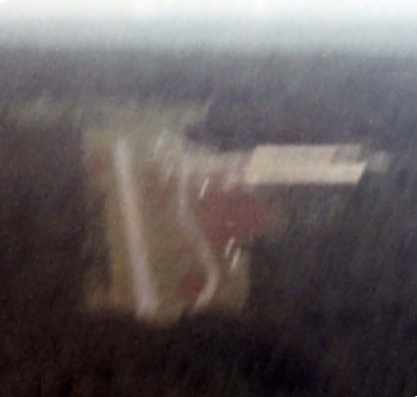
A circa 1971 aerial photo by Tom Abarr, “that I took as I turned final for Runway 26 in a Cessna 150.
You can see the taxiway & T-hangars just to the north of the runway.
Trees were very close to the approach end of Runway 26, which had an uphill slope.
Taking off on Runway 9 could be an adventure, downhill aiming for the trees,
but not as much of one as taking off from Runway 26 on a hot day; uphill all the way!
We did not fill fuel tanks during the summer & paid close attention to density altitude & gross weights.”
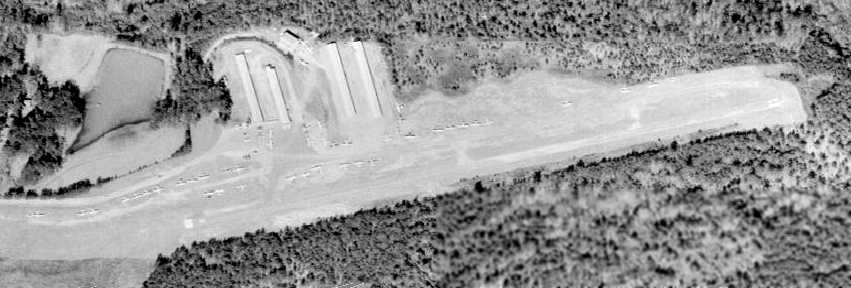
The last photo which has been located of Gunn Airfield was a 1972 aerial view.
It depicted an amazing number of aircraft at such a small airport – a total of at least 43 light aircraft.
Tom Abarr recalled, “The flight school stayed quite busy with returning Vietnam War vets.
George Gunn took the field back from Allison around 1974, ran everybody off & sold the property.
He retired to Florida.”
The precise date of closure of Gunn Airfield has not been determined.
Fred Bieser recalled, "I remember watching the runway being dug up to make way for the subdivsion."
Jon Berndsen recalled, “In the early 1970s Gunn Field was closed
and my glider club, Mid Georgia Soaring Association,
bought the large 50x50 hangar that was there (depicted on the north end of airport in the diagram),
dismantled it, and re-erected it at the Monroe (GA) Airport.”
A 1978 aerial view showed that all of the hangars & other airport buildings had been removed.
It appeared as if the runway pavement had been removed as well,
but the property was otherwise not yet redeveloped.
Moser recalled, “Gunn Airfield... I used to live near this airfield from about 1978-81, when the area was first being developed for subdivisions.
I recall seeing the airfield on an older topo map in either the summer of 1979 or 1980.
Curious, I found the entrance to the airfield, which was relatively overgrown & abandoned, and I raced my motorcycle up & down the runway.
I don't recall there being any buildings (hangars) around at all, just the runway.
A police officer one time pulled in to see what I was up to, but didn't mind that I was running up & down it.
I recall that the runway surface was poor, but obviously not bad enough for me to have a little fun.”
Gunn Airfield was no longer listed among active airfields in the 1982 AOPA Airport directory.
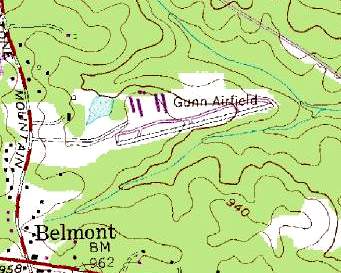
"Gunn Airfield" was still depicted on the 1983 USGS topo map.
Note that the depiction of the 4 hangars was erroneous, as photos showed they had all been removed since at least 1978.
A 1/25/93 aerial photo showed that the site of the former airport had been completely redeveloped with housing.
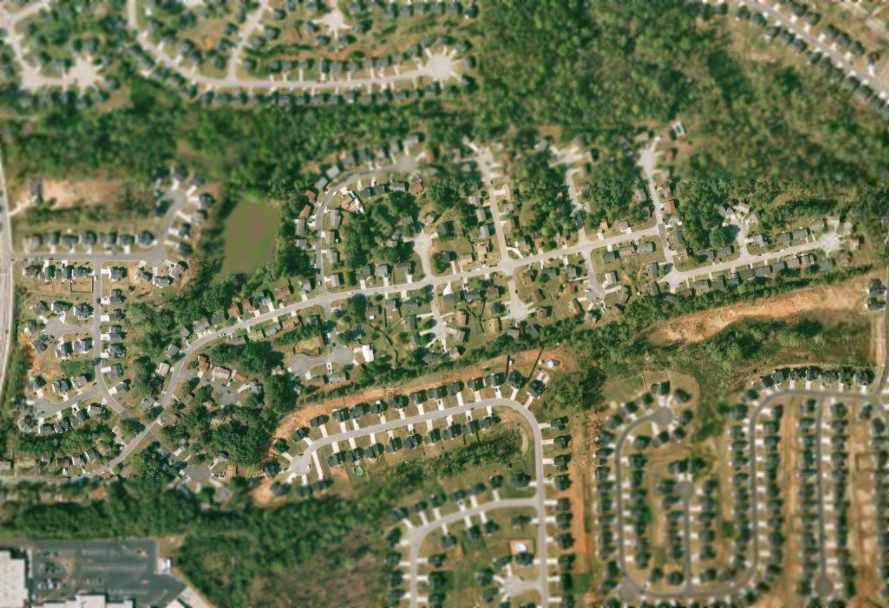
As can be seen in the 2005 USGS aerial photo,
the site of the former airport had been completely redeveloped with housing.
Jon Berndsen reported in 2005, “That old hangar is still being used by MGSA to this day [at the Monroe Airport] to house its fleet of sailplanes.
So, a little piece of Gunn Field lives on today.”
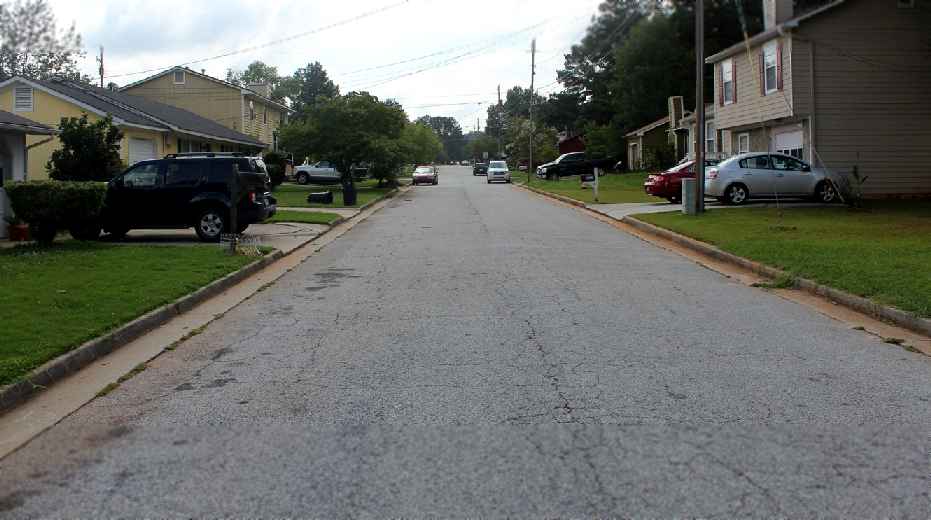
An 8/4/12 photo by Graham Watkins of the site of Gunn Field, “looking west from the location of the taxiway.
The bumps & hills are still there & the trees at the end have grown up even taller by now.”
John Towler reported in 2015, “Now the old runway is a part of a large subdivision. I go & drive down this street often. My wife thinks I am crazy.”

A 2016 photo by Robert Brown of a vintage sign for Gunn Airfield,
which Robert noted, “is reported to be in a secure location from whence it will emerge on the day
when developers begin tearing down shopping centers & subdivisions to make room for general aviation airports.”
The site of Gunn Field is located northeast of the intersection of Covington Highway & Panola Road.
____________________________________________________
Carrollton Municipal Airport, Carrollton, GA
33.597, -85.047 (Southwest of Atlanta, GA)
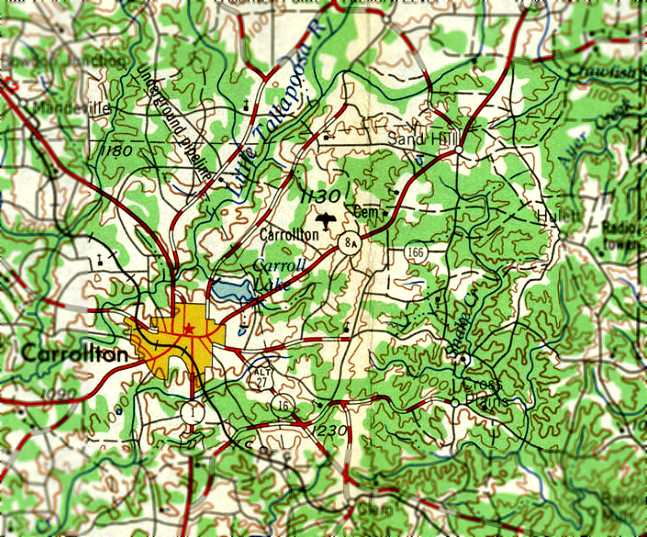
Carrollton Airport, as depicted on the 1953 USGS topo map.
This general aviation airport was apparently built at some point between 1945-53,
as it was not yet depicted on the April 1945 Birmingham Sectional Chart (according to Chris Kennedy).
The earliest depiction of Carrollton Municipal Airport which has been located was on the 1953 USGS topo map.
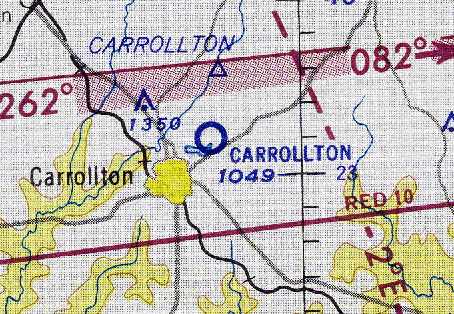
The earliest aeronautical chart depiction of Carrollton Municipal Airport which has been located
was on the August 1954 Birmingham Sectional Chart (courtesy of Chris Kennedy).
It depicted Carrollton as having a 2,300' unpaved runway.
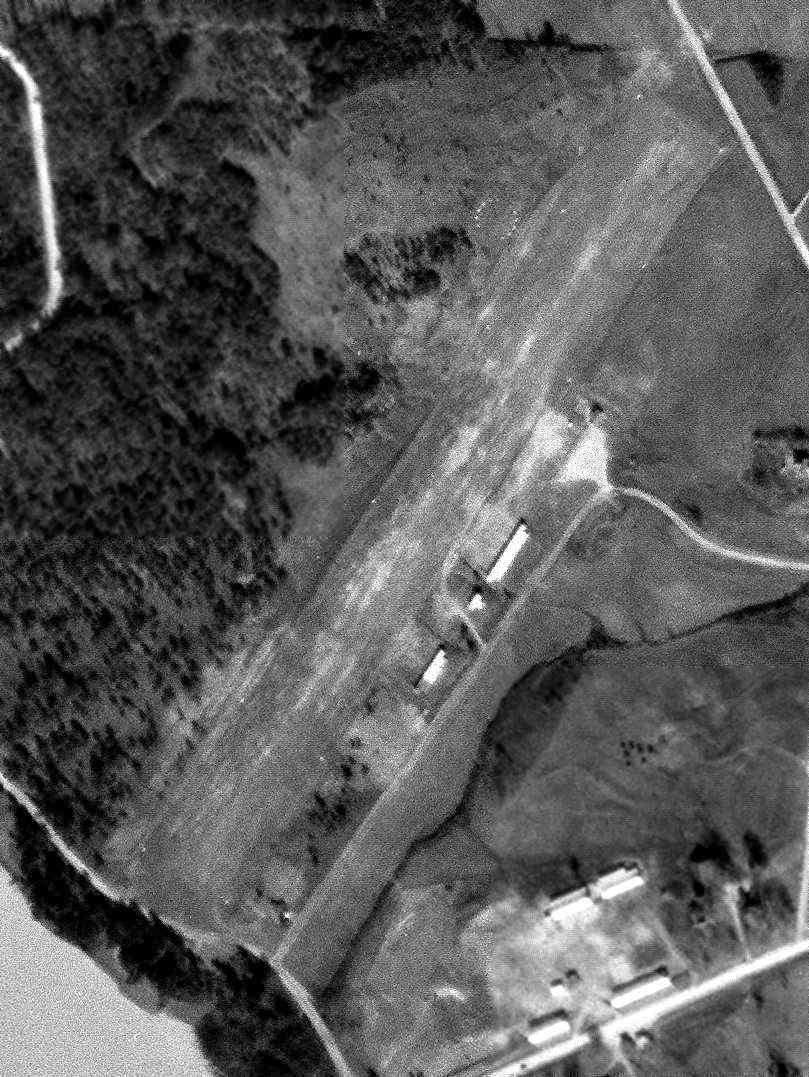
The earliest photo of Carrollton Municipal Airport which has been located was a 1/20/55 USGS aerial view (courtesy of David Henderson).
It depicted Carrollton as having a single unpaved northeast/southwest runway, with 3 small hangars along the southeast side.
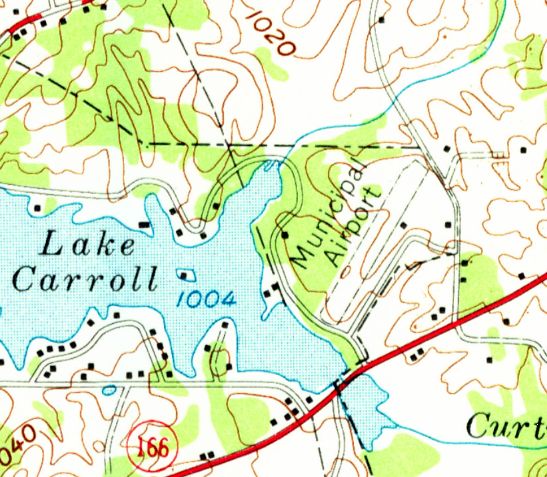
The 1958 USGS topo map depicted Carrollton as having a northeast/southwest unpaved runway.
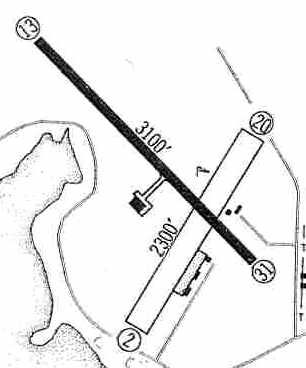
Carrollton Airport apparently gained a paved runway at some point between 1958-60,
as the 1960 Jeppesen Airway Manual (courtesy of Chris Kennedy)
depicted the field as having a 3,100' paved Runway 13/31 & a 2,300 unpaved Runway 2/20.
A taxiway led to a hangar on the west side of Runway 13/31,
and a ramp just south of the runway intersection had a few small hangars.
The 1961 Great Smoky Mountains World Aeronautical Chart (courtesy of Chris Kennedy)
depicted Carrollton Airport as having a 3,100' hard-surface runway.
The 1962 AOPA Airport Directory described Carrollton
as having a 3,100' asphalt Runway 14/32 & a 2,300' sod Runway 3/21.
The operator was listed as Carroll Flying Service.
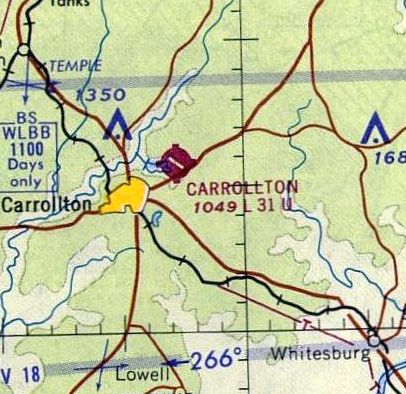
The 1963 Birmingham Sectional Chart depicted Carrollton Airport as having a northwest/southeast 3,100' paved runway.
Kenneth Husby recalled, “The old airport in Carrollton... where I grow up at. My parents ran the airport from 1965.
We use to live in a trailer house that was beside the operations building.
I was able to meet many politicians while my parents operated the airport.
I met Jimmy Carter there when he was a Representative for Georgia;
he had flown in to go to a Jaycee's meeting with a lawyer friend that lived in Carrollton.
My mother became known as one of the few women to operate an airport when they first took over operating the airport,
because at first my father stayed employed as a mechanic with Delta.”
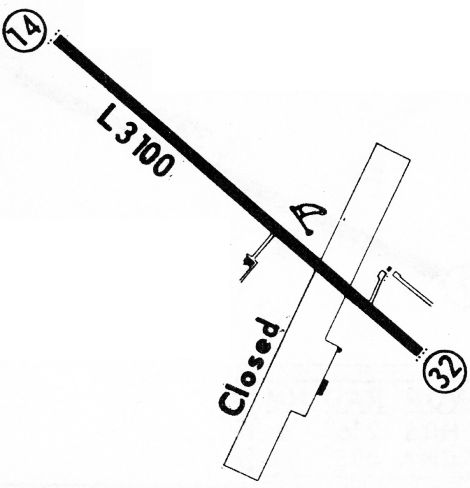
The 1968 Flight Guide (courtesy of Robert Levittan) depicted Carrollton Municipal Airport
as having a 3,100' paved Runway 14/32 & a closed unpaved crosswind runway.
Three small buildings were depicted around the periphery of the field.
Kenneth Husby recalled, “My parents ran the airport until it was closed when West Georgia Regional Airport opened up in 1969.
The old airport was closed because of the increased concerns of the residents around Lake Carroll
about the air traffic that was coming in & the airport authority wanting to get it moved to a more rural area.”
Carrollton Airport was still depicted on the 1970 USGS topo map,
and was still listed as an active airfield in the 1971 Flight Guide (according to Chris Kennedy).
Carrollton Municipal Airport was apparently closed at some point between 1971-72,
after it was replaced by the new West Georgia Regional Airport, a few miles west.
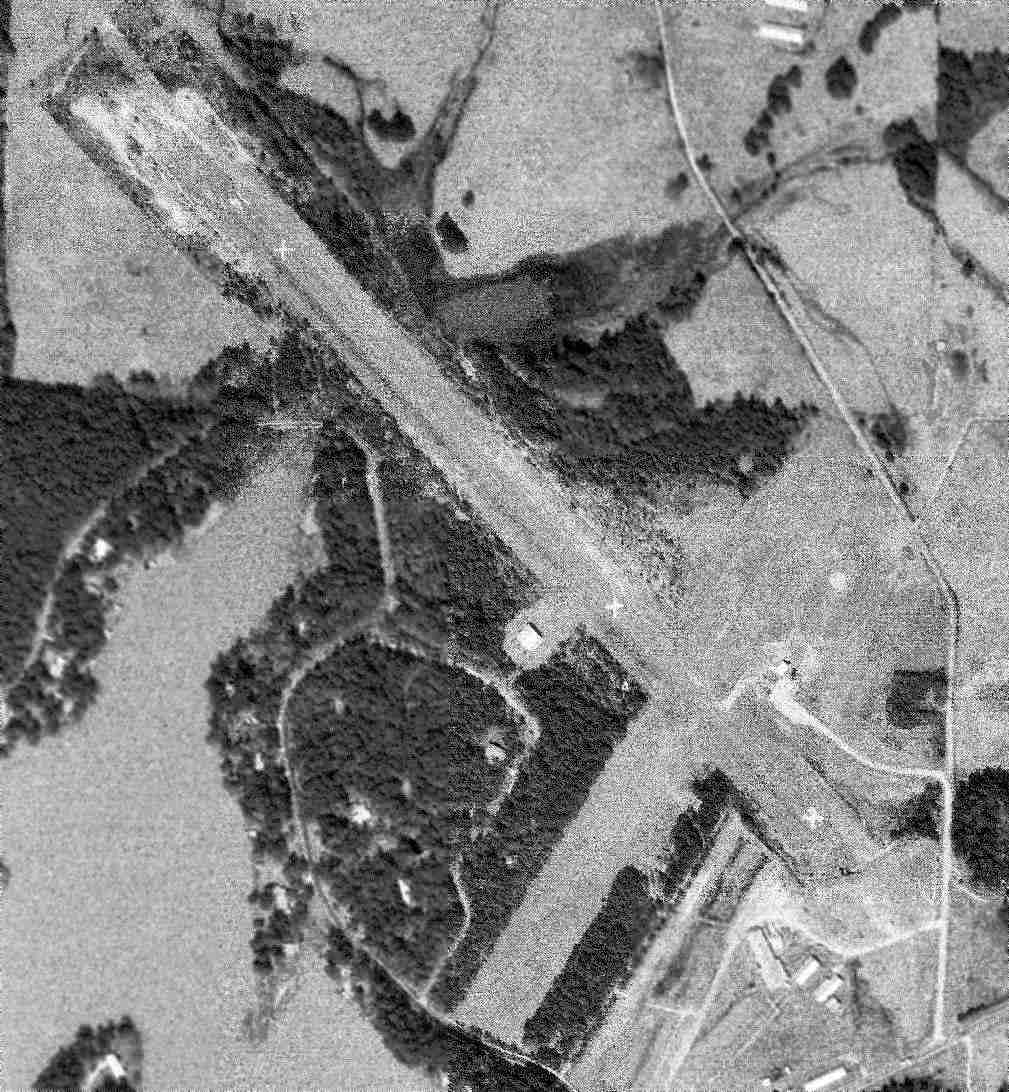
A 2/10/72 USGS aerial view (courtesy of David Henderson) depicted Carrollton shortly after its closure,
with closed-runway “X” symbols painted along Runway 13/31.
The former Carrollton Municipal Airport was depicted as an abandoned airfield
on the October 1975 Atlanta Sectional Chart (courtesy of Chris Kennedy),
According toMike Carpenter (who has lived in Carrollton since 1967),
the building west of the runway is a hangar once owned by Southwire,
since it had the name of that company written all over it.
The terminal was located just north of the southeast end of the runway,
up until the late 1970s when it was serving as a driving range shop.
After the ballfields were built the terminal was torn down, in the 1980s.
The buildings adjacent to the southeast runway end are modern buildings not related to the airfield.
There was up to the late 1980s a small control tower located west of the runway midpoint.
It was used in the 1980s for a truck driver training facility.
The property adjacent to the south side of the airport was previously a fairgrounds,
but it is now occupied by a shopping mall.
The 1982 USGS topo map depicted the paved northwest/southeast runway & unpaved northeast/southwest runway,
labeled “Airport (Abandoned)”.
In a January 27, 1993 aerial photo, the areas of the 2 runways were still cleared,
although most of the pavement of Runway 14/32 had been removed.
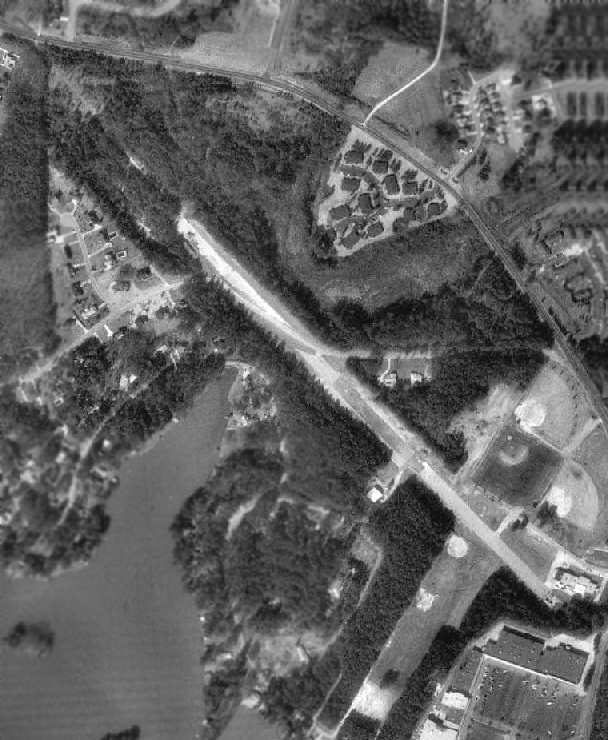
In the 1998 USGS aerial photo, the areas of the 2 runways were still cleared,
although most of the pavement of Runway 14/32 had been removed.
The airport was no longer depicted at all (even as an abandoned airfield) on the 2002 aeronautical charts.
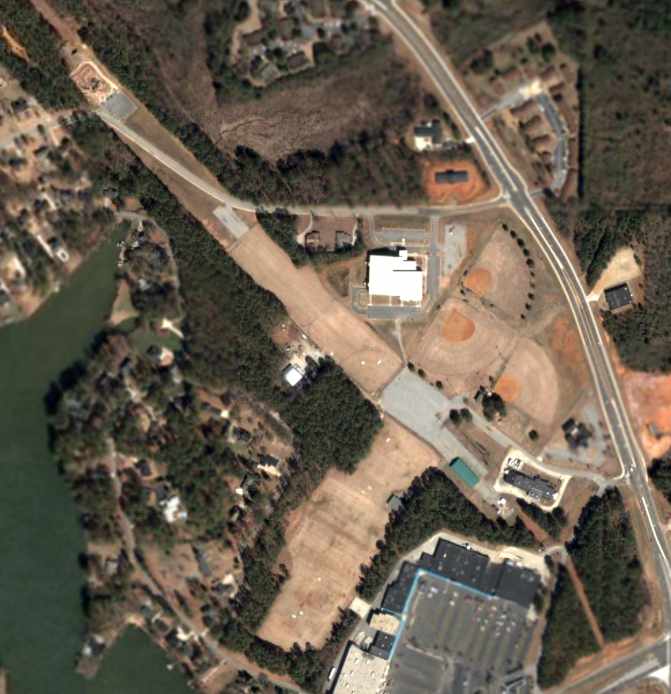
In the 2004 aerial photo, the areas of the two runways still remained recognizable,
and the former hangar still remained standing (the white building just west of the former runway intersection).
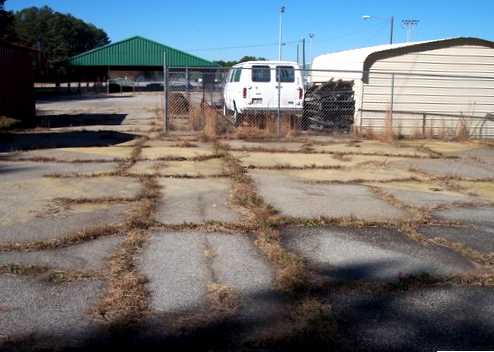
A 2006 photo by Graham Watkins at the site of Carrollton Municipal Airport, showing “the yellow X over the old runway, facing northwest.”
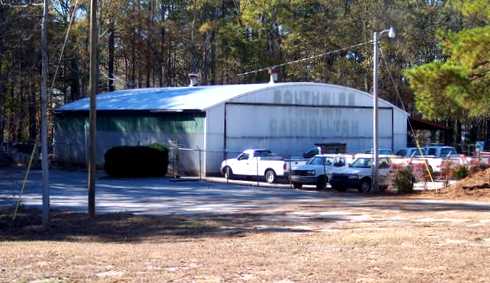
A 2006 photo by Graham Watkins at the site of Carrollton Municipal Airport, “of the old hangar, now a city building.”
The site of Carrollton Municipal Airport is located northwest of the intersection of Route 166 & Airport Road (appropriately enough),
adjacent to the fairgrounds to the south.
Thanks to Lee Parmeter for pointing out this field.
____________________________________________________
Morris Army Airfield (AGD), Forest Park, GA
33.623, -84.34 (Southeast of Atlanta, GA)
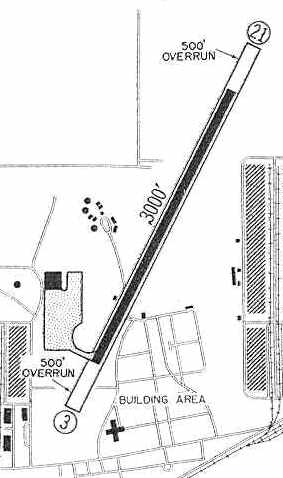
Morris AAF, as depicted in the 1959 Jeppesen Airway Manual (courtesy of Chris Kennedy)..
This military airfield was located on the property of Fort Gillem, also known as the Atlanta General Depot.
The Depot was built in 1941,
and specialized in repairing equipment for the Engineer & Ordnance Corps.
It also expanded into aircraft maintenance in the post-WW2 era.
No airfield at this location was yet depicted on the August 1954 Birmingham Sectional Chart (according to Chris Kennedy),
nor on a 1955 aerial photo.
According to Thomas Houston, the airfield at Morris AAF originally was a grass strip.
Its was evidently established at some point between 1955-58.
Thomas Houston worked on the construction of the paved runway at Morris AAF in 1958.
"At the time the airfield was built,
the Atlanta General Depot was an aircraft rework & maintenance facility for all Army Aircraft in Third U. S. Army.
The fixed-wing aircraft that were stationed at the field & were transitory there
were the Cessna O-1 Birddog, the deHavilland U-1 Otter, the deHavilland U-6 Beaver,
the deHavilland CV-7 Carribou, and the Beech U-8 Seminole.
The rotary wing aircraft that were there were the Hiller OH-23, the Bell H-13,
the Piasacki CH-21, the Sikorsky CH-25, CH-37, and CH-41."
Houston continued, “As I recall it was a very short strip.
A Bird Dog (Cessna O-1) could get in & out OK but Seminole was very tricky.
Of Course the Otter & the Beaver could get in & out easilly.
I don't know when the grass strip was built.
It was less than 2,000' long , and the Southern Railroad telegraph wires were across the South end.
The new strip made life a lot easier for the Army Aviator of that day!
One incident I remember, was that they had to go to Fort Benning to pick up a 1957 Chevrolet sedan with a Mohave helicopter.
They had hauled 1956 Chevrolets in them before but not a 1957.
The Airfield Ops Officer Major asked to borrow my Government 1957 Chevy sedan
to try to load to be sure that the nose doors would close on the helicopter,
before they made the trip to Benning. It worked with 2 inches to spare.”
The 1959 Jeppesen Airway Manual (courtesy of Chris Kennedy)
depicted Morris AAF as having a single 3,000' paved Runway 3/21,
with a taxiway leading to a ramp on the southwest side with a single building (a hangar?).
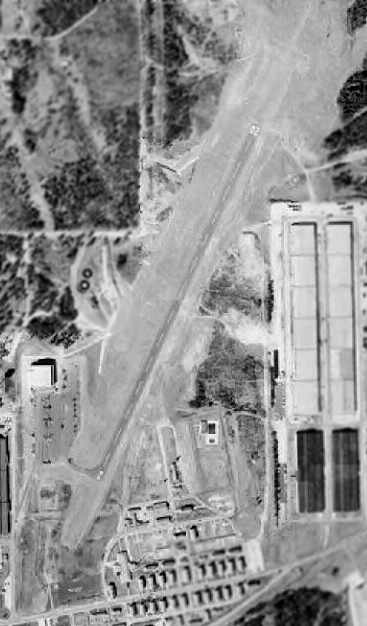
A 1960 USDA aerial photo of Morris AAF (courtesy of David Henderson)
depicted the field as having a single paved Runway 2/20,
with a hangar on the west side of the field.
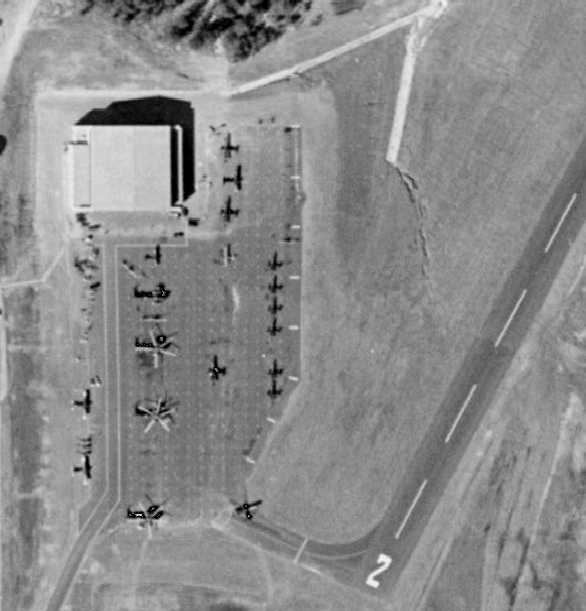
A closeup of the 1960 aerial view depicted a total of 17 aircraft on the ramp at Morris,
including 3 fairly large helicopters with 5-bladed rotors.

The earliest aeronautical chart depiction which has been located of Morris AAF
was on the February 1960 Birmingham Sectional Chart.
It depicted Morris as having a single 2,500' paved northeast/southwest runway.
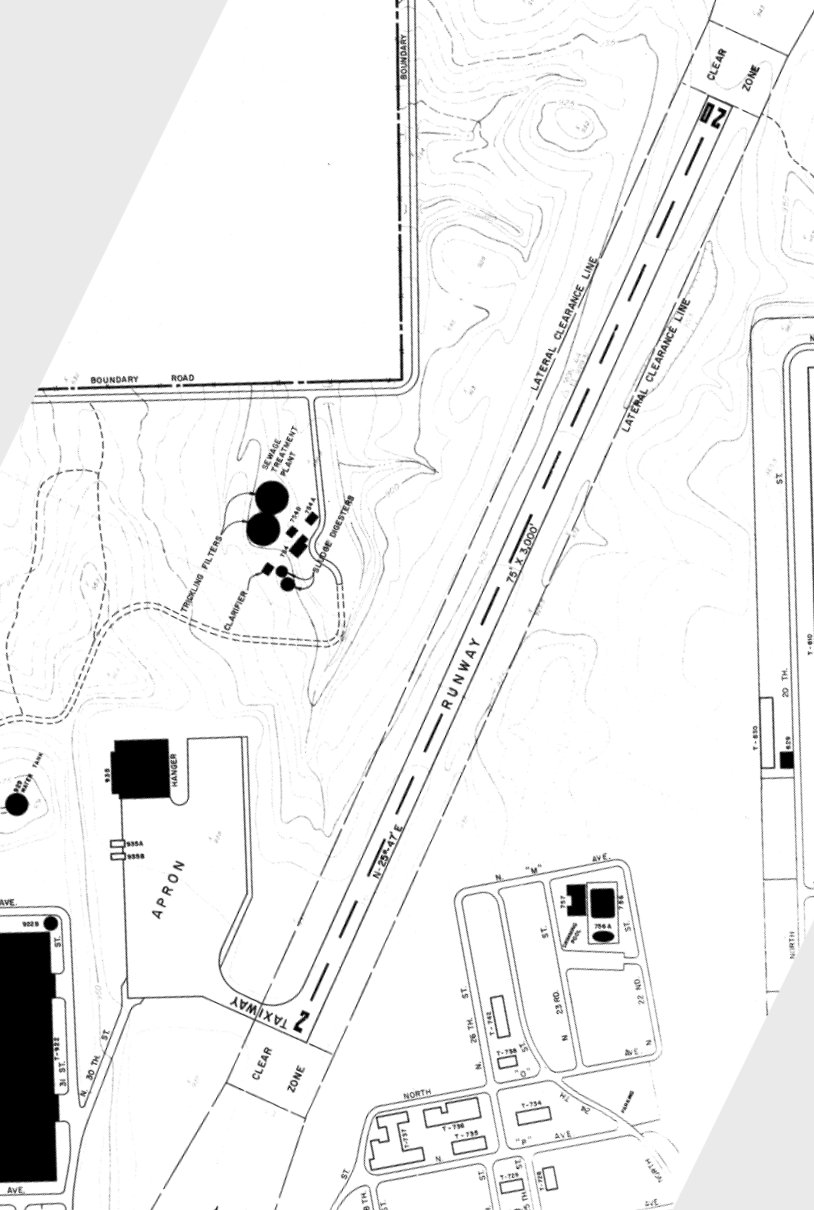
A 9/15/66 Army map (courtesy of Ron Plante) depicted Morris AAF as having a 3,500' runway plus an apron with a hangar & 2 smaller structures."
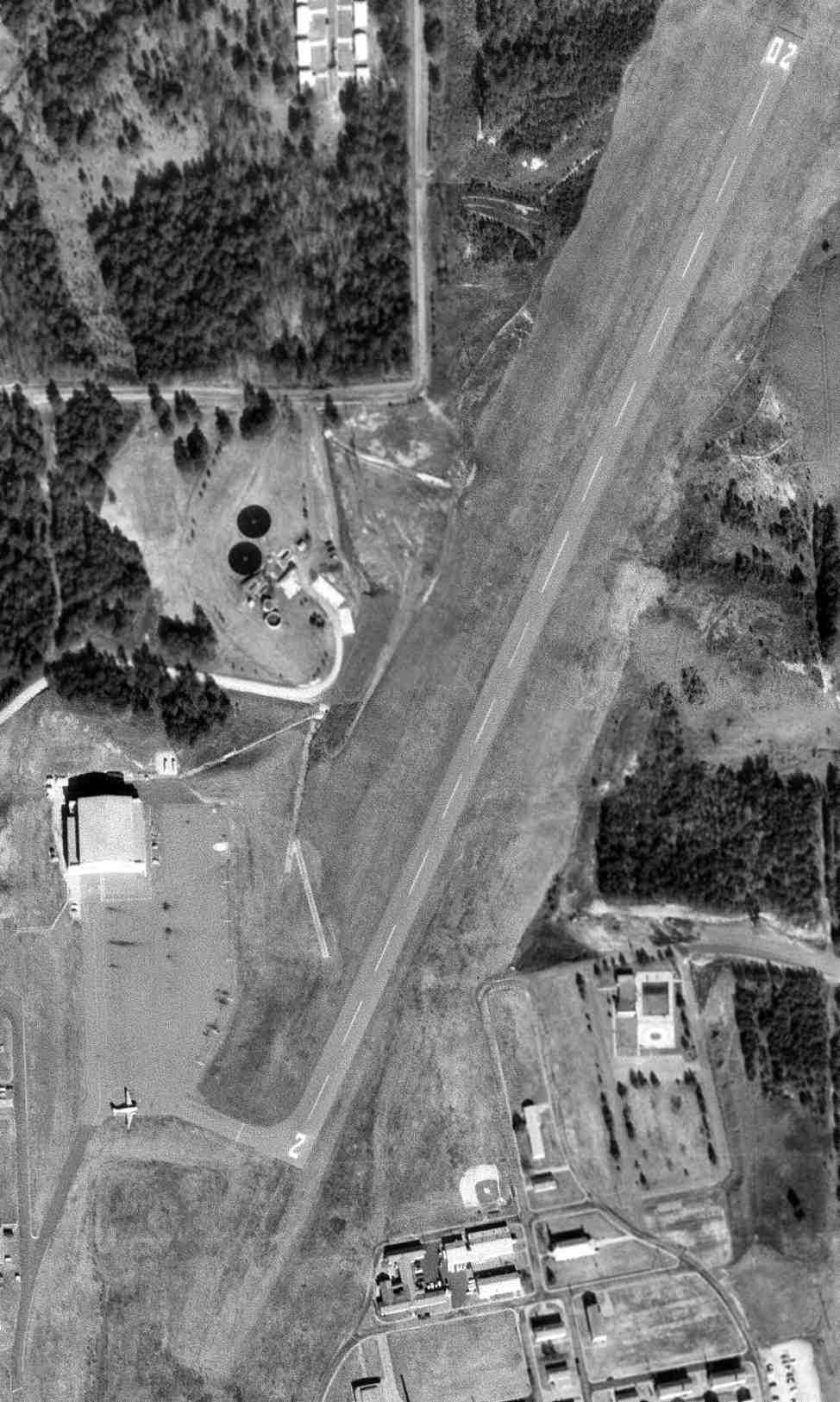
A 1968 USGS aerial view of Morris AAF (courtesy of David Henderson) showed a single C-47 on the ramp.
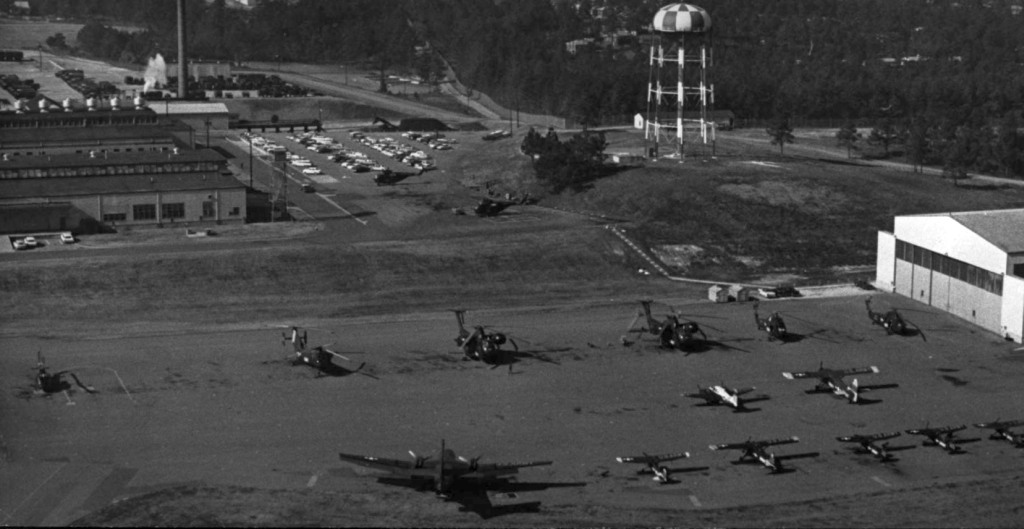
A 12/17/68 aerial view looking west at the ramp of the Atlanta Army Depot's Air Maintenance Division (courtesy of David Henderson),
showing 14 fixed-wing aircraft & helicopters.
The original caption read, “Aerial View of Air Maintenance Division where 10 of 18 different types of Army planes await attention of personnel.
Planes of the National Guard & Reserve of this region as well as those of Puerto Rican National Guard serviced here.”
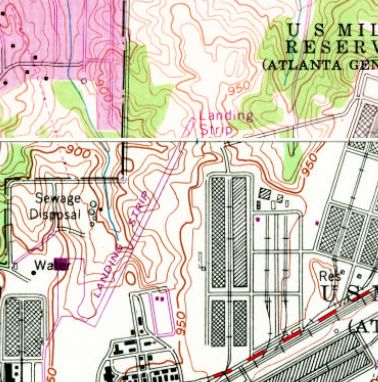
The 1968 USGS topo map depicted Morris AAF as a northeast/southwest runway labeled simply as “Landing Strip”.
Morris AAF was depicted as an active airfield on the 1971 Sectional Chart (courtesy of Robert Brown),
which described the field as having a single 3,000' paved runway.
A 1972 aerial photo showed 11 aircraft & 3 fixed-wing aircraft on the Morris AAF ramp.
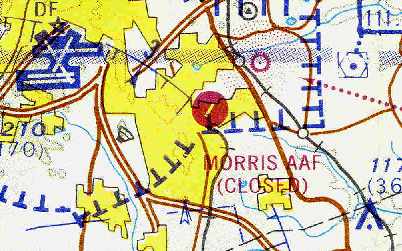
Morris AAF was evidently closed at some point between 1972-74,
as it was labeled "Closed" on the April 1974 Atlanta Sectional Chart (courtesy of Chris Kennedy).
The closure of this airfield was no doubt ensured by its location,
a mere 4 miles east of what has become one of the world's busiest airports, Atlanta's Hartsfield International.
Thomas Houston said, "After the airfield was closed, they used the runways to store mobilization trailers.
There were inklings that FAA didn't want the airfield there before we finished it.
The mission was moved to Lawson Field at Fort Benning."

Morris AAF was still depicted but labeled "Closed" on the 1978 Atlanta Sectional Chart (courtesy of David Henderson).
Edward Shelton recalled, “Back in 1987, I was involved in a major furniture installation project at Ft. McPherson.
The product had to be shipped to & stored at Ft. Gillem in Forest Park, just to the east of Hartsfield.
I was there every day for several weeks. As you entered the base, you could see the airfield on the left.
It was obvious it was no longer in use as there were several trailers & other equipment parked either on the strip or right next to it.
I came to find out later through a friend of mine that did some contract work for FEMA,
that these were trailers used for temporary shelter during national emergencies during floods, hurricanes, tornadoes, etc.
They were old trailers refitted & stored on the airstrip until needed.
Hartsfield Airport underwent a transformation in 1980 which relocated its star-type runways crossing diagonally, to 4 parallel runways running east/west.
This put the Morris AAF right in the landing pattern for air traffic into Hartsfield.
You could stand & watch an almost endless parade of commercial jets fly low over Ft. Gillem in 2 lines, 4-5 planes deep when they landed to the west.”
The 1995 USGS topo map depicted the runway, ramp, and hangar,
labeled “Landing Strip (Abandoned)”.
A 1999 aerial view still showed the hangar remaining on the site.
As seen in the circa 2001 aerial view of the airfield,
it still consisted of a single 3,000' paved runway, along with a ramp & a hangar.
A 2002 aerial view still showed that the hangar had been removed.
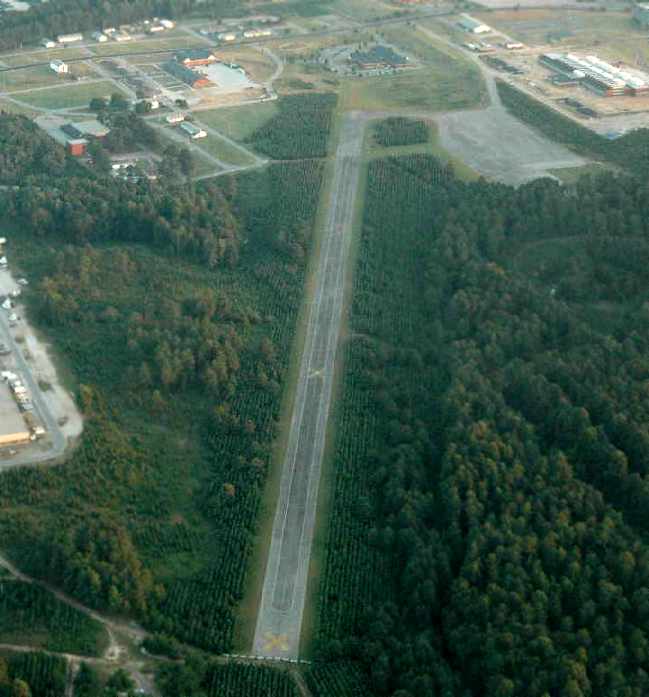
A 2004 photo by Chris Ness, looking southwest at Morris AAF.
Note in comparison to the 2001 aerial photo that the field's hangar has already been removed.
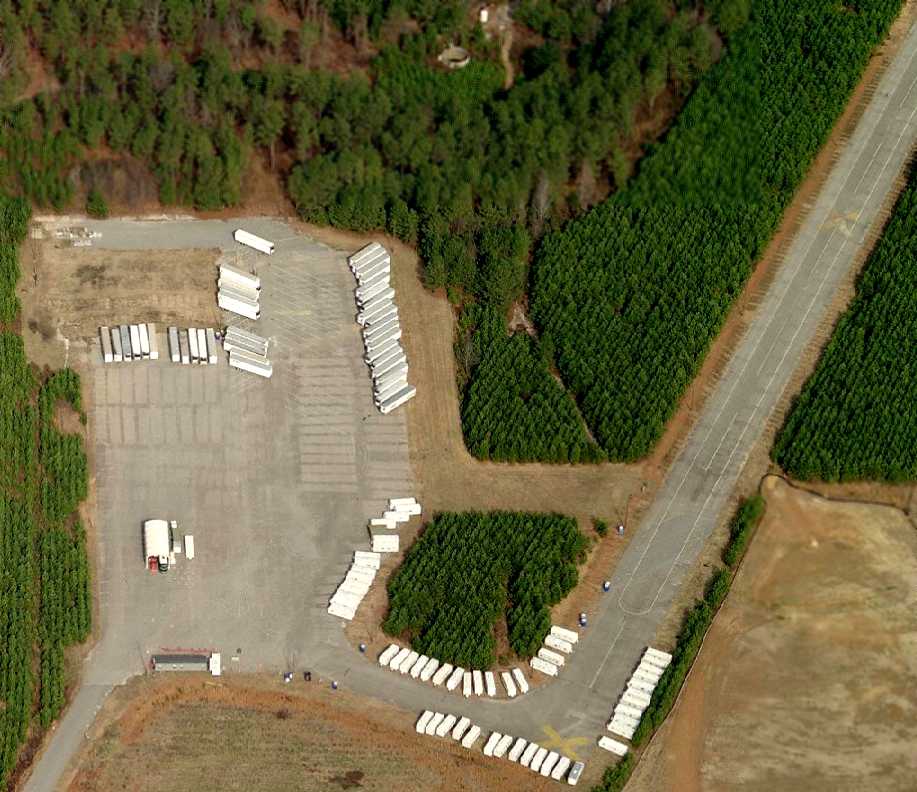
A circa 2007 aerial view looking north at the closed runway at Morris AAF,
the ramp, and the foundation of the hangar.
Brian Fasano reported in 2005, “I flew over it last week, and it was full of RV's & campers.”
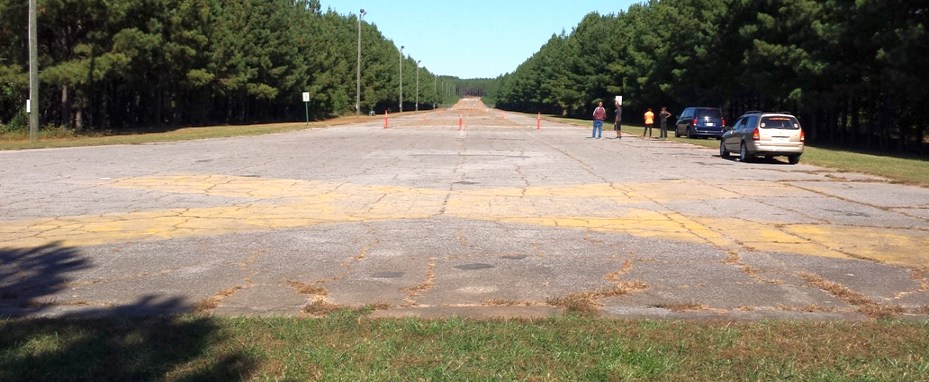
A 11/3/14 photo by Ron Plante looking along the closed runway at Morris AAF.
Ron reported, “Although Ft. Gillem was closed under BRAC,
a small area remains under Army control as the Gillem Enclave with a mix of active duty & reserve component units.
The airstrip is inside this area, and a military ID is required to enter the post.
After a few wrong turns, I found the ramp & then the runway.
The yellow 'X' & '2' markings are still visible, and the runway has been converted into a Physical Training / running area for the soldiers.”
____________________________________________________
Stone Mountain Britt Memorial Airport (00A), Stone Mountain, GA
33.813, -84.12 (East of Atlanta, GA)
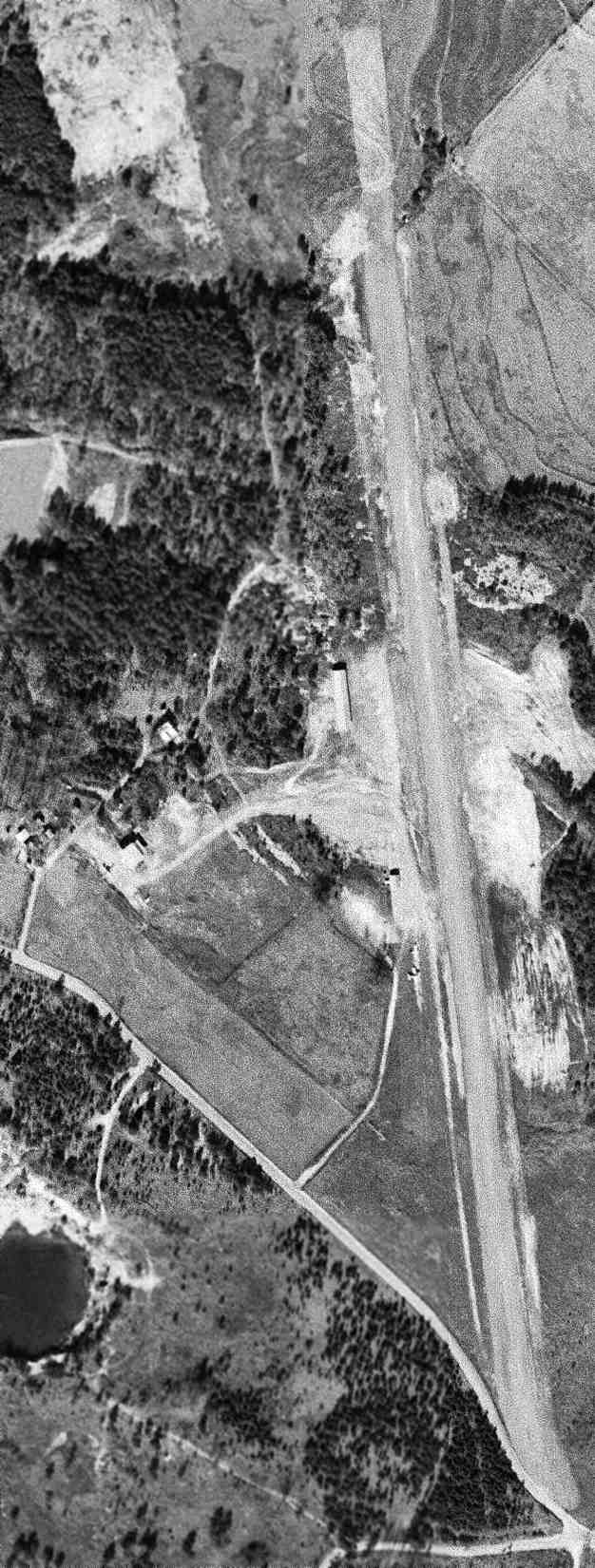
Stone Mountain Airport, as depicted on a 1959 USGS aerial photo (courtesy of David Henderson).
This general aviation airport was not yet depicted on a 1955 aerial photo.
According to the 1966 “Atlanta Metropolitan Region Comprehensive Plan” (courtesy of David Henderson),
“Stone Mountain Airport... was developed in the late 1950's.”
The earliest depiction which has been located of Stone Mountain Airport was a 1959 USGS aerial photo (courtesy of David Henderson).
It depicted Stone Mountain Airport as having a single unpaved northwest/southeast runway,
with a few small hangars & a few light aircraft on the west side.
However, Stone Mountain Airport was not yet depicted on the August 1962 Birmingham Sectional Chart (according to Chris Kennedy).
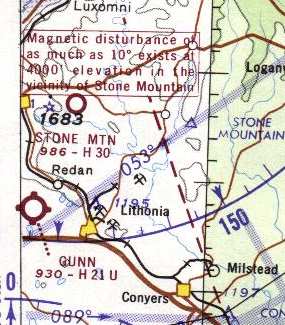
The earliest aeronautical chart depiction of Stone Mountain Airport which has been located
was on the 1964 Savannah Sectional Chart (courtesy of John Voss),
which depicted it with a 3,000' hard-surfaced runway.
Doug Rounds recalled, “Stone Mountain Airport... In the mid-1960s I was president of a group that leased the airport from Mark Britt.
There was a 2nd grass/sand runway running along Bermuda Road - you can see where it was by the sand - it began at the south end of the paved runway.
At that time the Stone Mountain golf course was being built & other than that the airport was in the country.
There were a number of Stearmans & a 1929 & 1930s Stinsons based there at the time.”
According to the 1966 “Atlanta Metropolitan Region Comprehensive Plan” (courtesy of David Henderson),
“Low intensity runway lights were programed to be installed in 1965.
These aircraft were reported based at the field in 1965: single-engine, 1-3 places (5); single-engine, 4 or more places (9).”
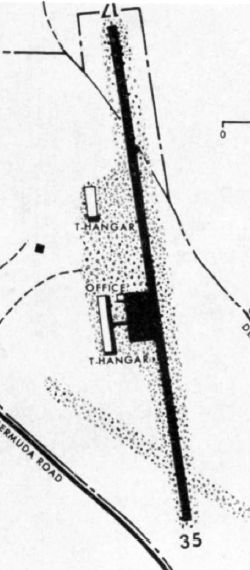
The 1966 “Atlanta Metropolitan Region Comprehensive Plan” (courtesy of David Henderson)
depicted Stone Mountain Airport as having a single Runway 17/35, with an office & T-hangars on the west side.
According to the 1966 “Atlanta Metropolitan Region Comprehensive Plan” (courtesy of David Henderson),
“Access to the field is provided by Bermuda Road, an unpaved rural road leading from a portion of old U.S. Highway 78
(which has been diverted to pass north of Stone Mountain Memorial Park).
The single runway is paved, in good condition (as are the taxiway & apron) and is 2,500' long with a width of 40';
it cannot be extended within existing property limits.
The airport is attended during daylight hours.
Aviation fuel is stored in underground tanks with a capacity of 4,000 gallons.
The following facilities & services are also available: Major & minor repairs to power plant, airframe, radio,
Aircraft services: painting, stripping, washing, Aircraft storage: T-hangar 18 spaces, tie-down 50 spaces,
Sales of new & used aircraft, accessories, radios & instruments, Aircraft available for charter – 2, rental – 3, sightseeing – 2,
Flight instruction for all airplane flying ratings: Instructors – 2, Aircraft – 2.”
Travis Britt recalled, “I was raised at the Stone Mountain Britt Memorial Airport (no relation to the name).
My earliest memory of Stone Mountain Airport was as a small child.
My father, Benny, was a sky diver and used to jump there.
This would probably have been somewhere around 1967 or 68 that I first remember being at Stone Mountain Airport.
He then restored a PT-19 at Stone Mountain Airport which he completed in 1969.
From that time, I was at the airport almost every day.
Stone Mountain Airport is a place that is very dear to my heart.
The reason that it was called Stone Mountain Britt Memorial Airport was to honor the memory of Mamie Britt.
She was the wife of the founder of the airport Mark Britt.”
The 1968 Flight Guide (courtesy of Robert Levittan) depicted Stone Mountain Airport
as having a single 2,500' paved Runway 17/35.
A parallel taxiway on the west side of the runway led to a ramp & 2 buildings.
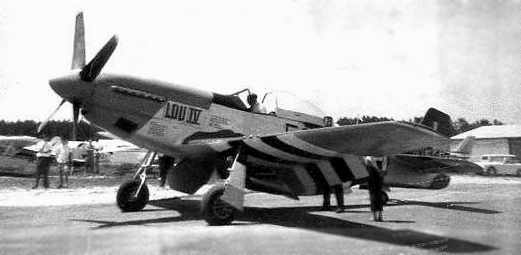
A circa late 1960s photo by Robert Brown of Dave Forrest in his P-51D Mustang passing through Stone Mountain Airport,
pictured near the gas pumps.
Dave Forrest recalled, “I also landed there in a FG-1D Corsair.”
According to a 1969 article (courtesy of Robert Brown),
a corporation was formed on 4/1/67 to lease Stone Mountain Airport for 20 years with an option to buy.
The purpose of the new operation: “For the enhancement & advancement of tail-draggers.”
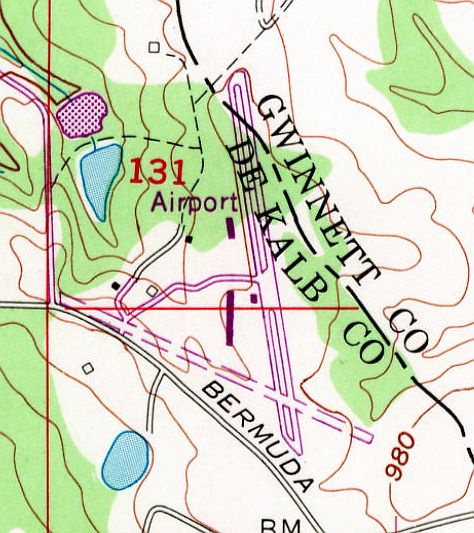
The 1968 USGS topo map depicted Stone Mountain “Airport”
as having a paved NNW/SSE runway with a parallel taxiway, and an unpaved WNW/ESE crosswind runway.
According to a 1969 article (courtesy of Robert Brown), Stone Mountain Airport was described
as having a “narrow, dipping 2,600' hard-surfaced runway faced by a string of high tension wires at one end,
while the world's largest & hardest Omni [Stone Mountain] juts up on one side.”
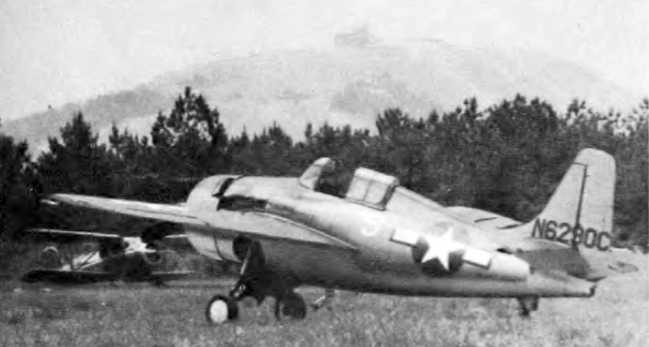
An undated photo from a 1969 article (courtesy of Robert Brown)
showing Mike Rettke's rare flyable FM-2 Wildcat fighter, with Stone Mountain looming in the background.
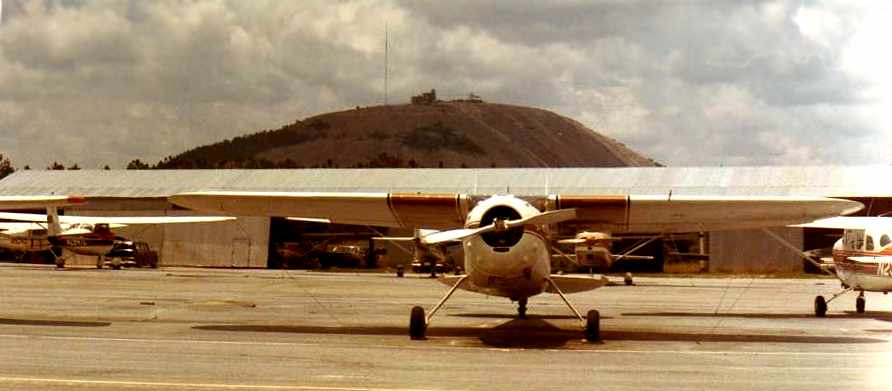
A 1971 photo by Robert Brown of a Cessna 195, N195RE, at Stone Mountain Airport.
Robert remarked, “No prize for guessing how the airport got it's name.”
Edward Shelton recalled, “As early as I can remember, we would go to Stone Mountain & climb to the top.
From there you could see the glider tugs taking off from SMBM so the gliders could float around the mountain for awhile.”
The 1982 AOPA Airport Directory (courtesy of Ed Drury)
listed the operator as Stone Mountain Aviation Inc.
According to Travis Britt, airport owner Mark Britt “owned the property until the mid 1980s
when he sold it to a partnership that was trying to save the airport from its eventual demise.
Until this time the airport was always known as Stone Mountain Airport.
Stone Mountain Aviation was the Fixed Base Operator that operated the airport under a lease agreement with Mark.”
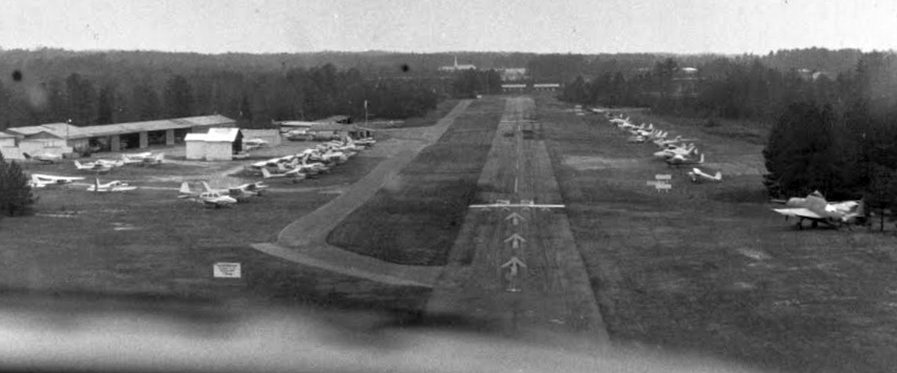
Note the WW2 surplus Grumman TBM Avenger torpedo bomber at far right.
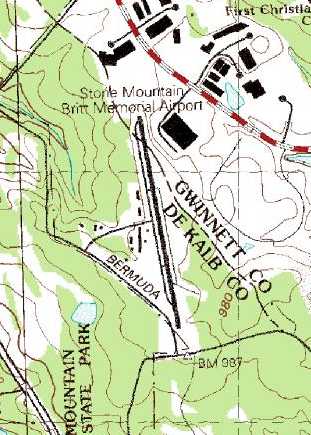
The 1992 USGS topo map depicted Stone Mountain Britt Memorial Airport
as having a runway, parallel taxiway, and several small buildings on the west side.
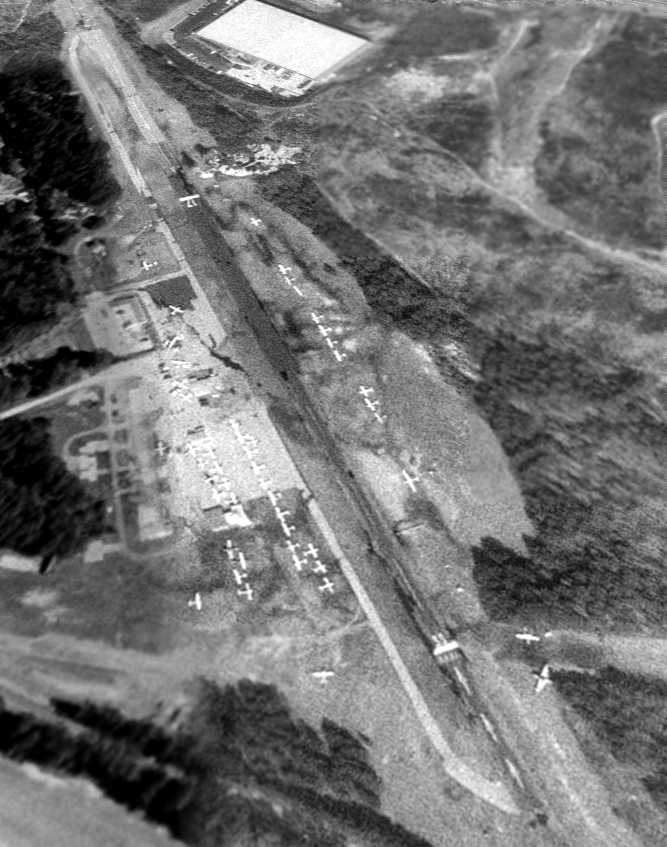
A January 25, 1993 USGS aerial view looking northeast at Stone Mountain Airport
showed a total of 52 aircraft visible parked outside on the field – obviously a well-used airport.
The field consisted of a single paved 2,700' runway, a crosswind grass runway,
taxiways, a ramp & several hangars.
Edward Shelton recalled, “There is a white-roofed building right at the northeast end of the runway.
This is an industrial HVAC equipment manufacturer called Heatcraft.
It was always a little startling to be in their parking lot & seeing a light plane come over the tree line (only barely sometimes) just after takeoff.
The trees masked the sound of the engine until the plane was visible so its arrival was quite a surprise.
The only time I went to the airport itself was the early 1990s.
It had fallen out of use, but there were still a few planes there.
In one of the hangars somebody was trying to restore a Dauntless.”
Miranda Skonie recalled of Stone Mountain Airport, “I had my first lesson on New Year's Day 1994, I was 17 years old.
I soloed on March 26, 1994. I began working for the FBO in February of that year.
I scheduled the planes, instructors, fueled airplanes, and pretty much whatever needed to be done.
I have very fond memories of the airport & the people that used to hang out there.
I heard so many stories and many of them several times.
I was very sad when the airport did not open back up after the Olympics.
I had hoped to take my kids there someday.”
Stone Mountain Airport was closed in 1996,
when it was converted into a parking lot
for the tennis & aquatic Olympic events being held at the adjacent Stone Mountain Park.
After the games, the airport owners decided that it would be too costly to reopen the airport,
and the airport site was reused as a parking lot for the Tennis Center.
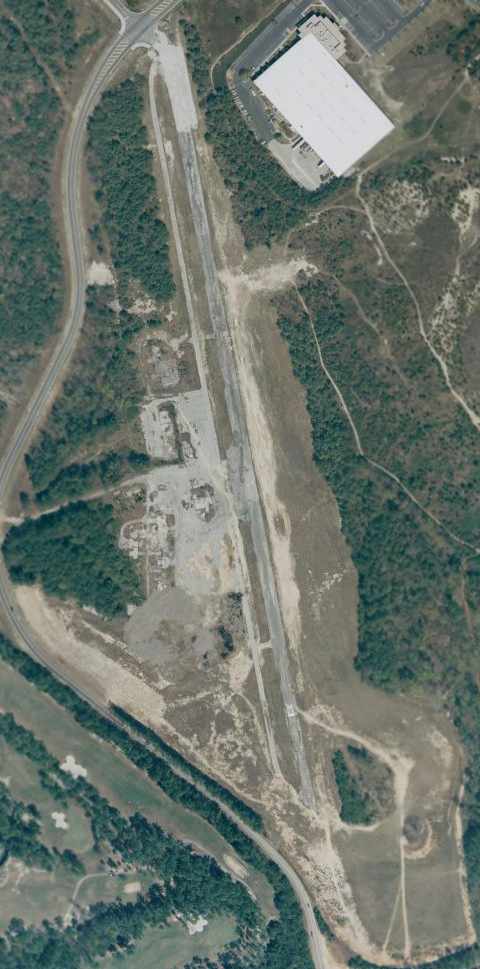
As seen in the 2002 USGS aerial photo,
all of the former airport buildings had been removed,
although the paved runway & taxiway still remained intact.
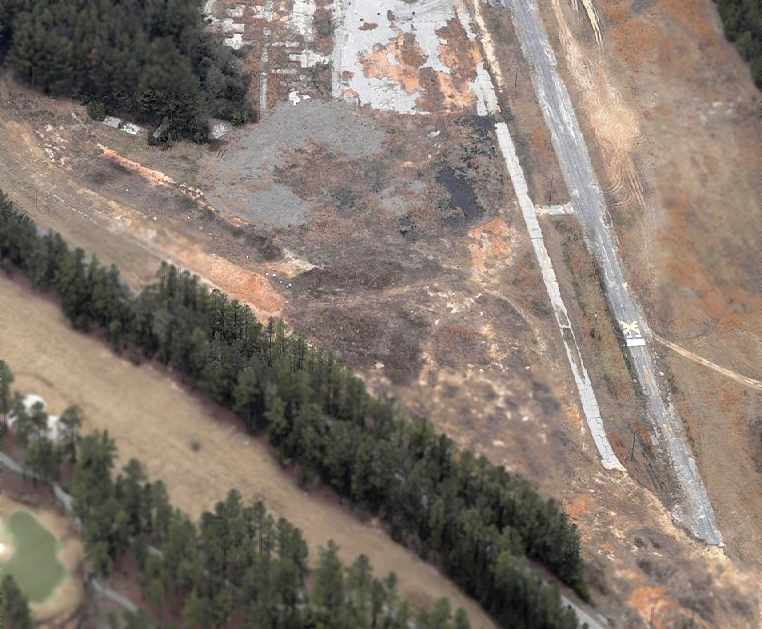
A circa 2002-2005 aerial photo looking north at the south end of the former Runway 35,
with the runway markings still visible (although X'd out).
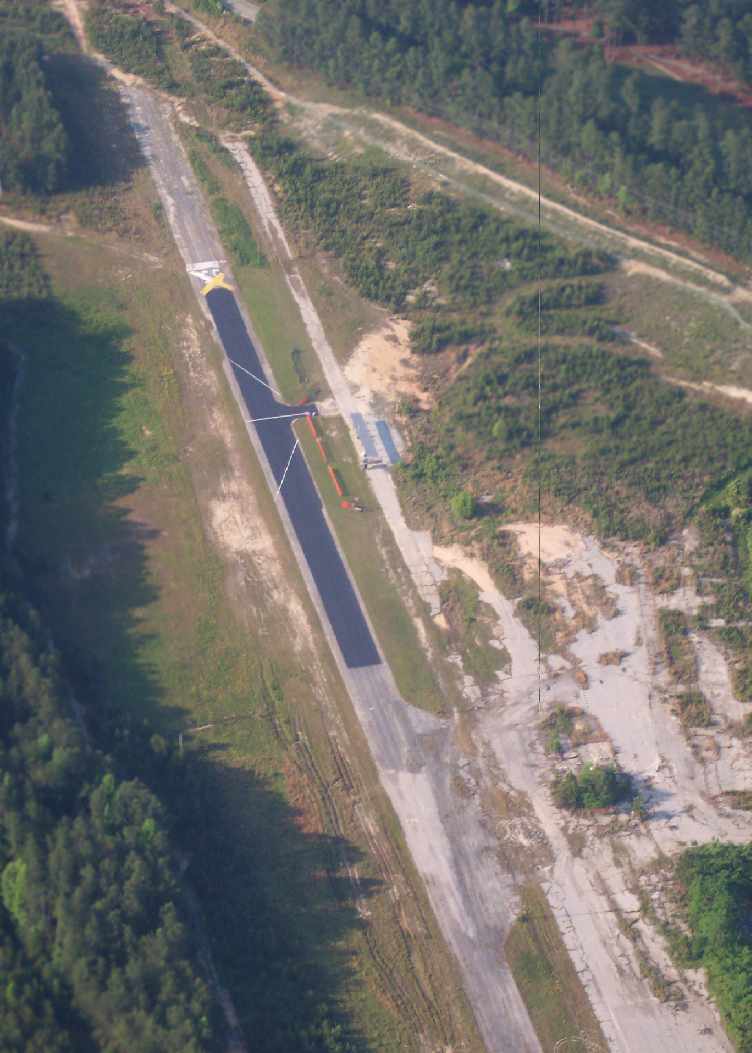
A 2006 aerial view looking south at the south end of the former runway at Stone Mountain, by Graham Watkins.
A small portion of the former runway has been newly repaved,
and a small shelter has been constructed on the former taxiway.
Joerg Wekenborg reported in 2006, “The repaved portion of Stone Mountain Airport's runway
is now home of the Stone Mountain Flyers, a radio-control club flying mostly fixed-wing airplanes.”
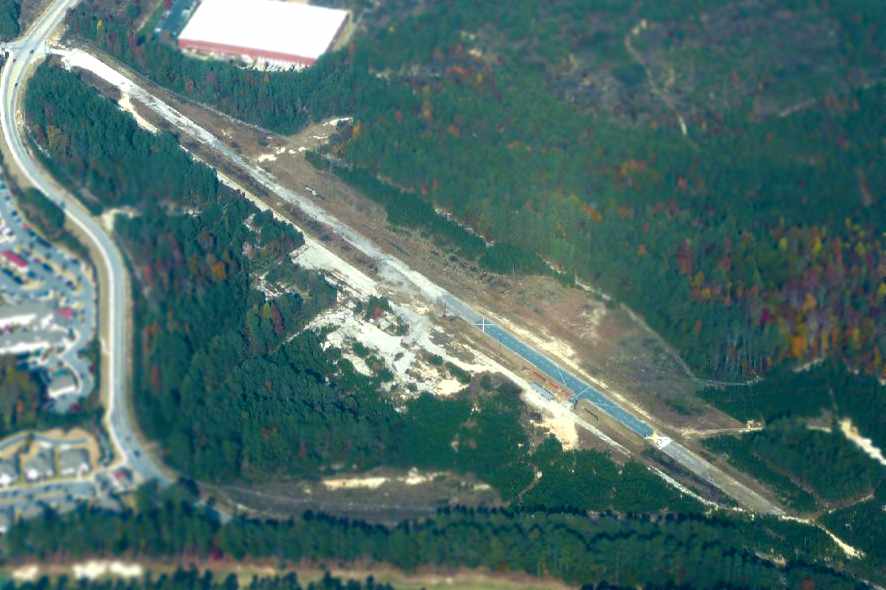
A 2007 aerial view by Robert Morris looking northeast at the remains of the Stone Mountain runway.
A perfectly good general aviation airport, completely going to waste.
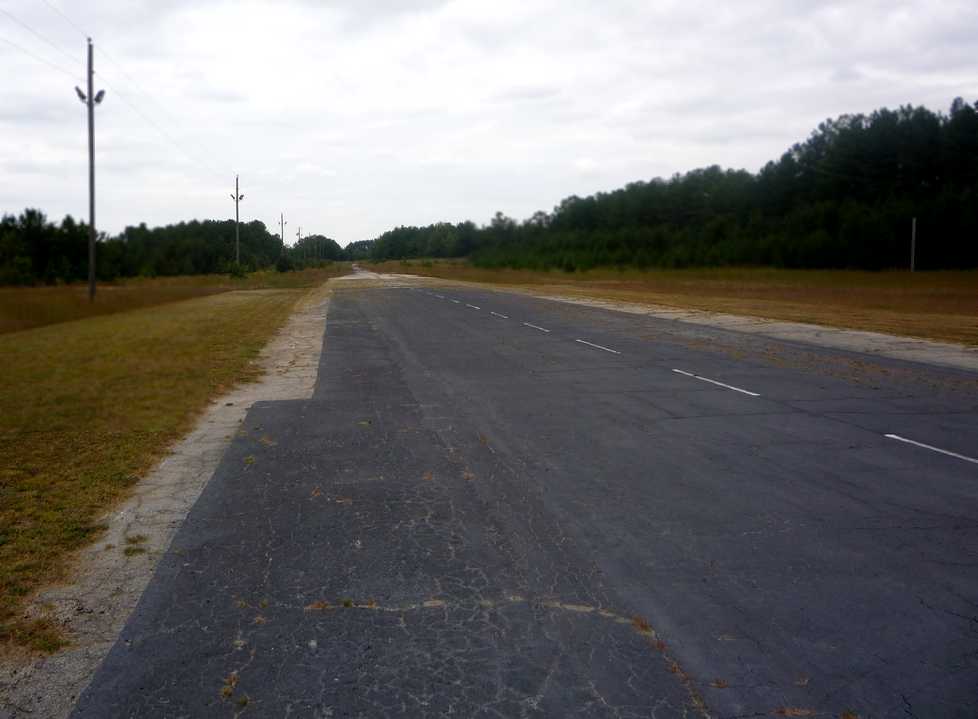
A 2008 photo of the portion of the Stone Mountain runway reused by a model aircraft club.
Thanks to Paulo Santos for information about Stone Mountain.
____________________________________________________
Since this site was first put on the web in 1999, its popularity has grown tremendously.
That has caused it to often exceed bandwidth limitations
set by the company which I pay to host it on the web.
If the total quantity of material on this site is to continue to grow,
it will require ever-increasing funding to pay its expenses.
Therefore, I request financial contributions from site visitors,
to help defray the increasing costs of the site
and ensure that it continues to be available & to grow.
What would you pay for a good aviation magazine, or a good aviation book?
Please consider a donation of an equivalent amount, at the least.
This site is not supported by commercial advertising –
it is purely supported by donations.
If you enjoy the site, and would like to make a financial contribution,
you
may use a credit card via
![]() ,
using one of 2 methods:
,
using one of 2 methods:
To make a one-time donation of an amount of your choice:
Or you can sign up for a $10 monthly subscription to help support the site on an ongoing basis:
Or if you prefer to contact me directly concerning a contribution (for a mailing address to send a check),
please contact me at: paulandterryfreeman@gmail.com
If you enjoy this web site, please support it with a financial contribution.
please contact me at: paulandterryfreeman@gmail.com
If you enjoy this web site, please support it with a financial contribution.
____________________________________________________
This site covers airfields in all 50 states.